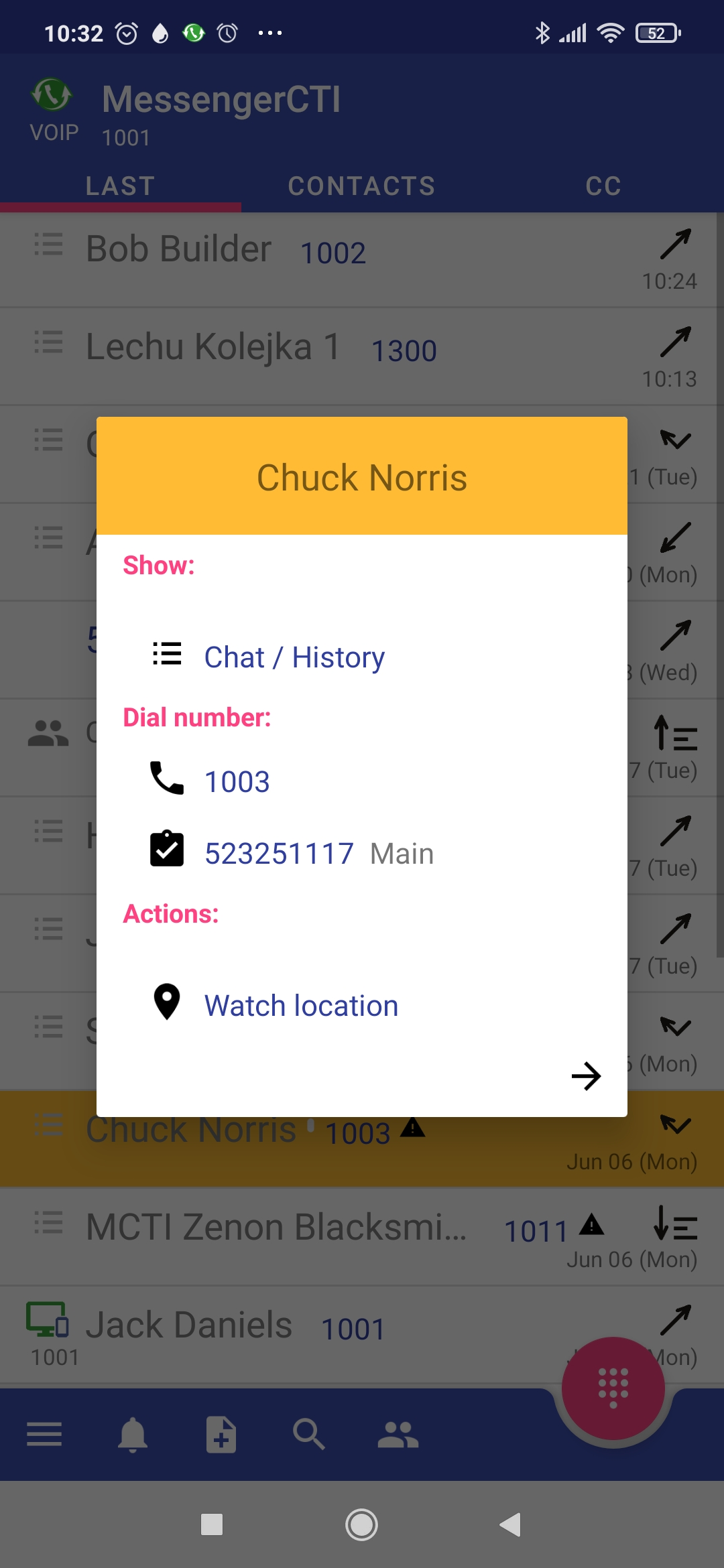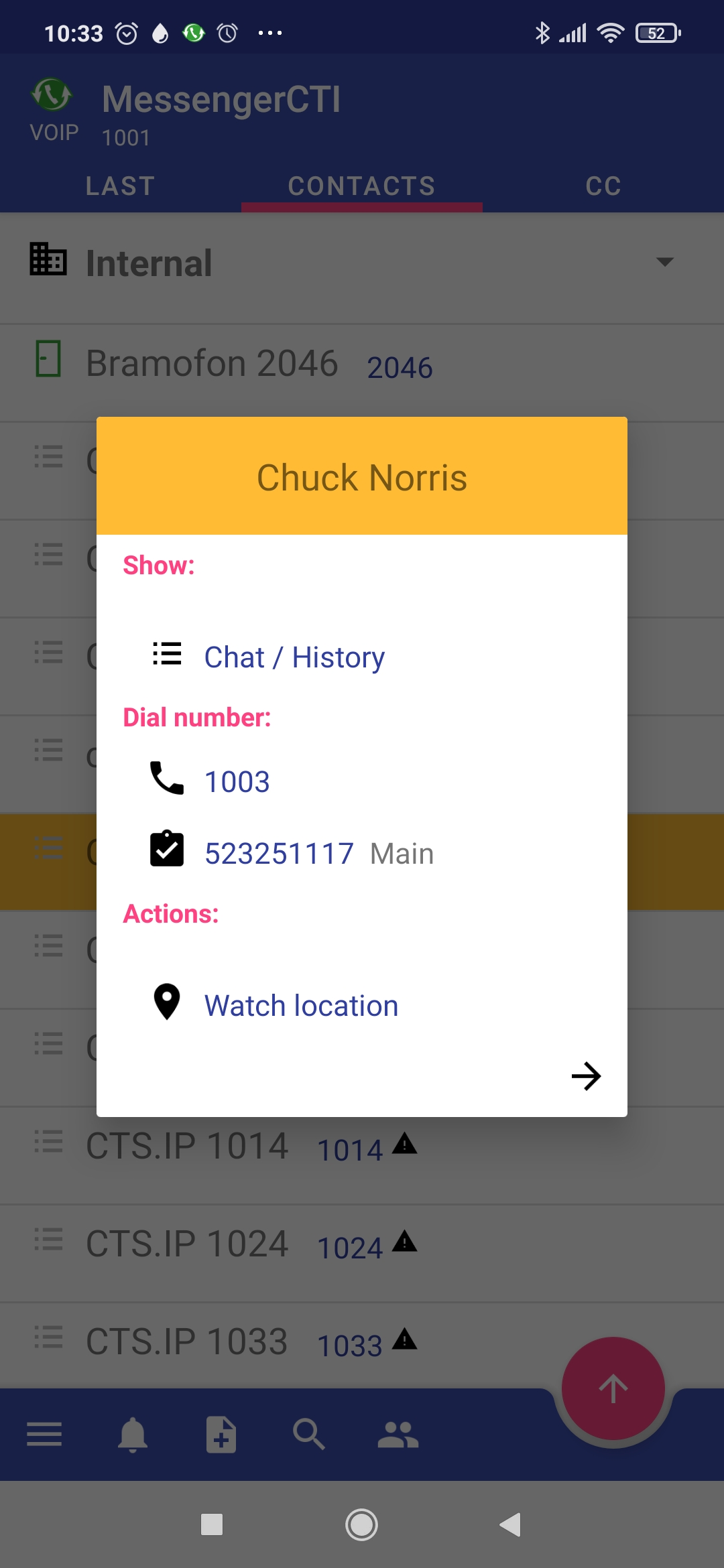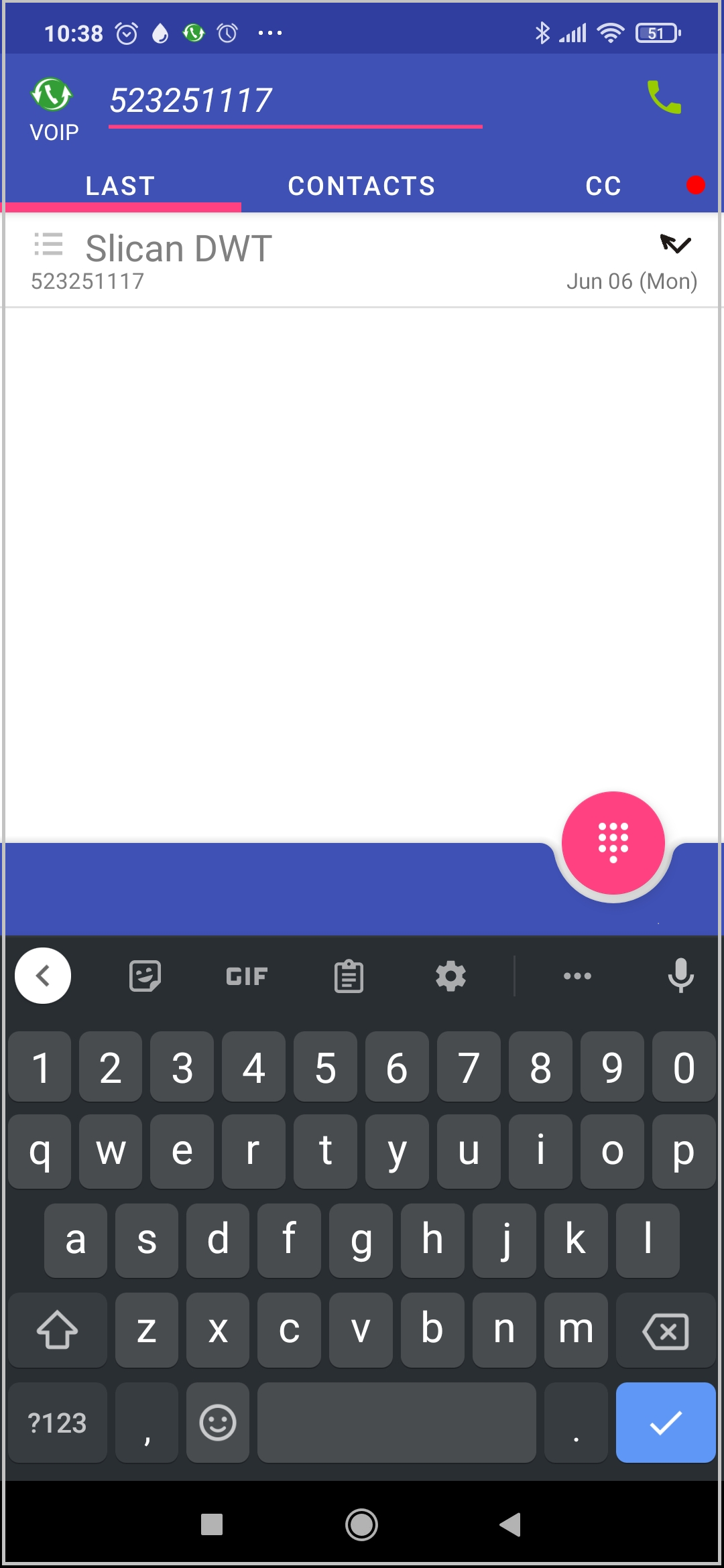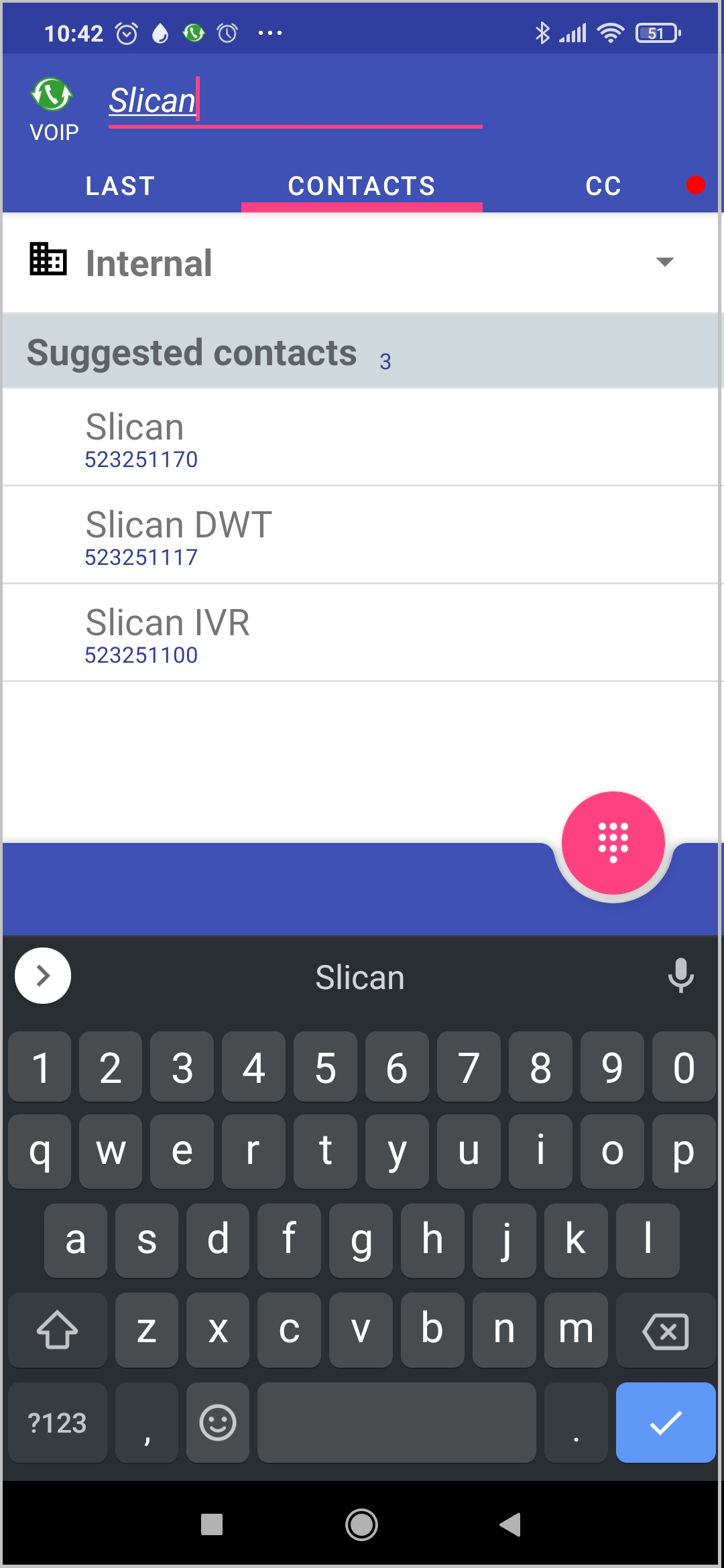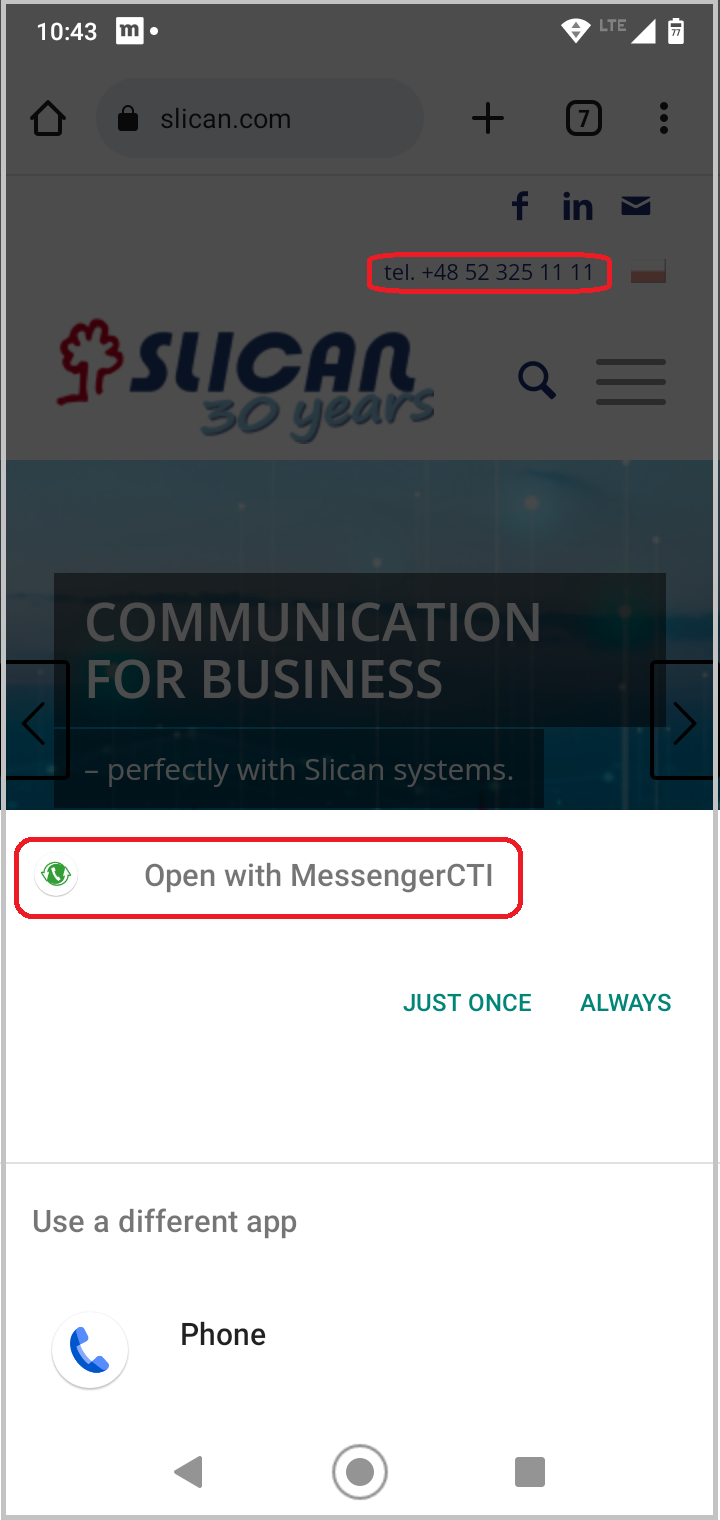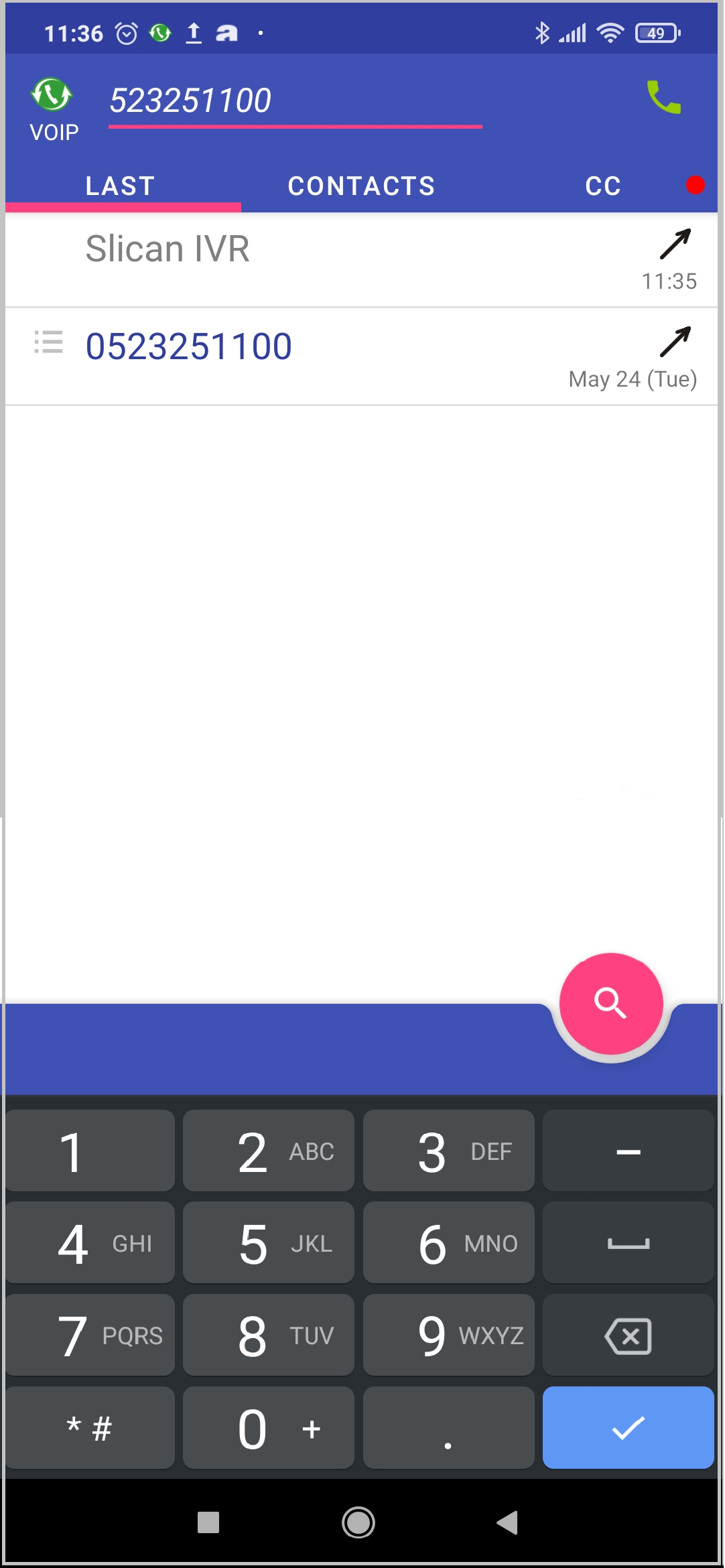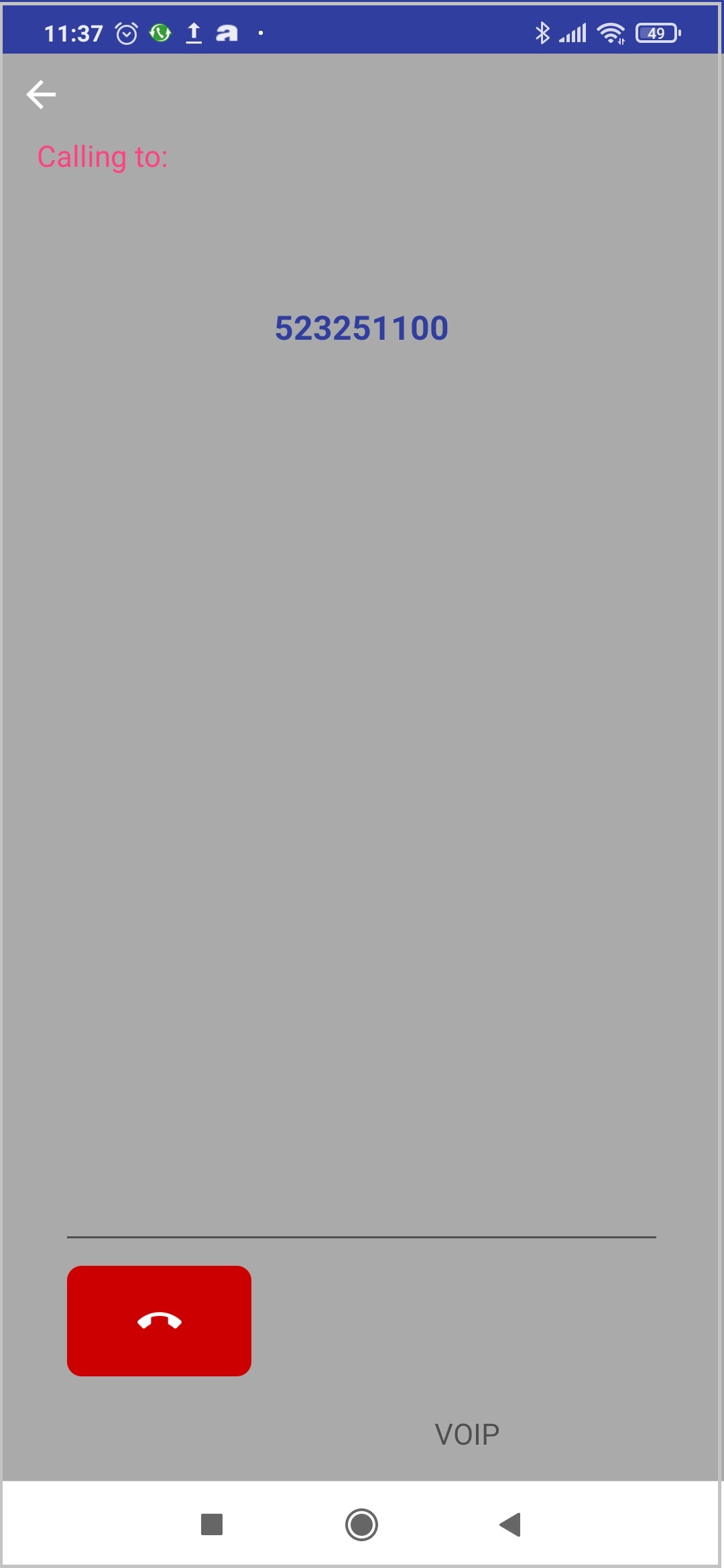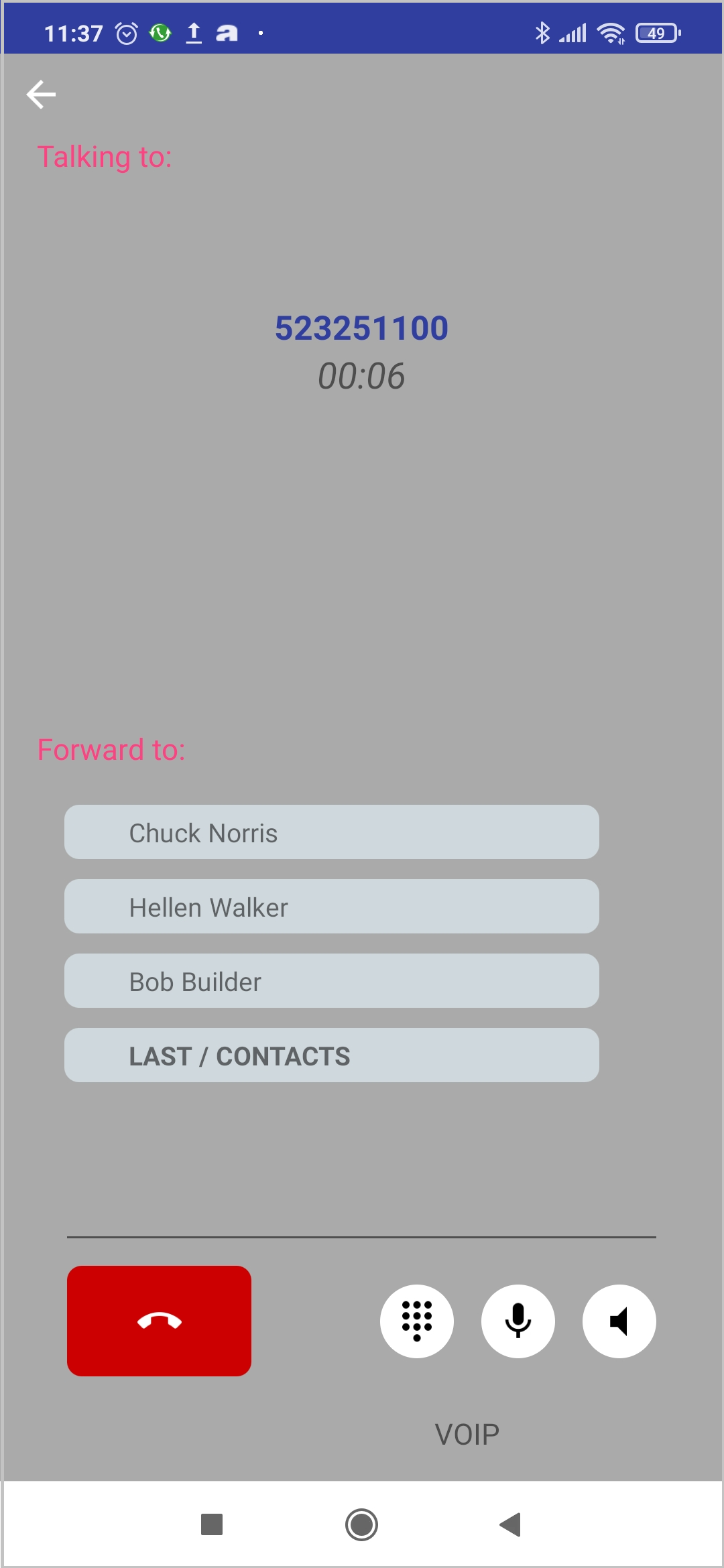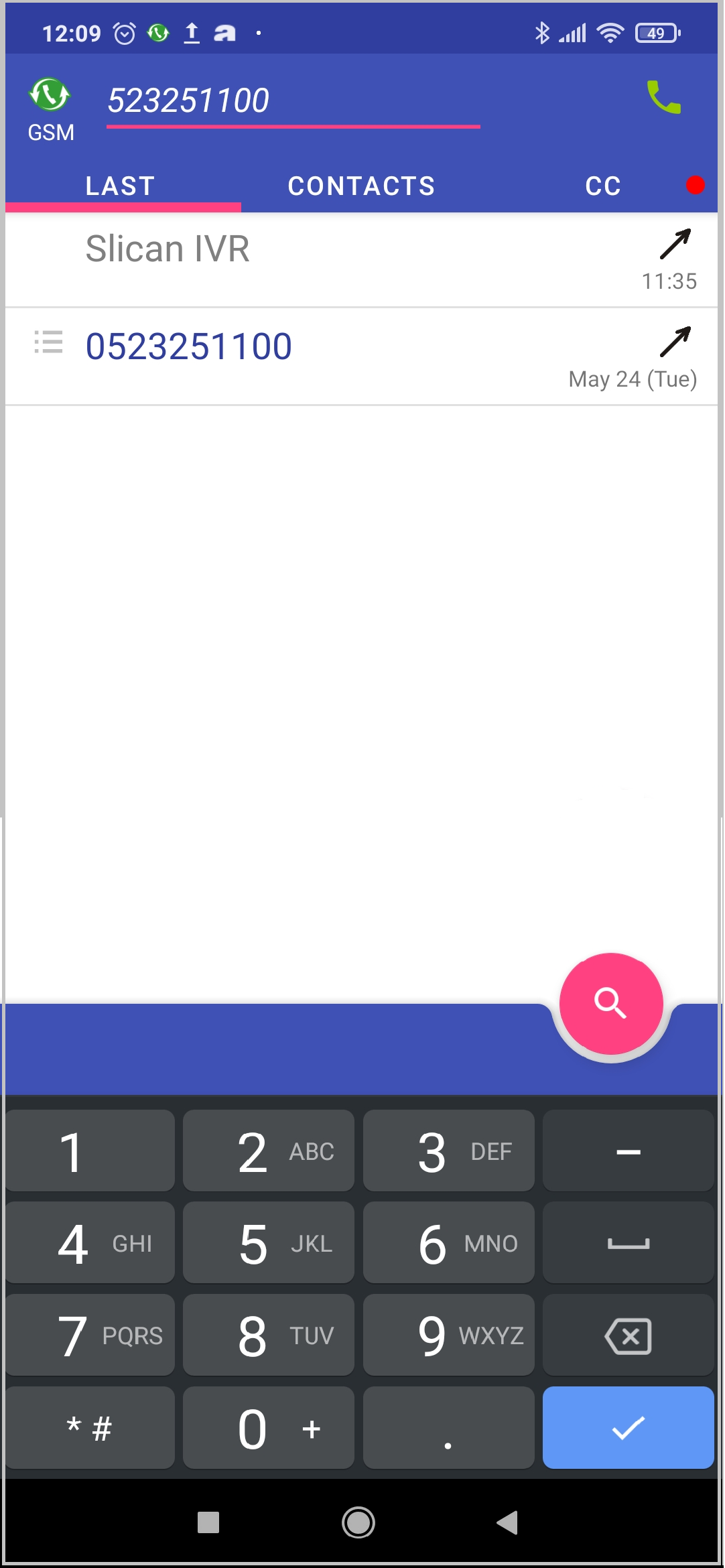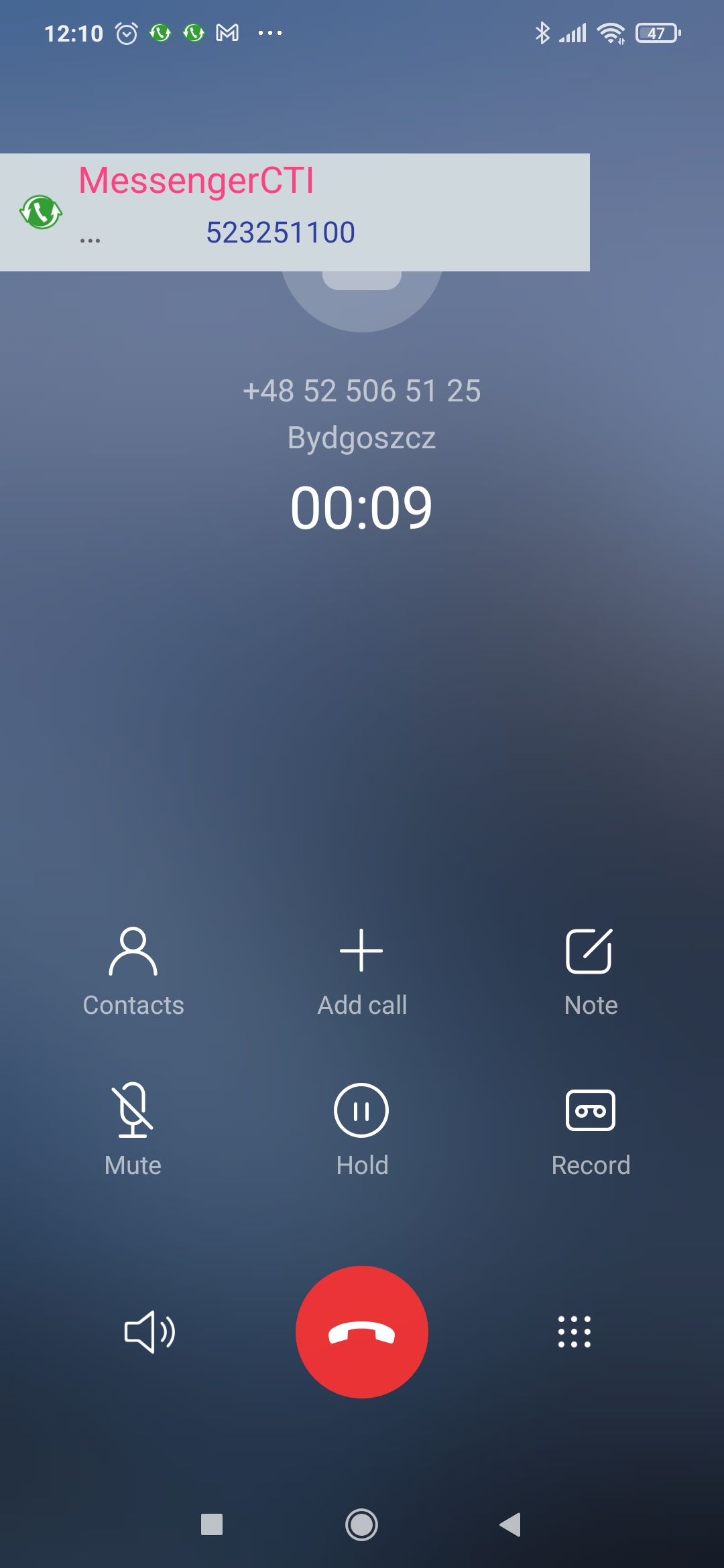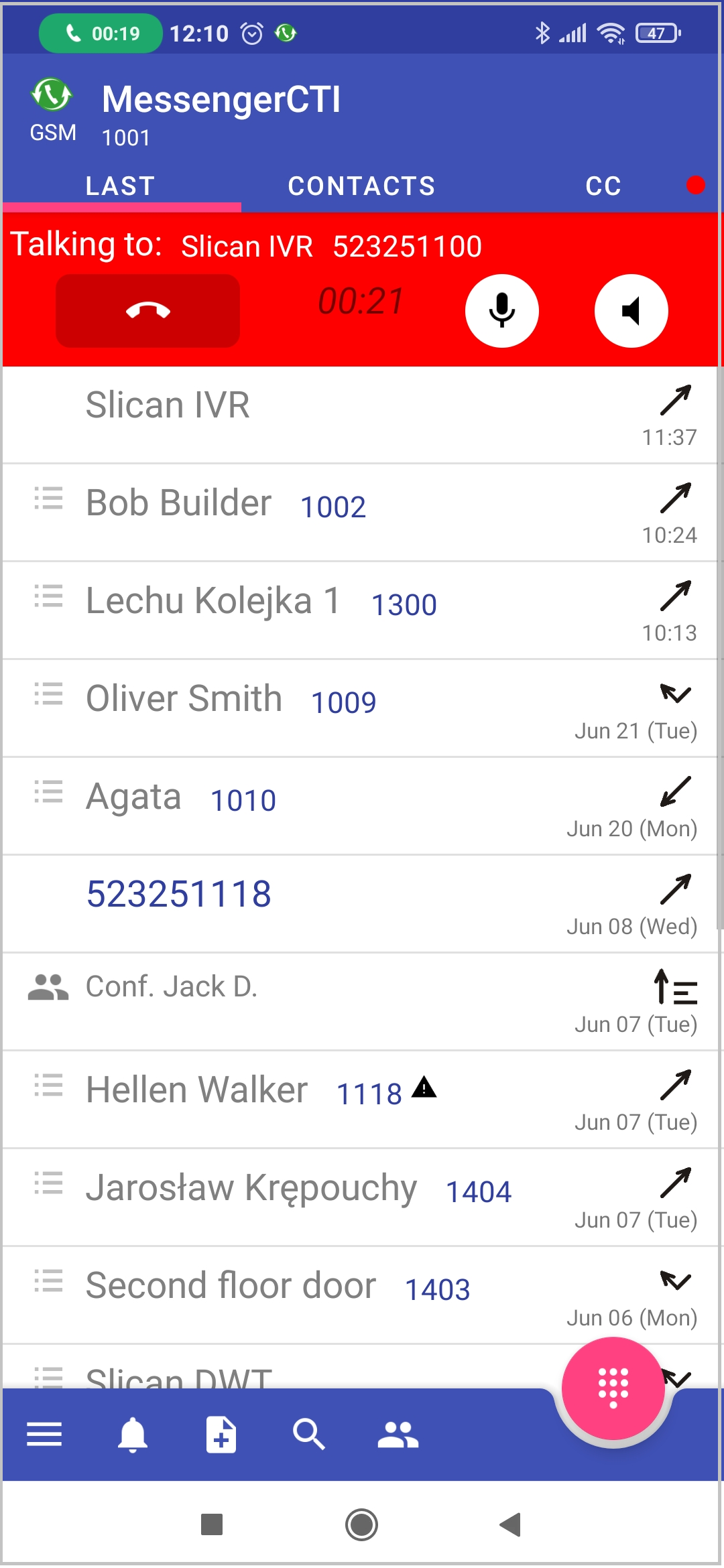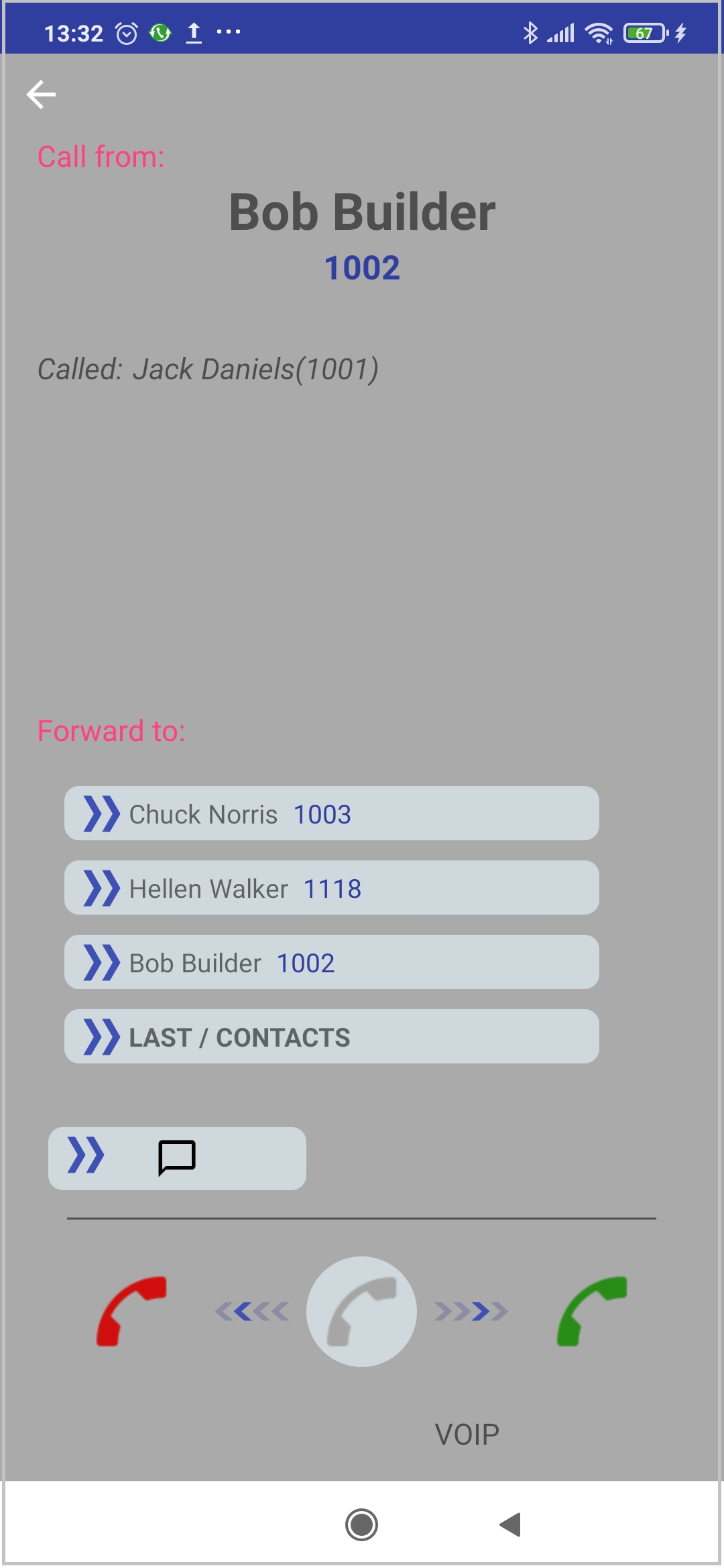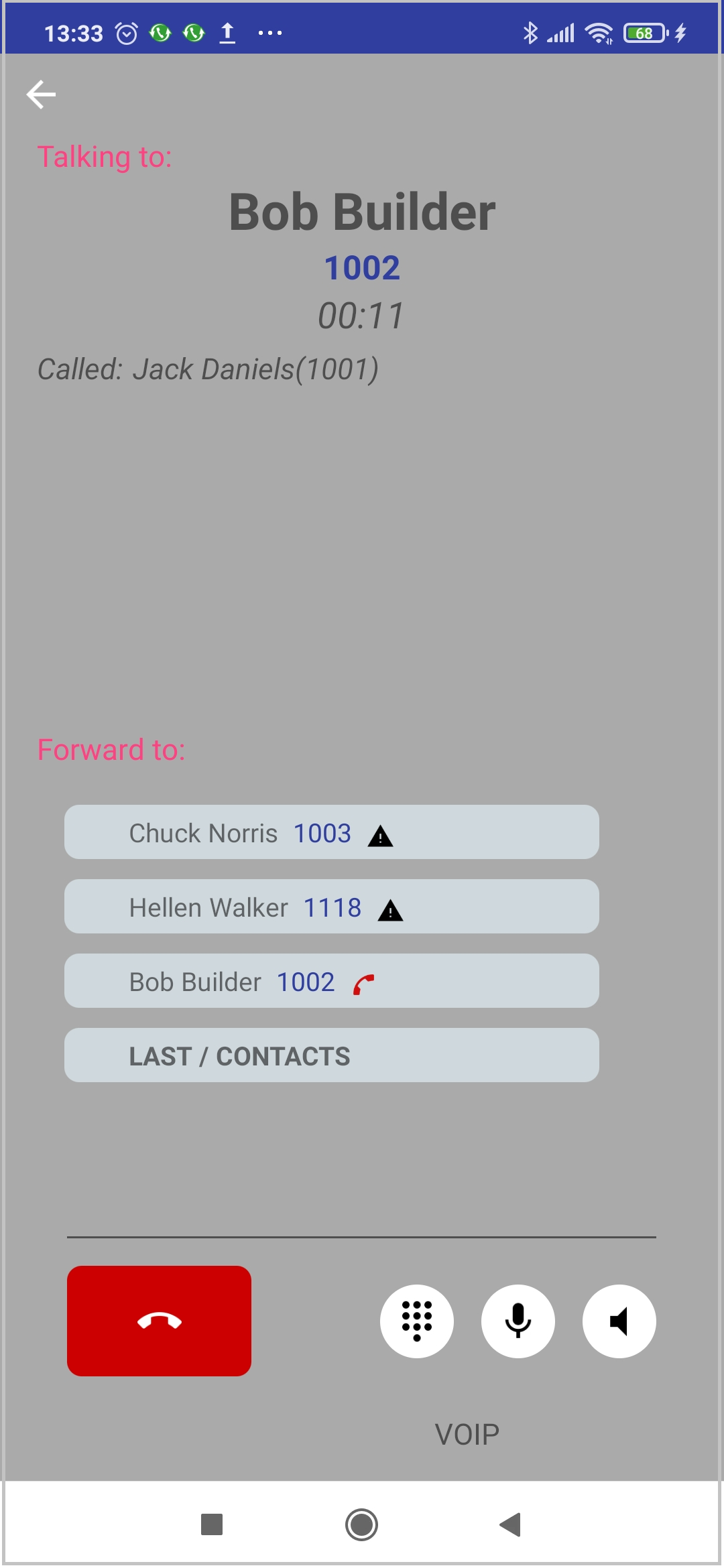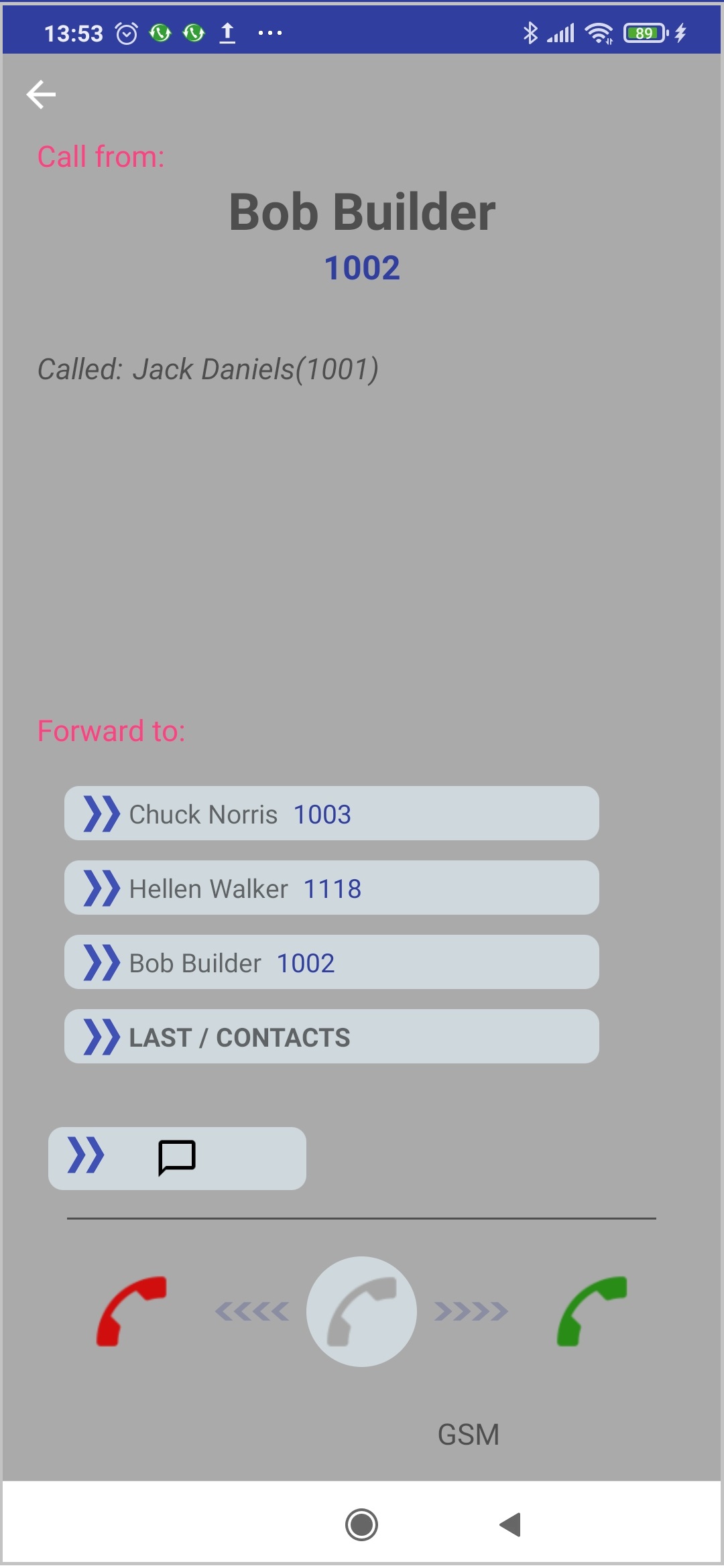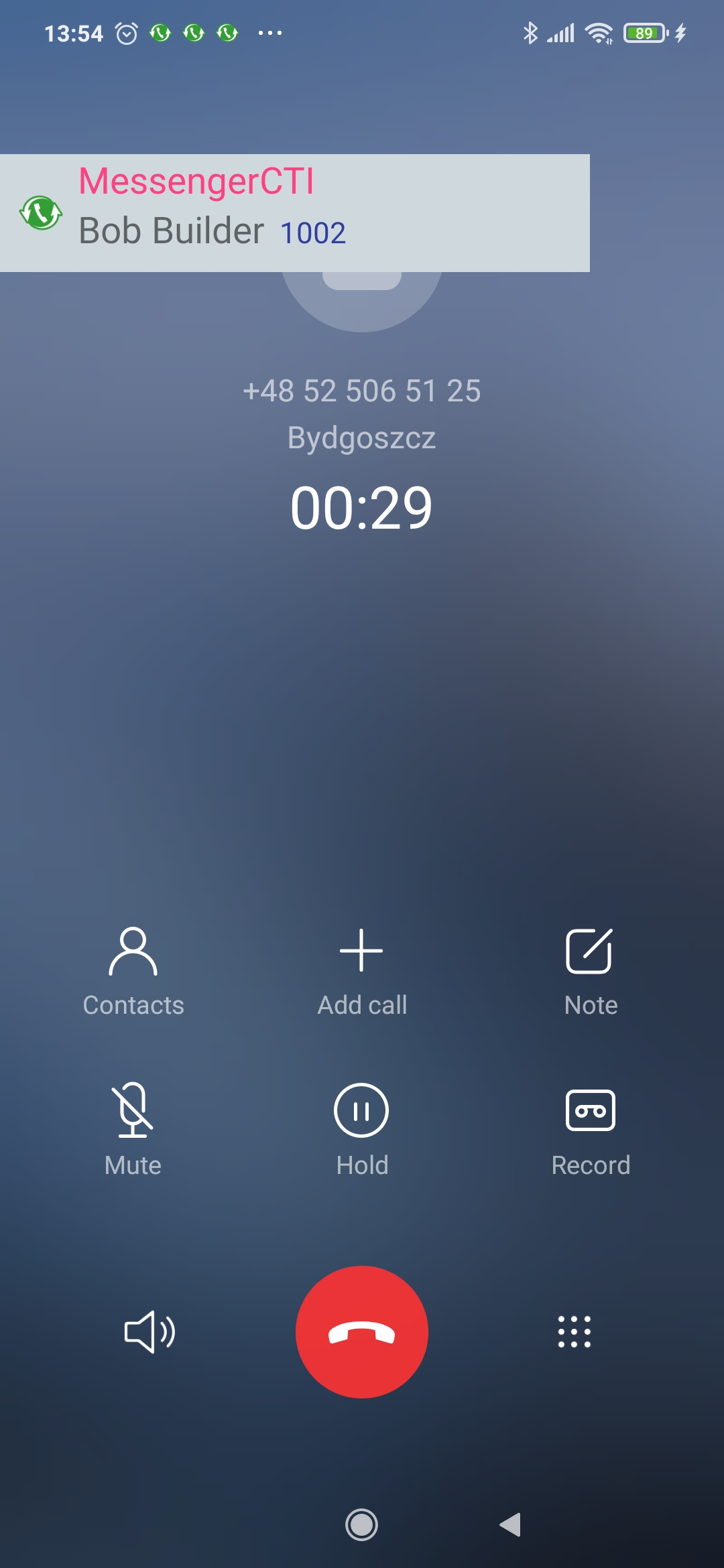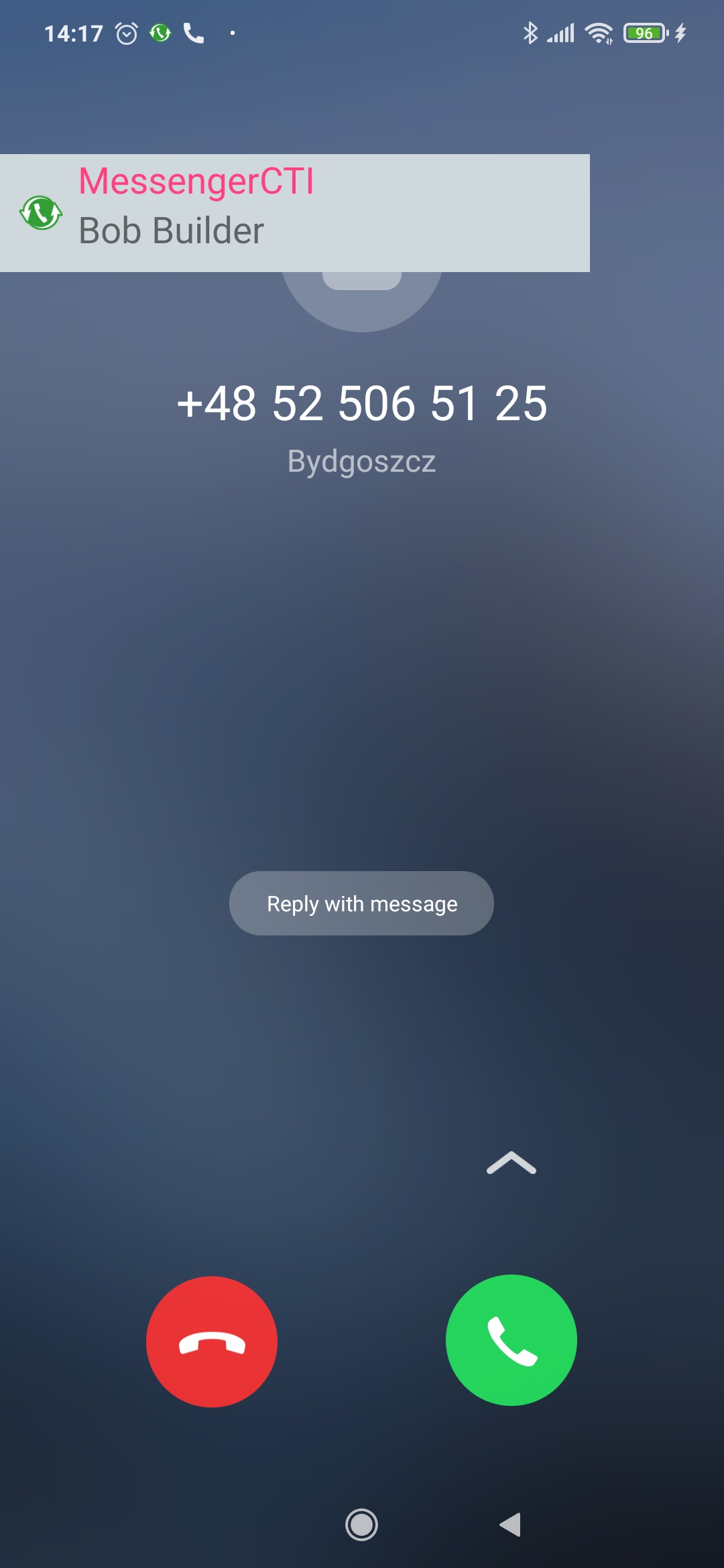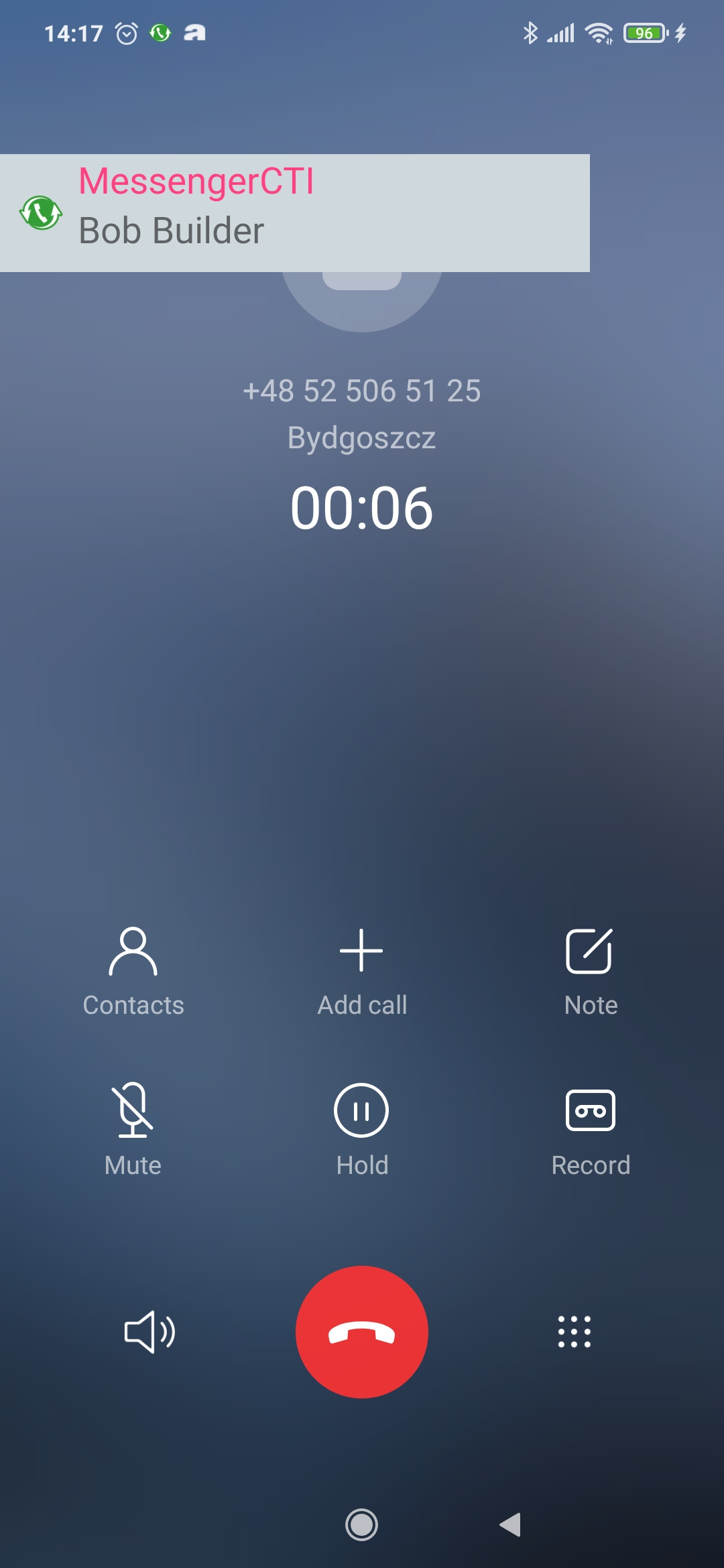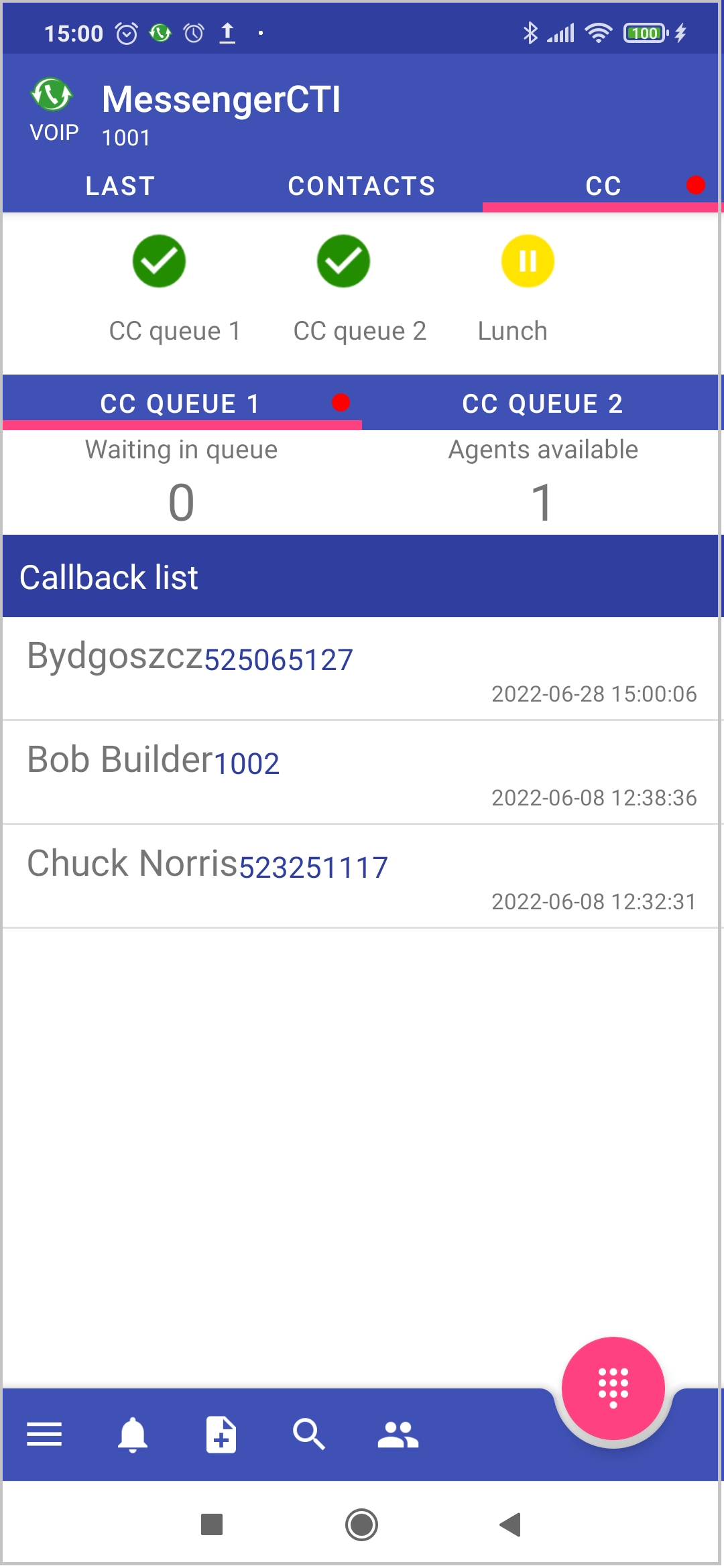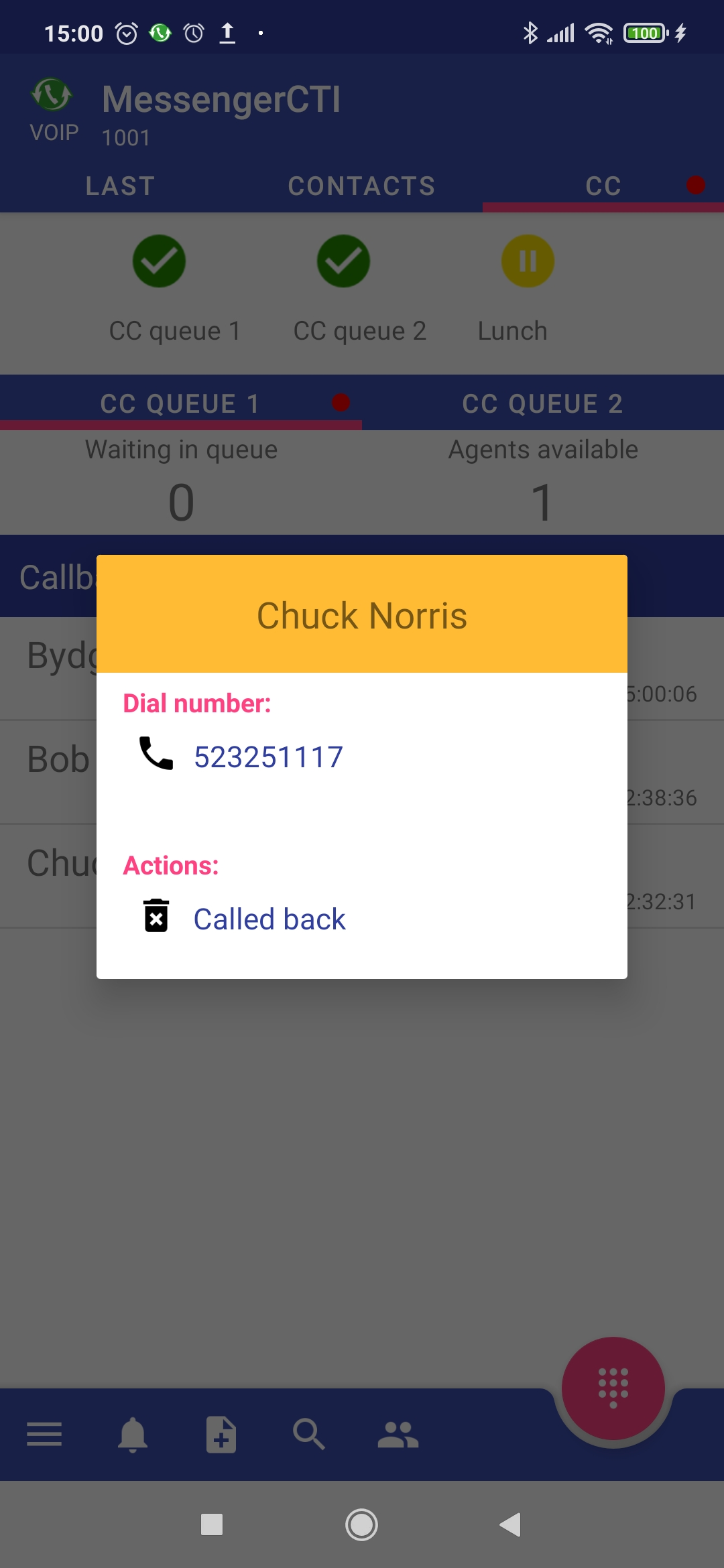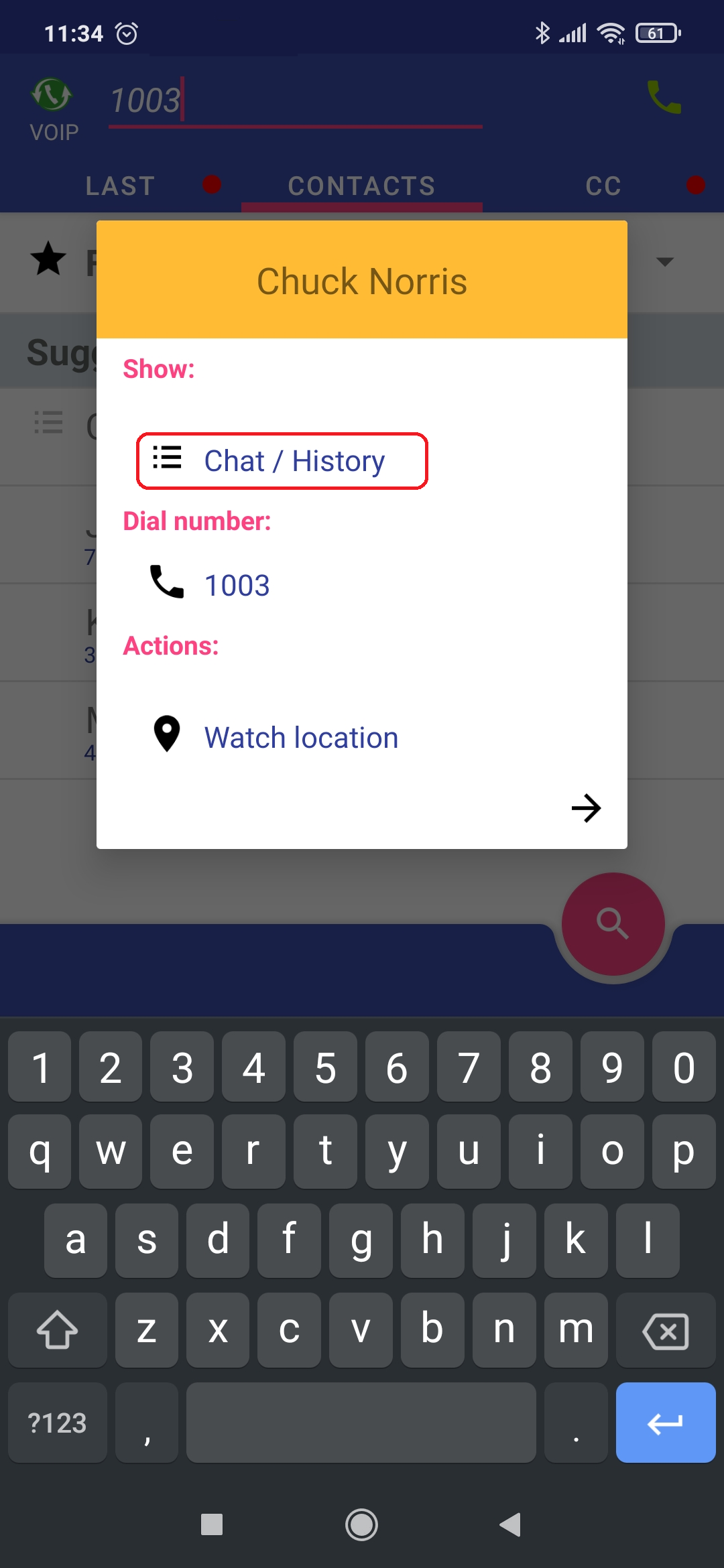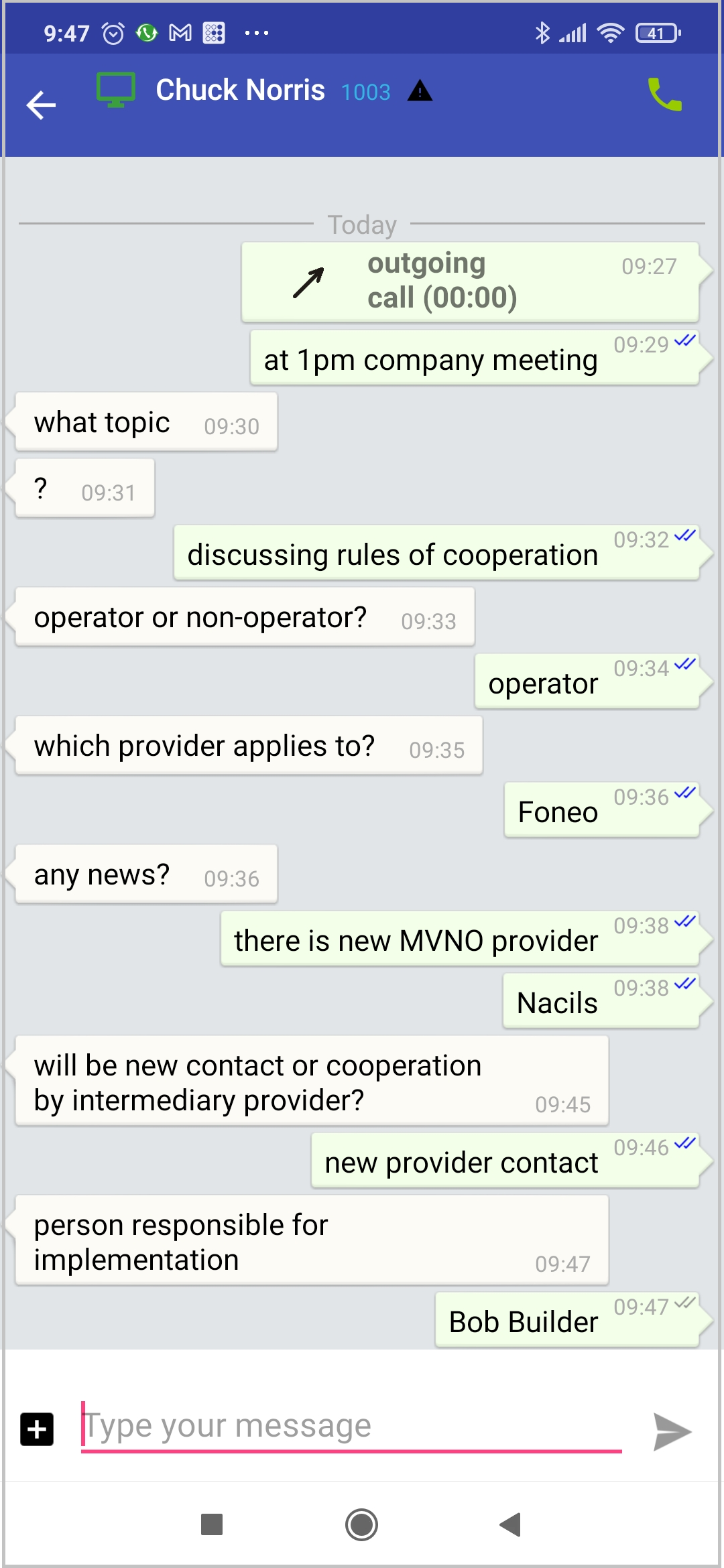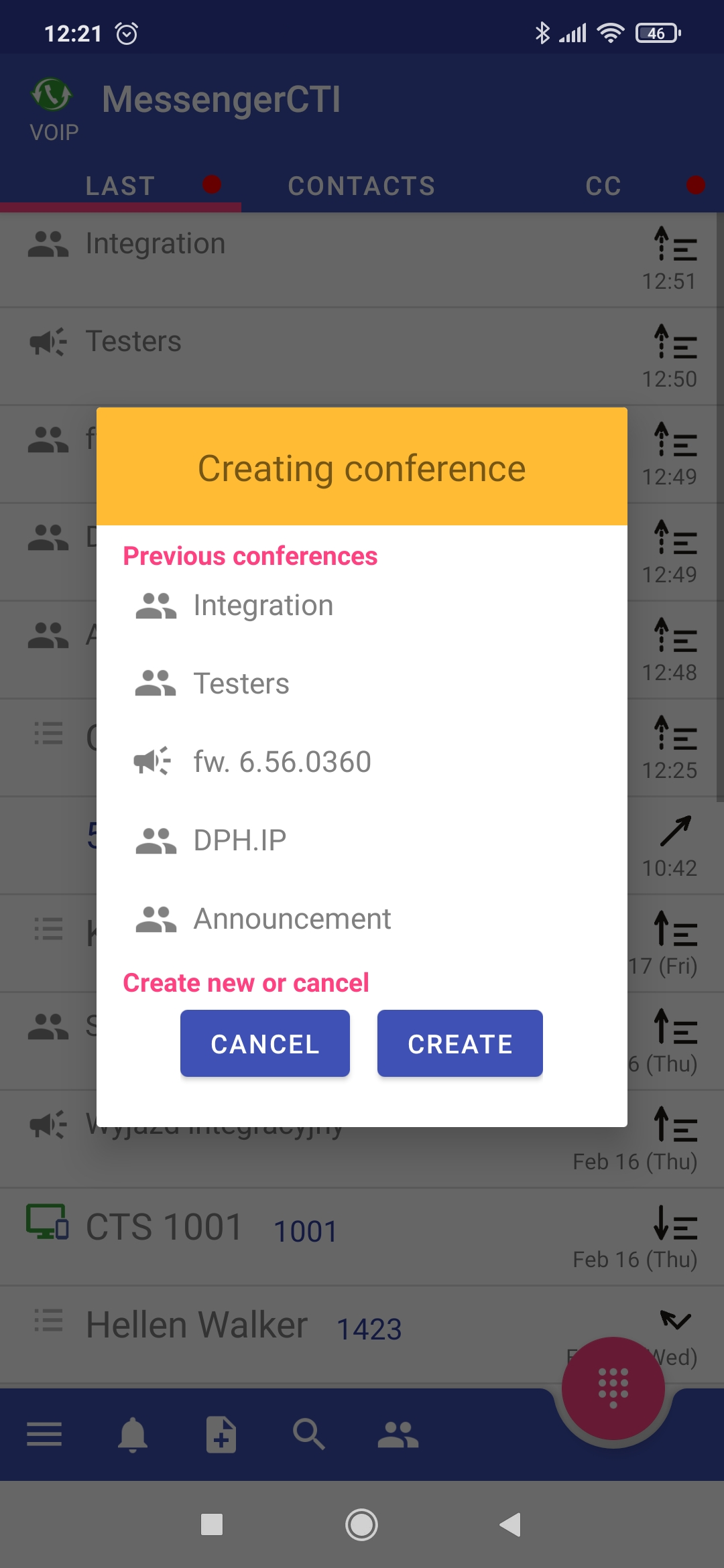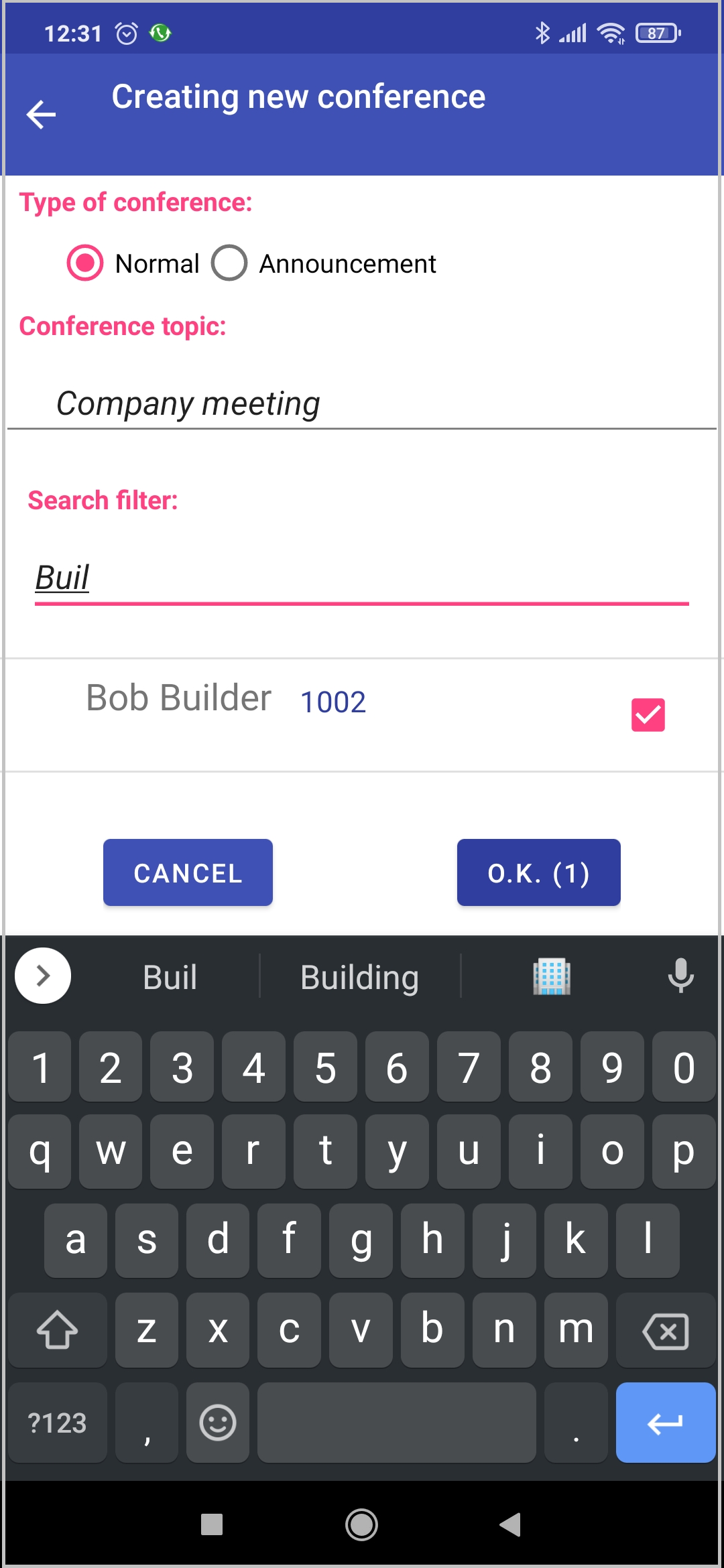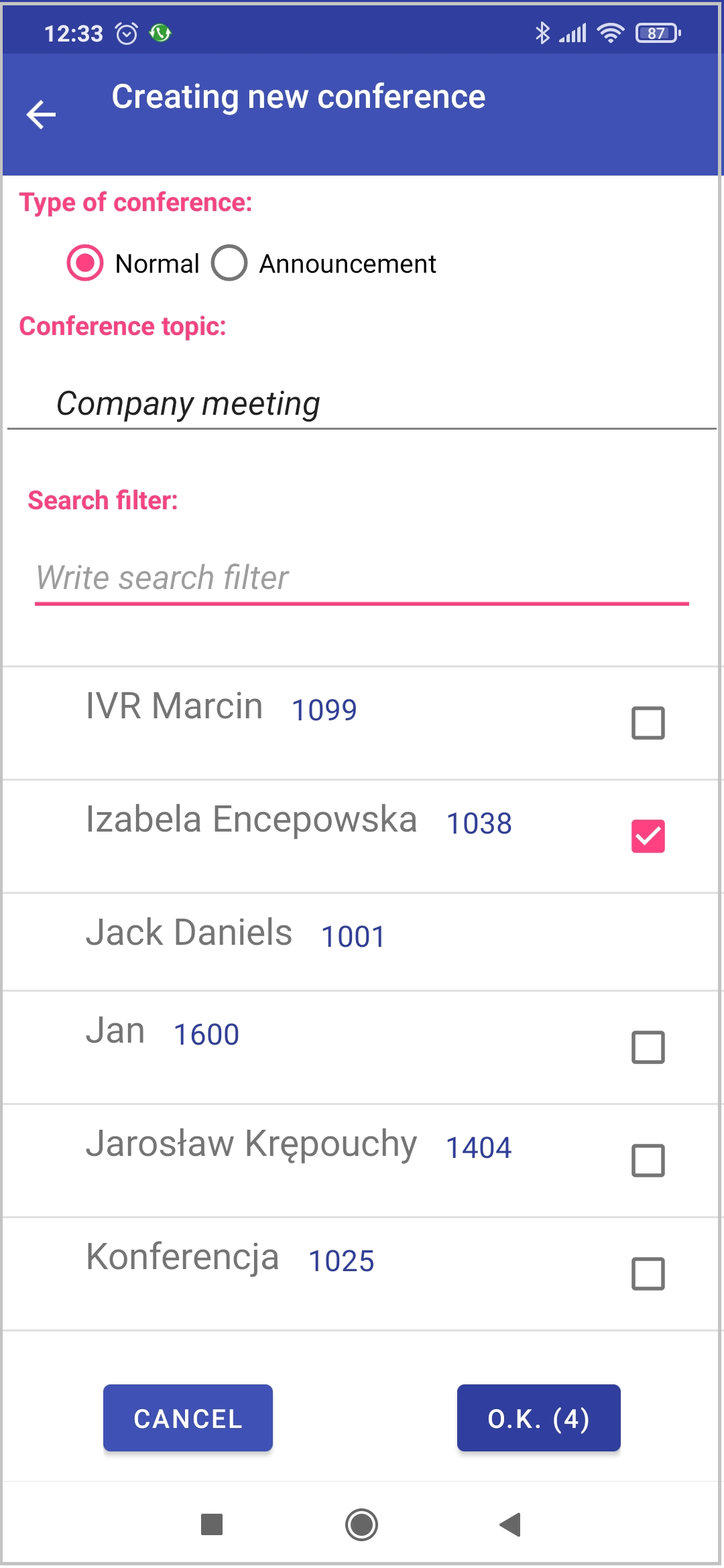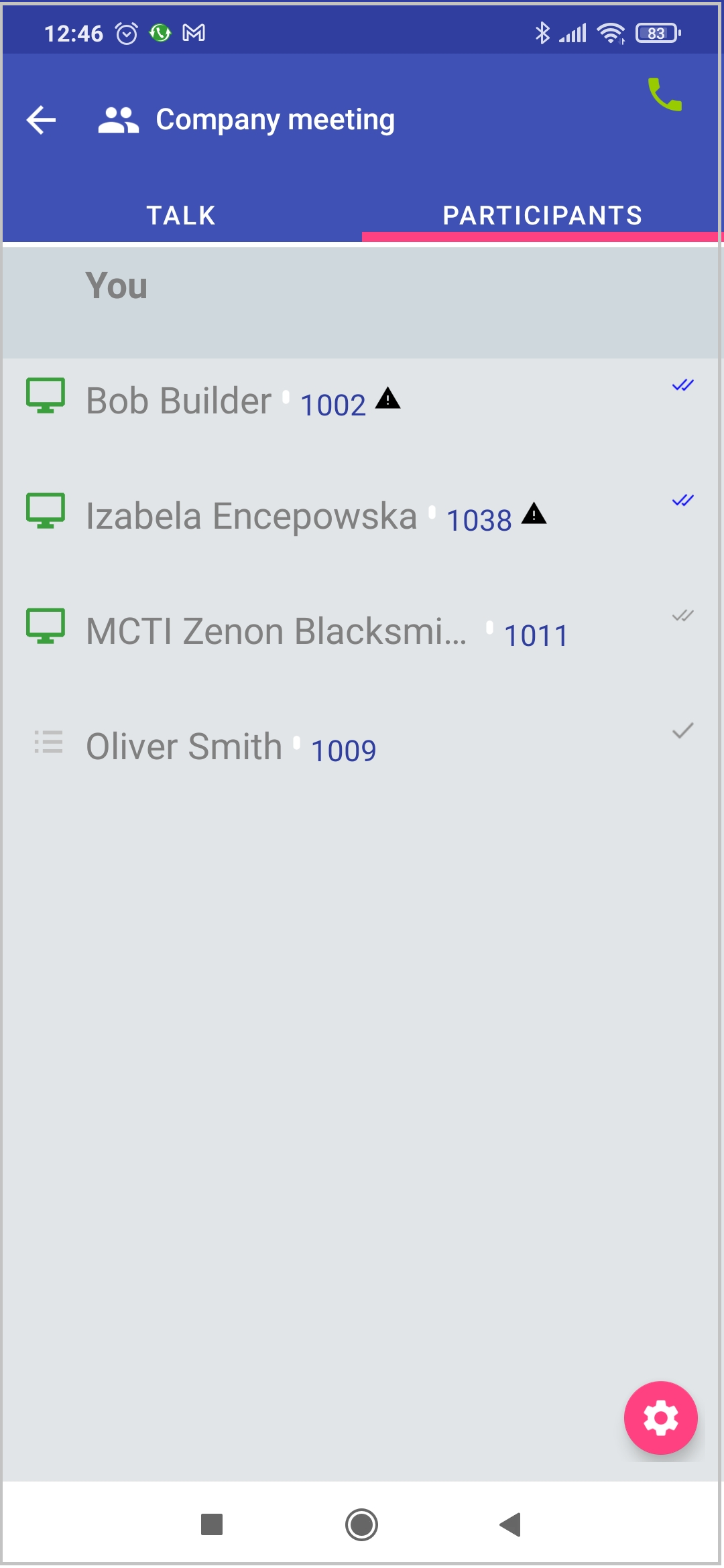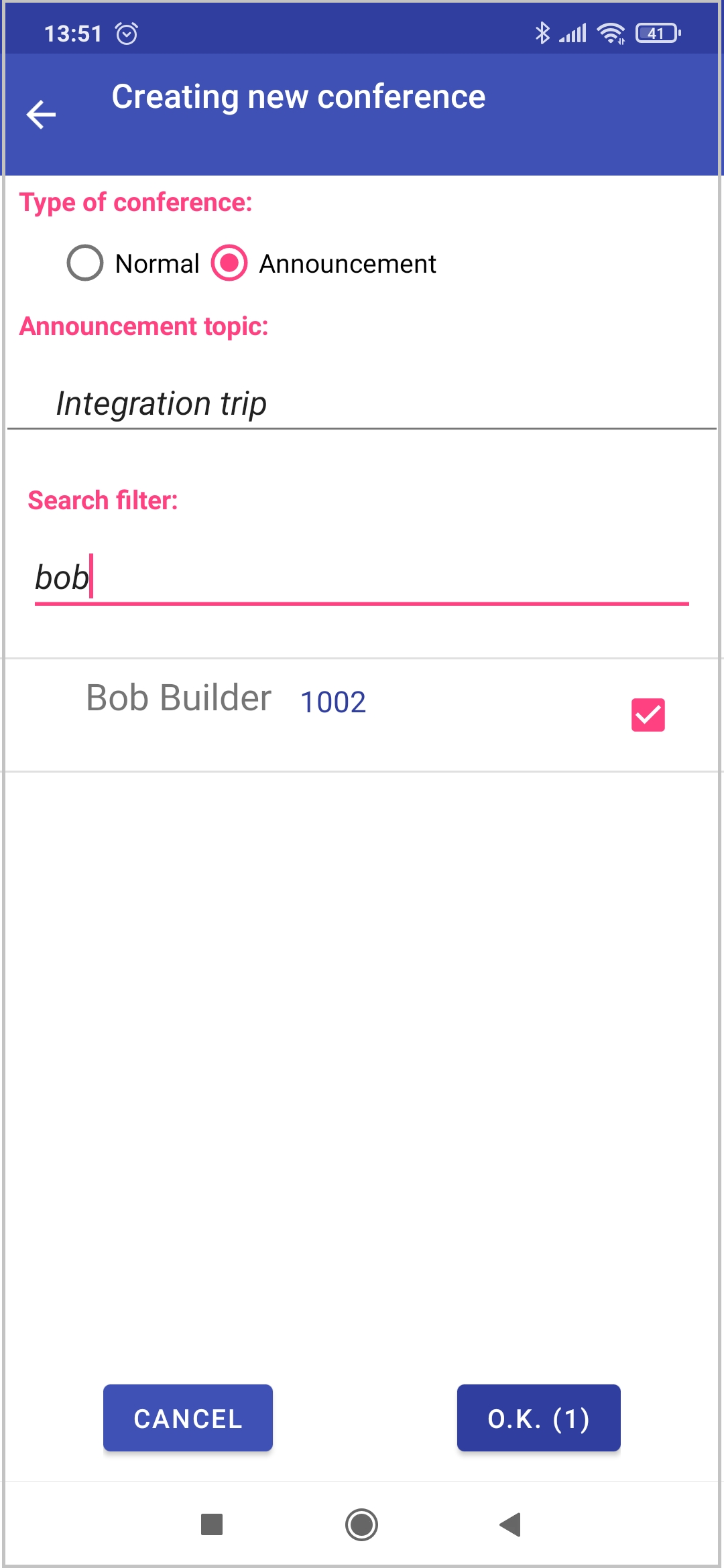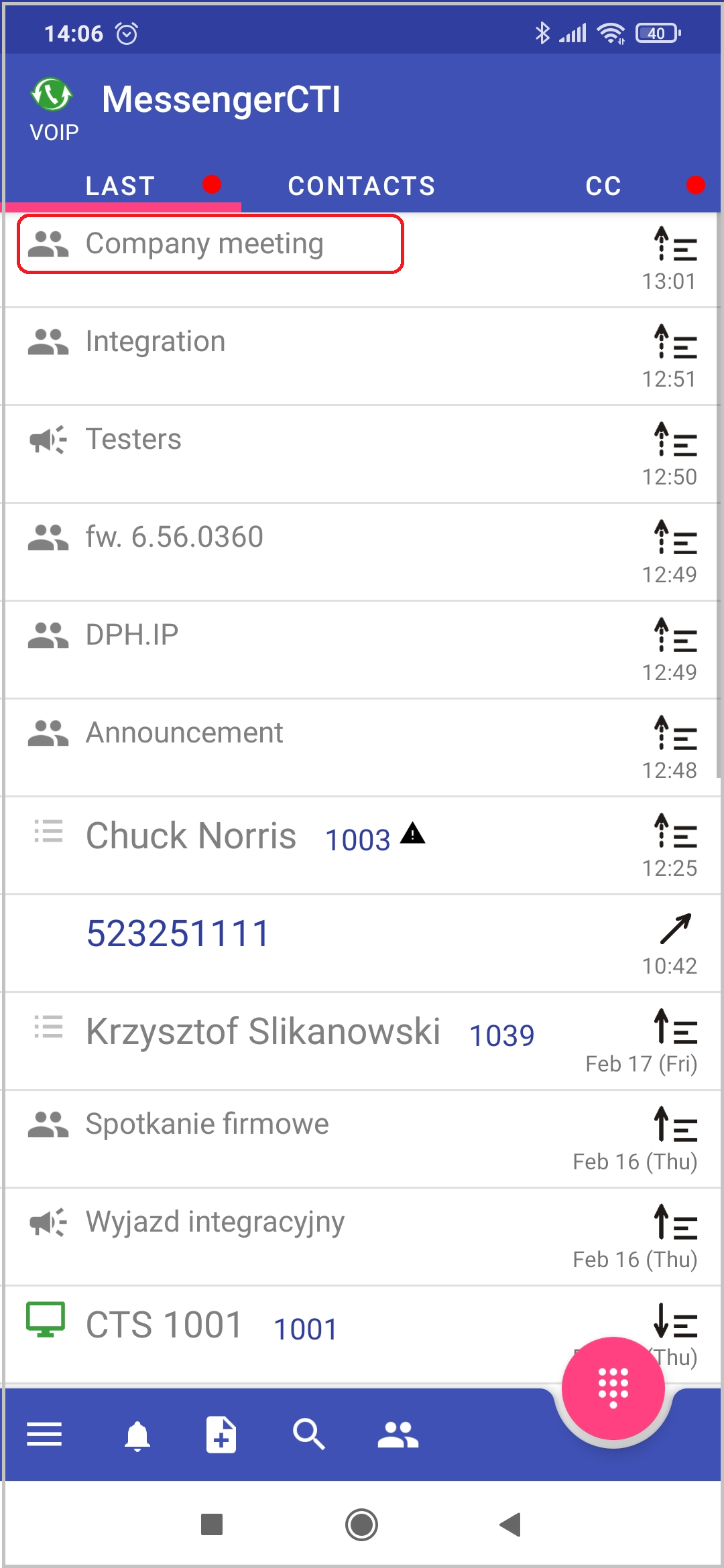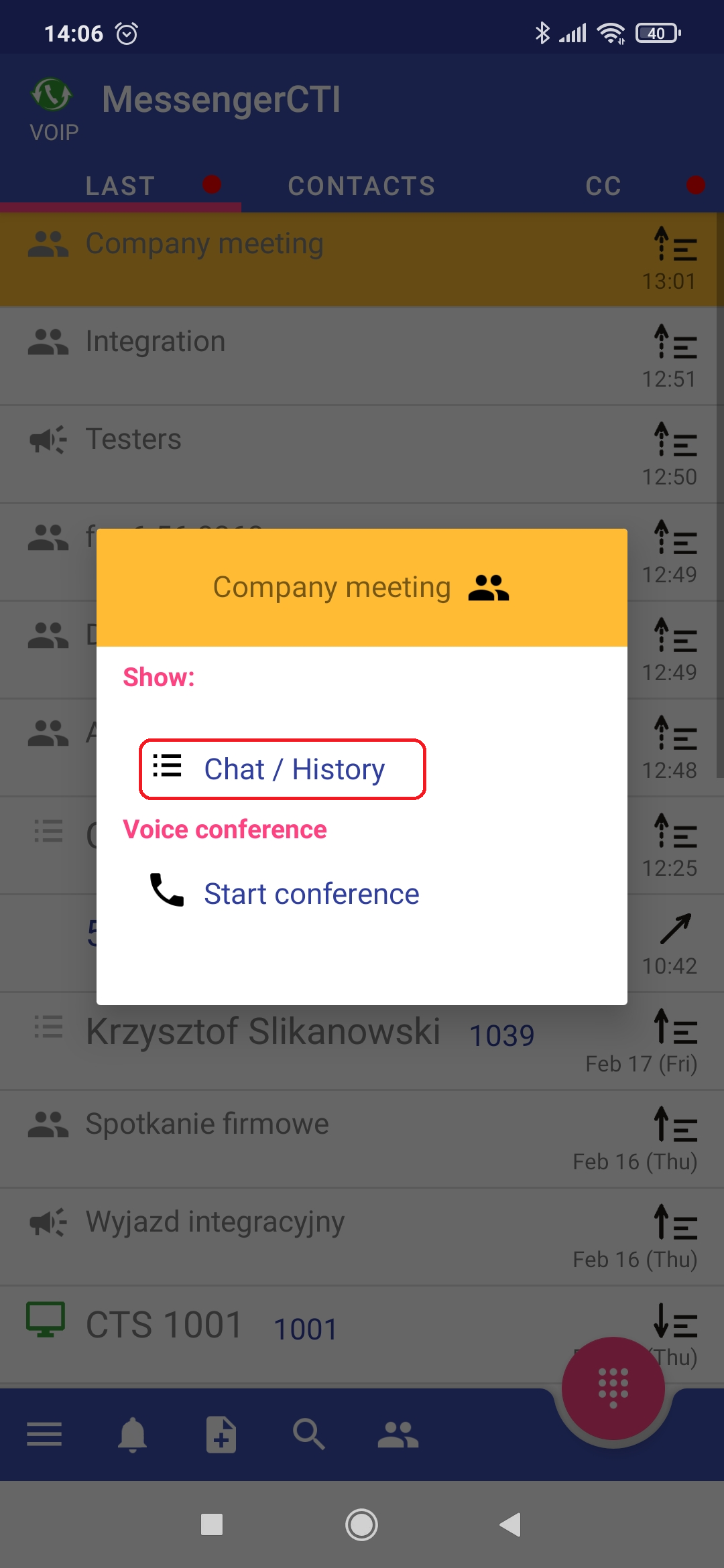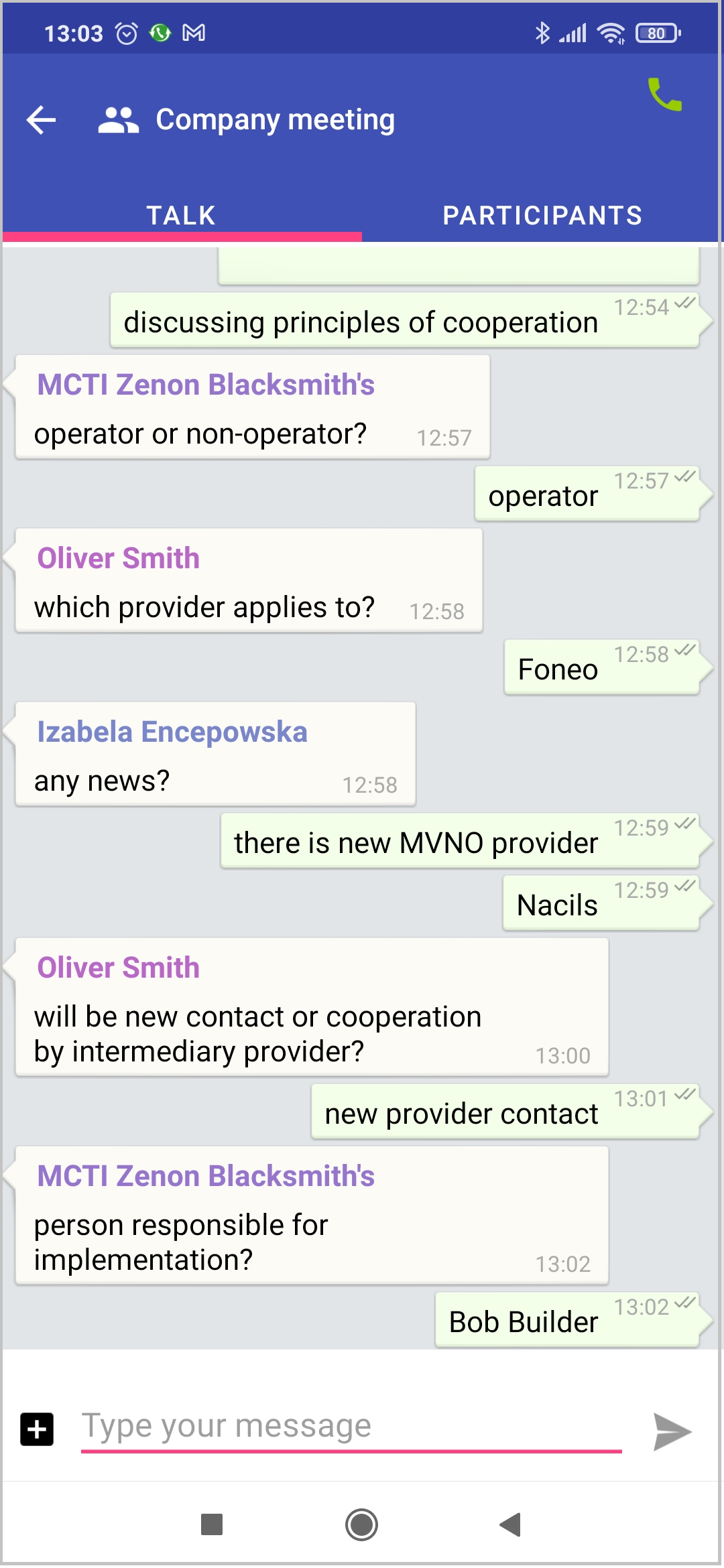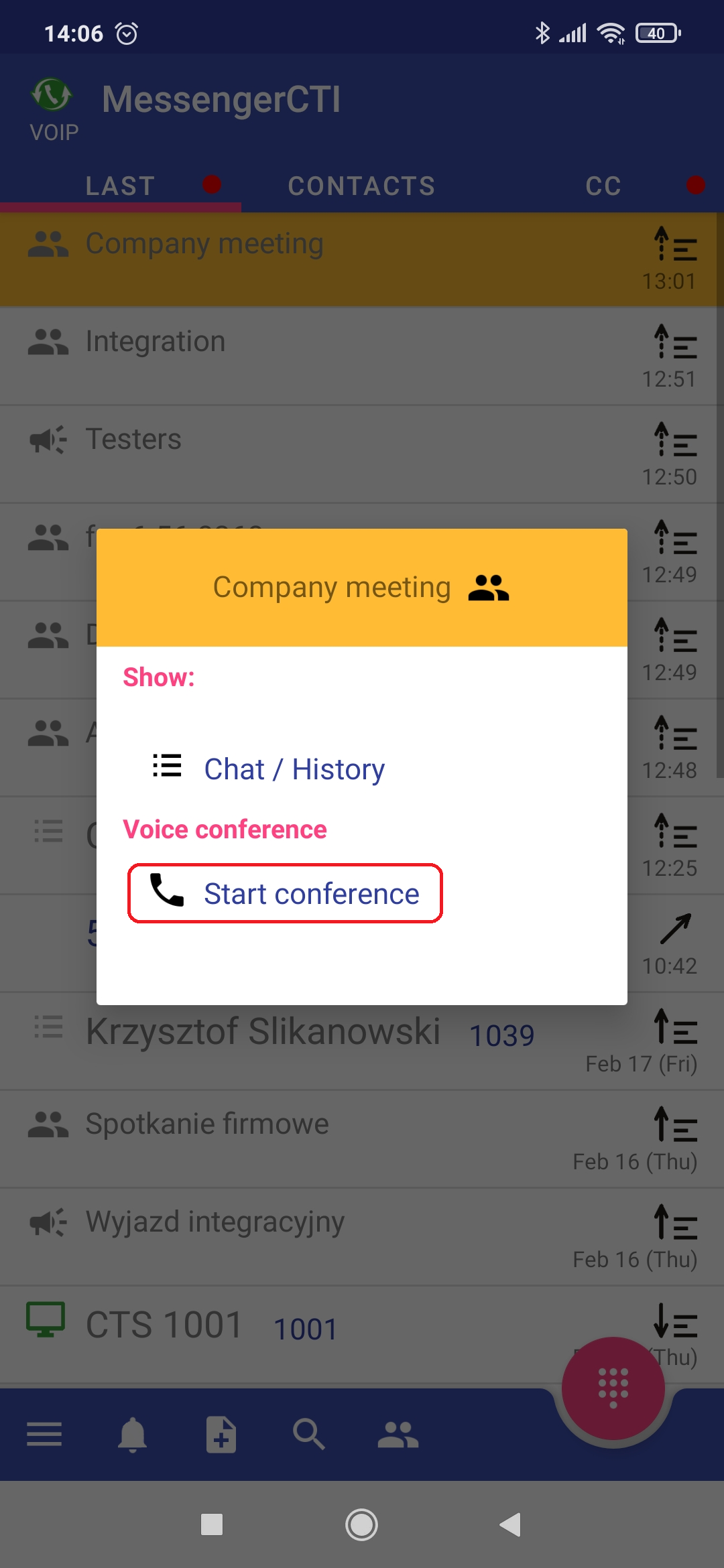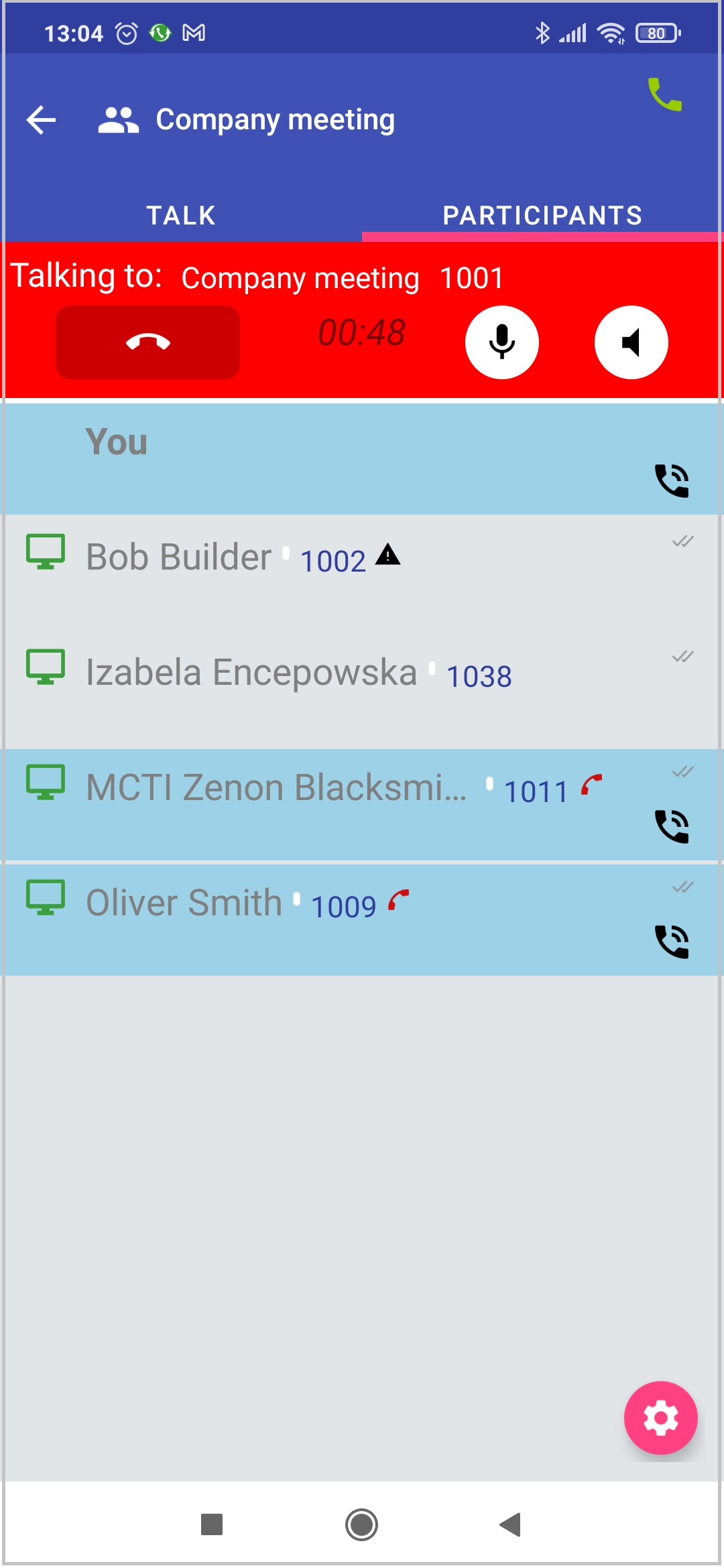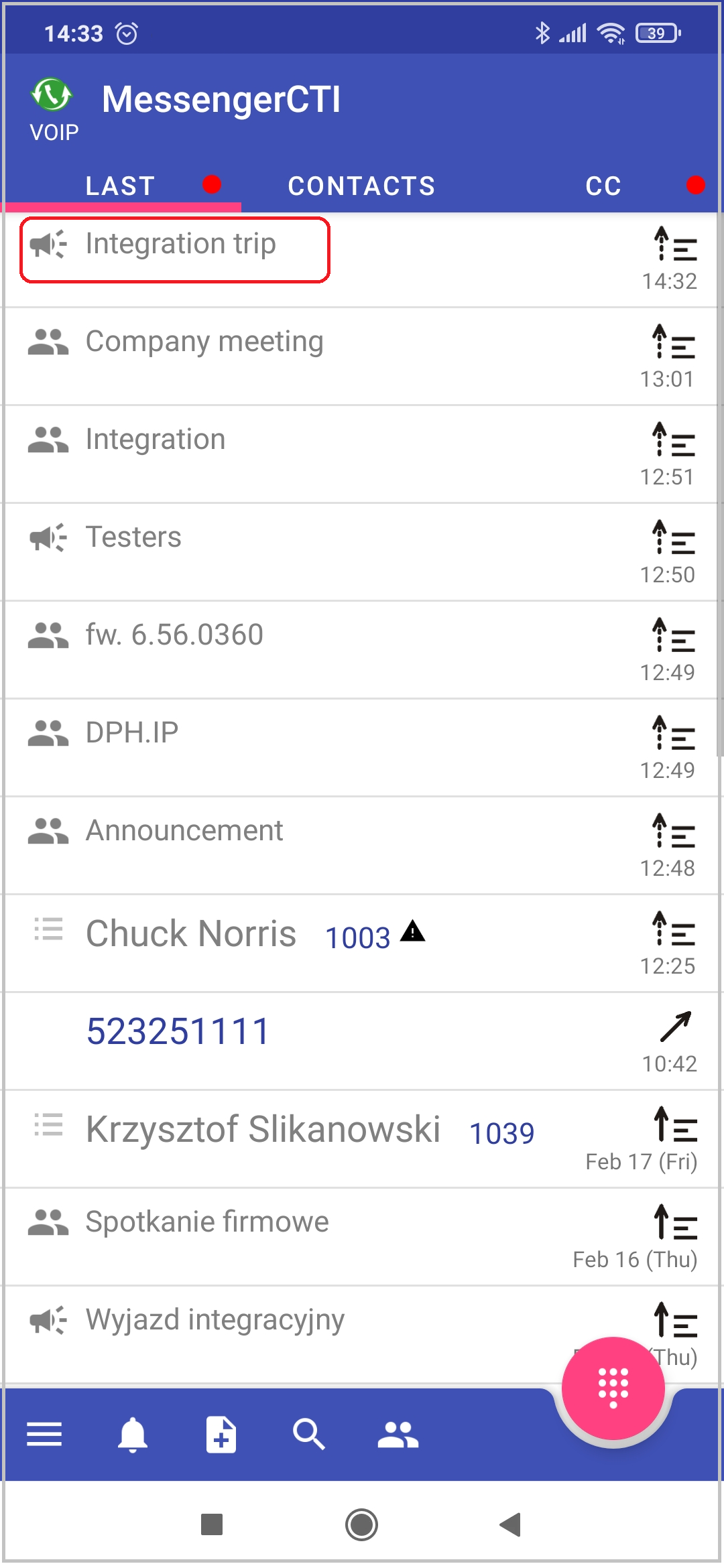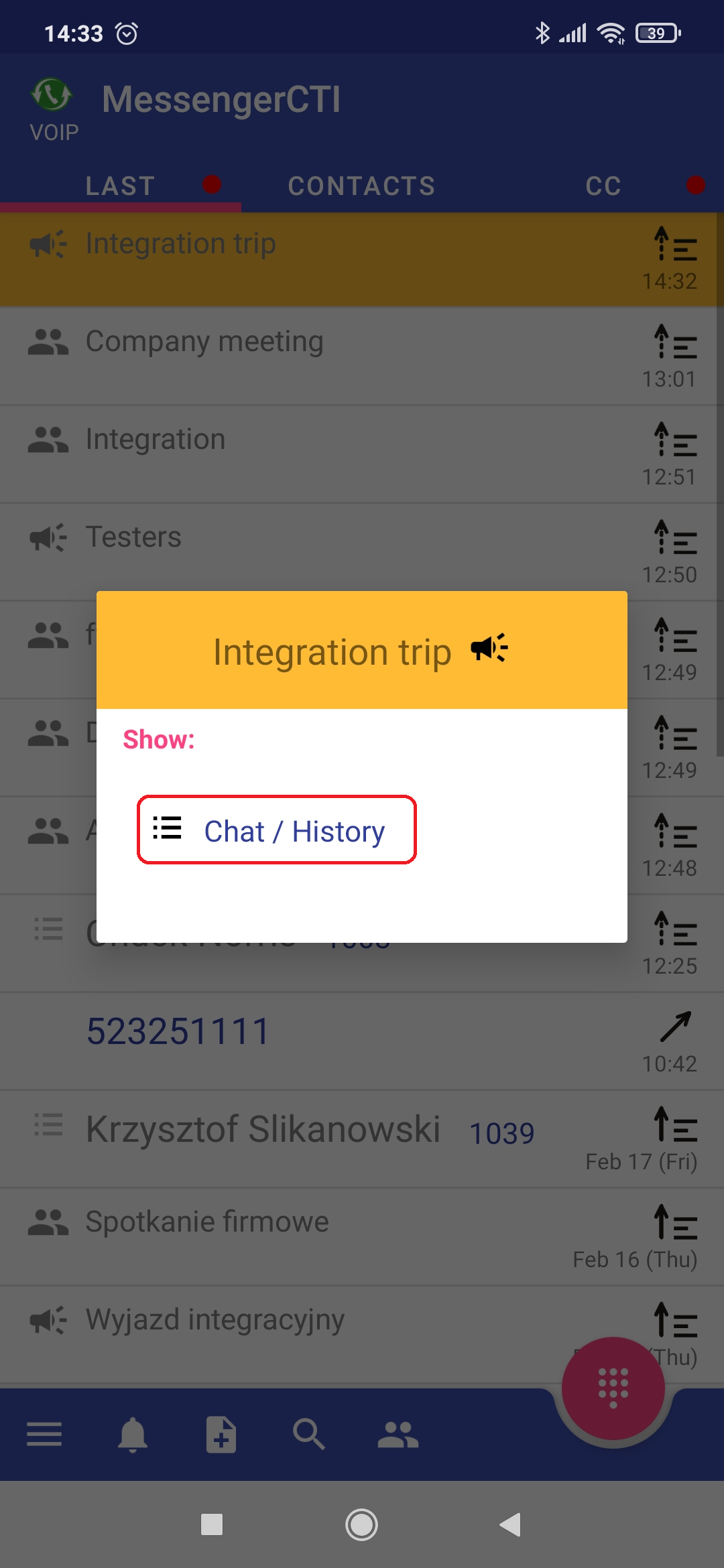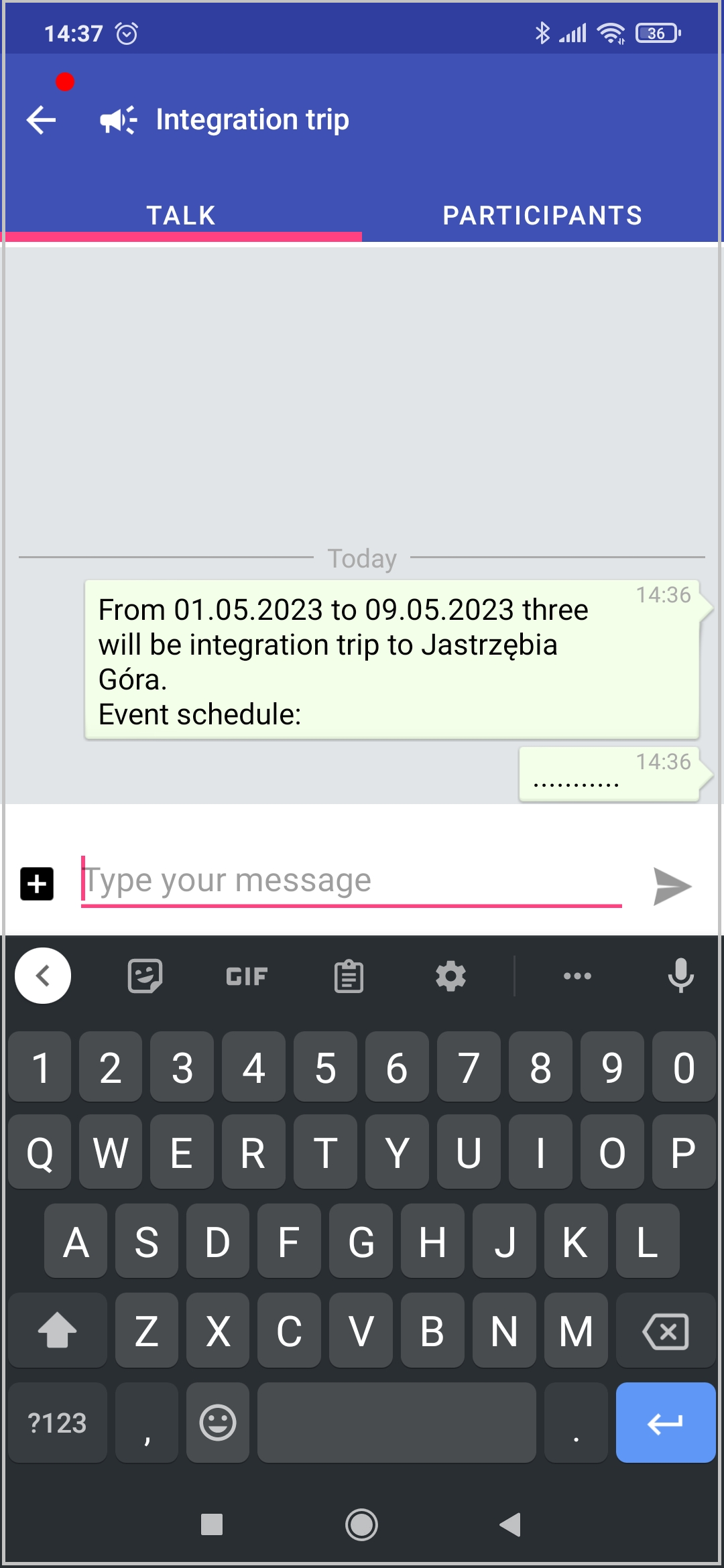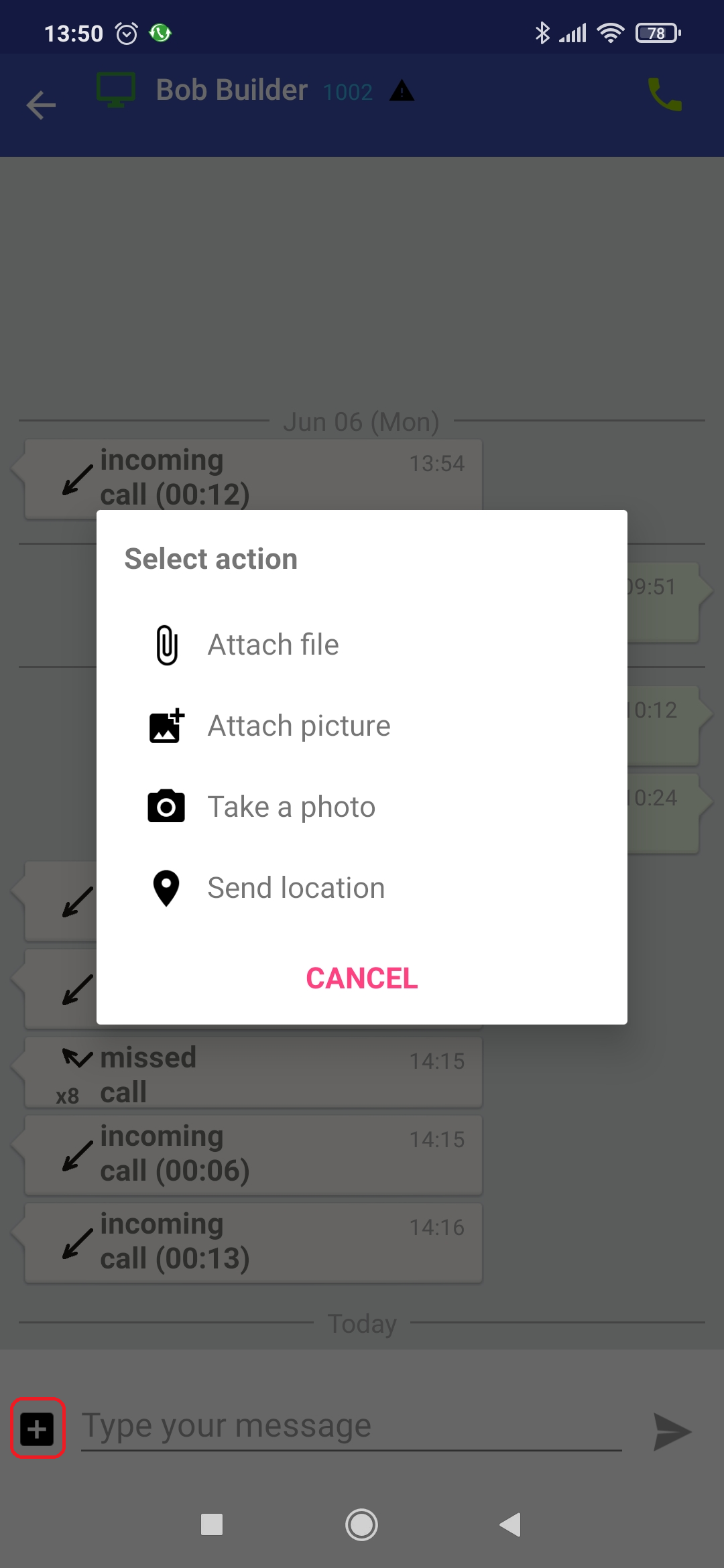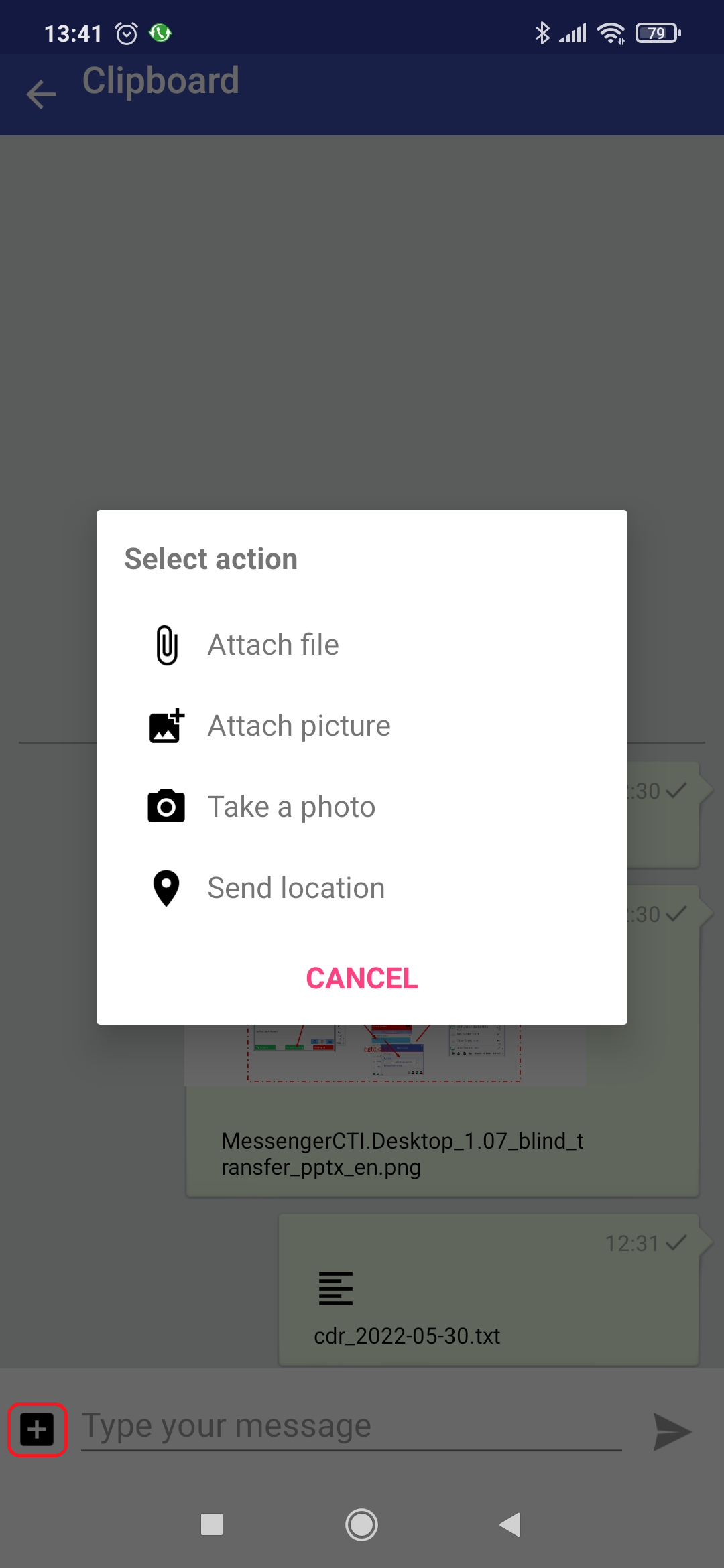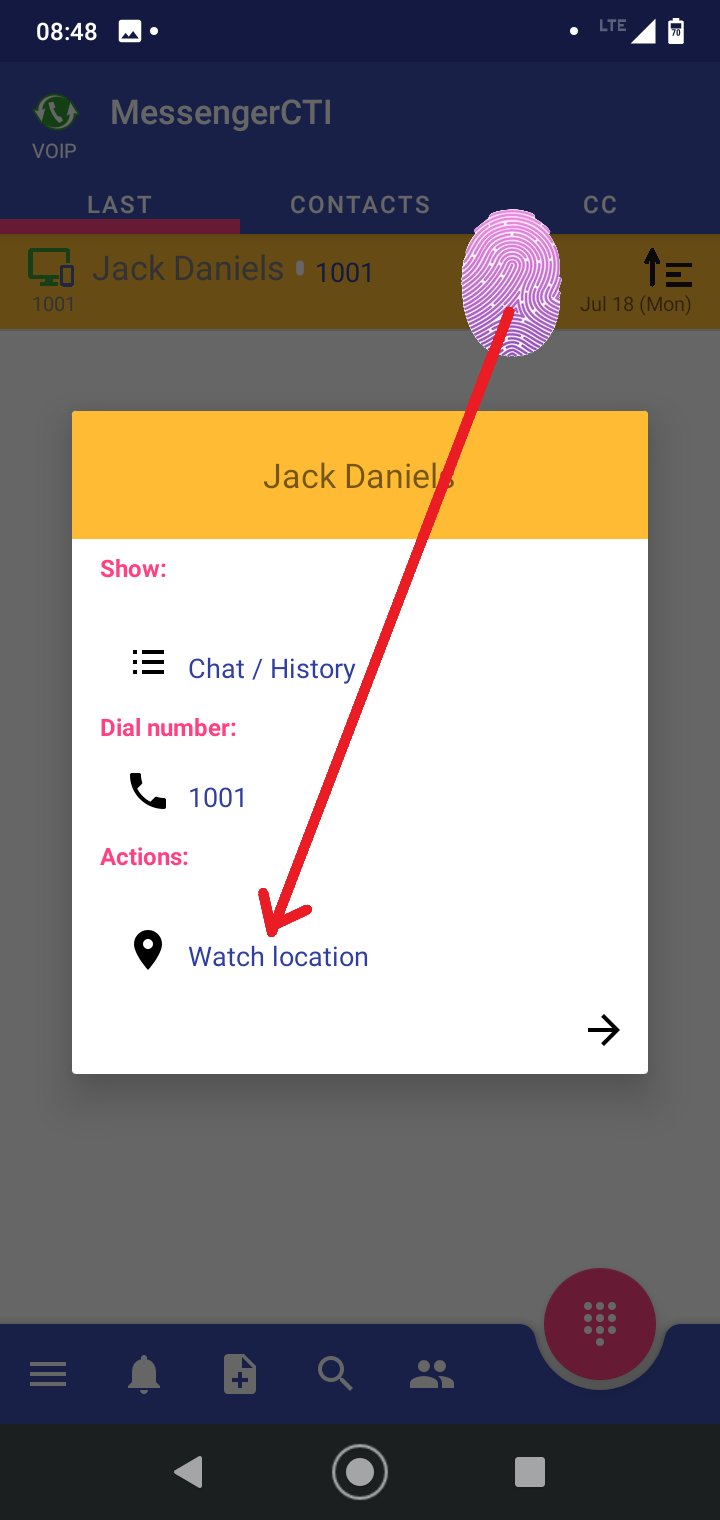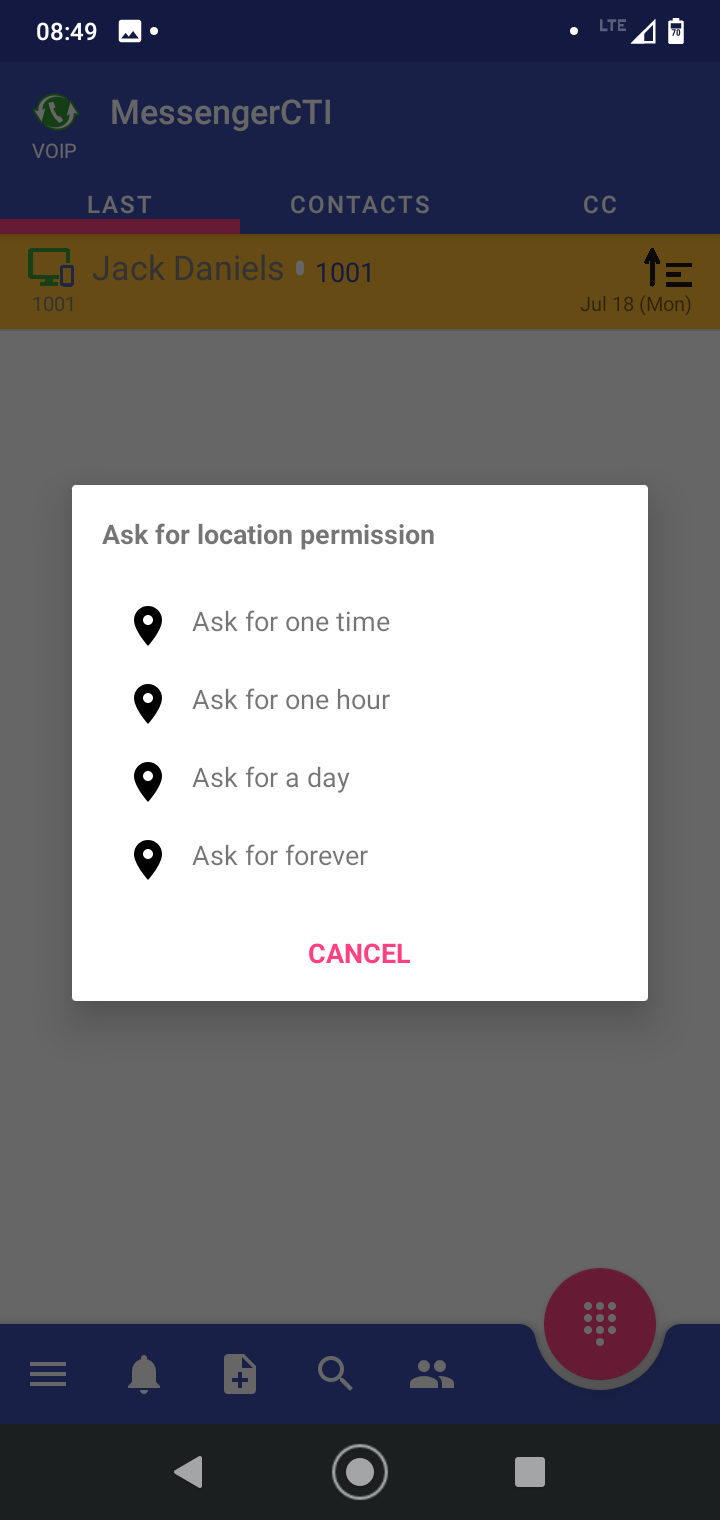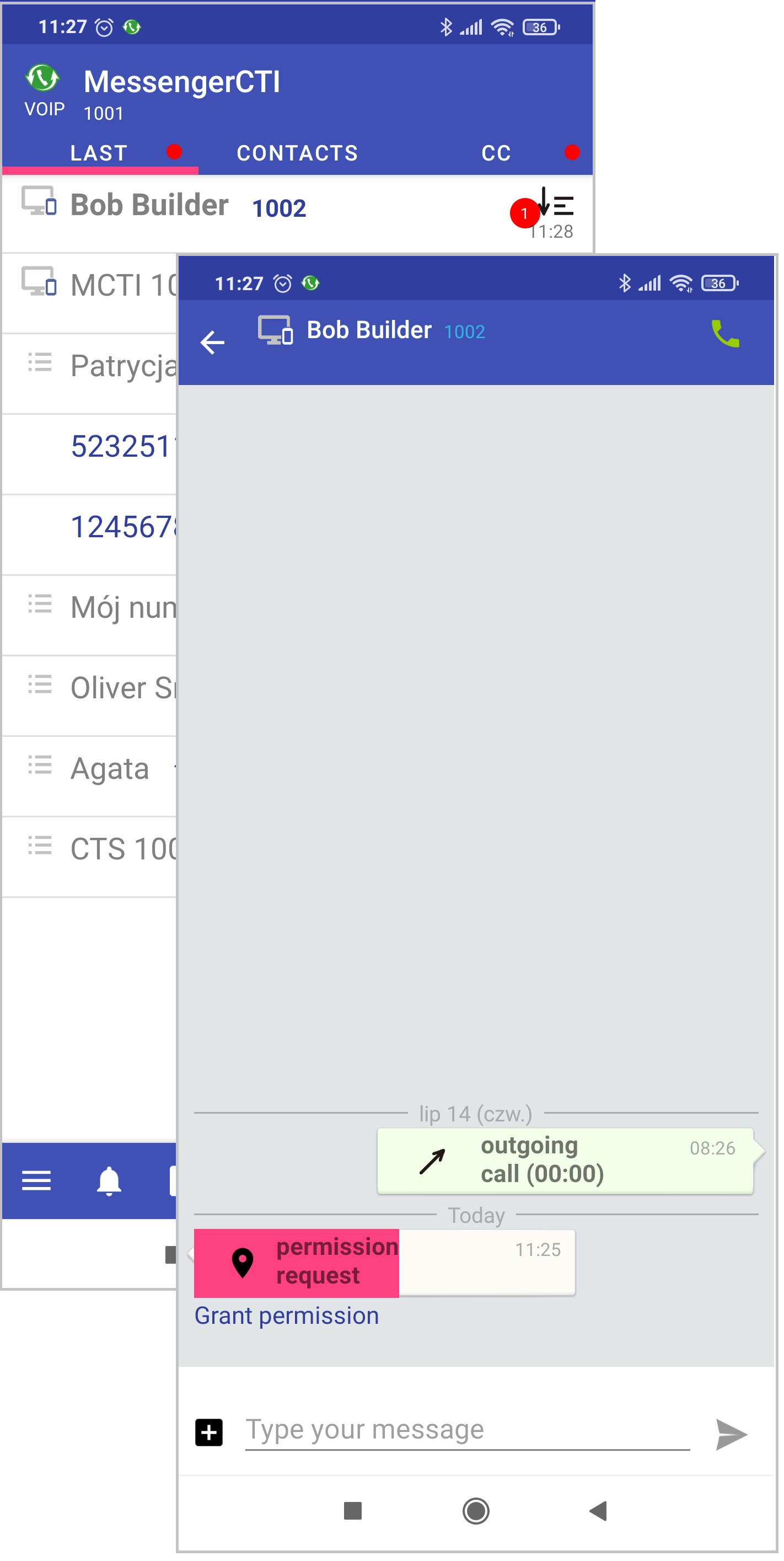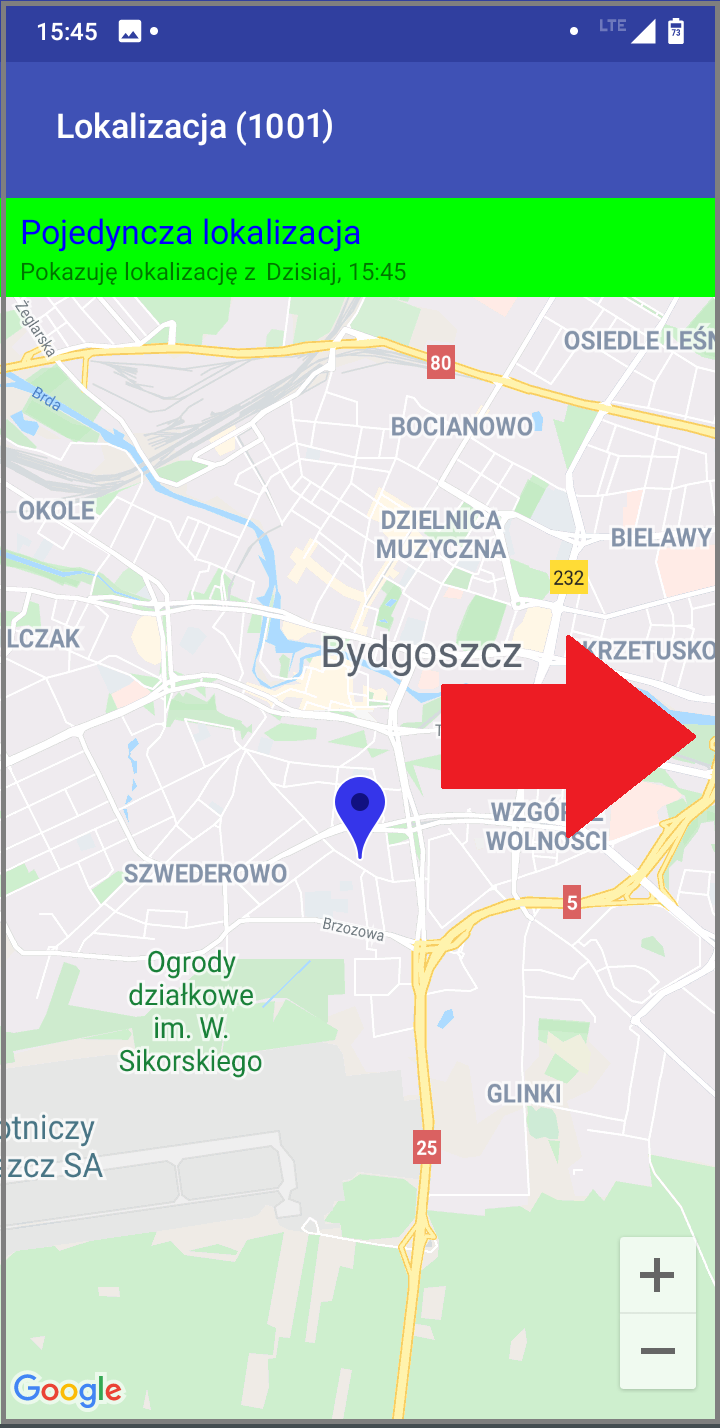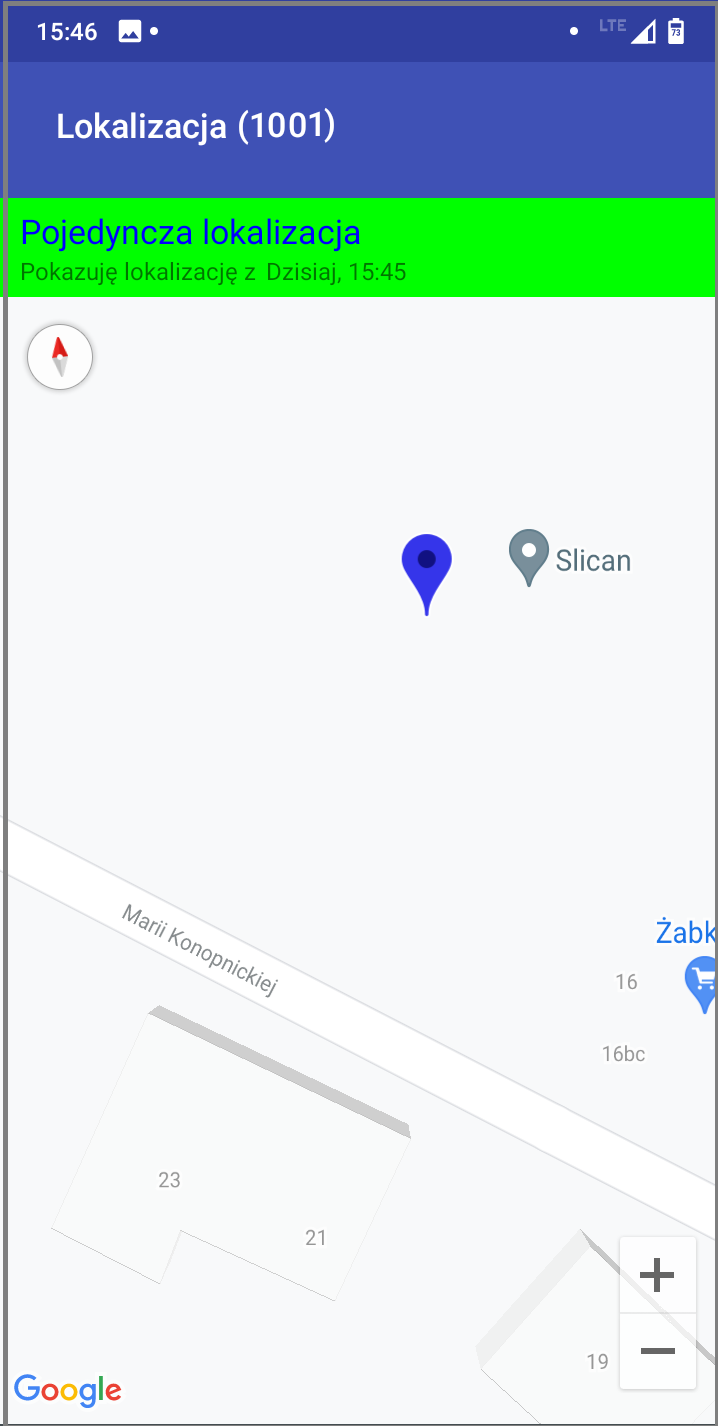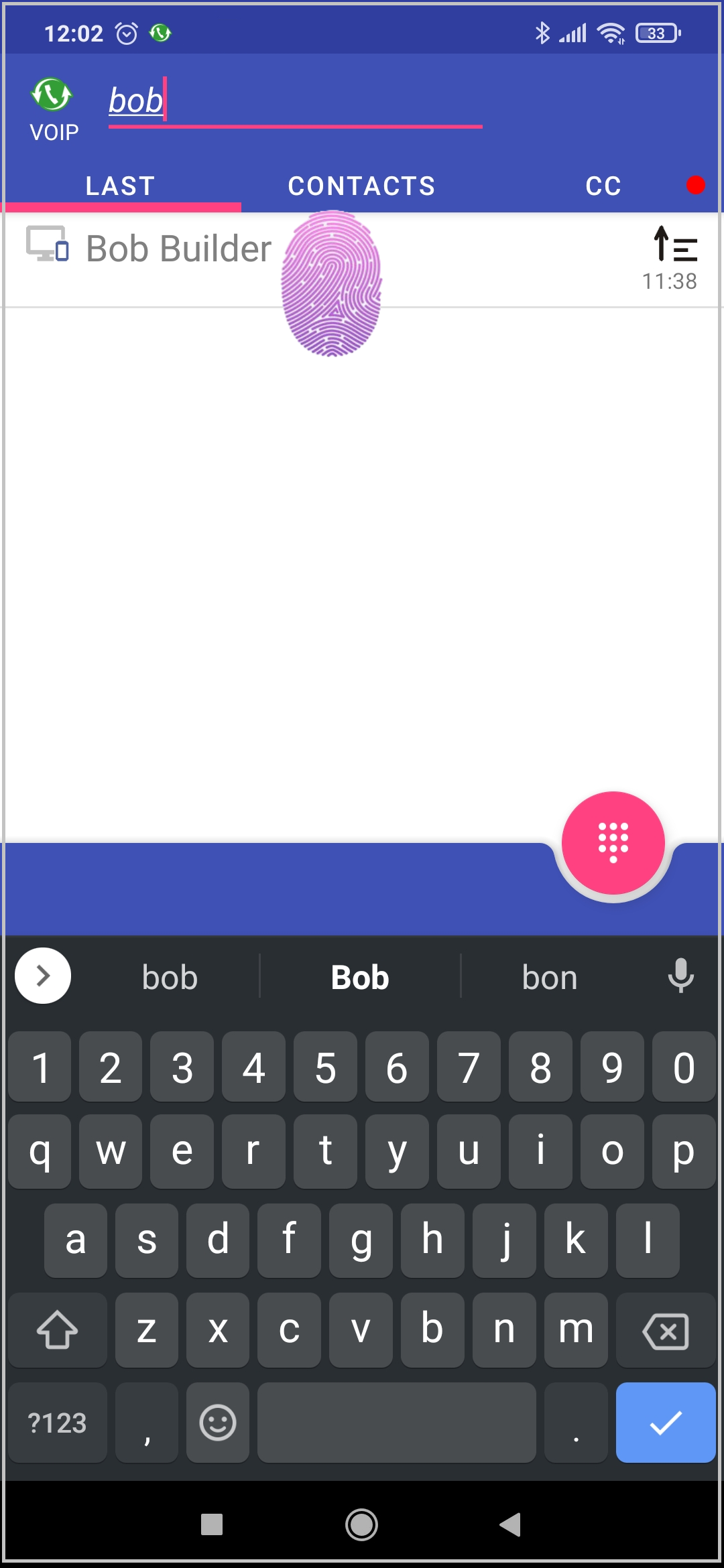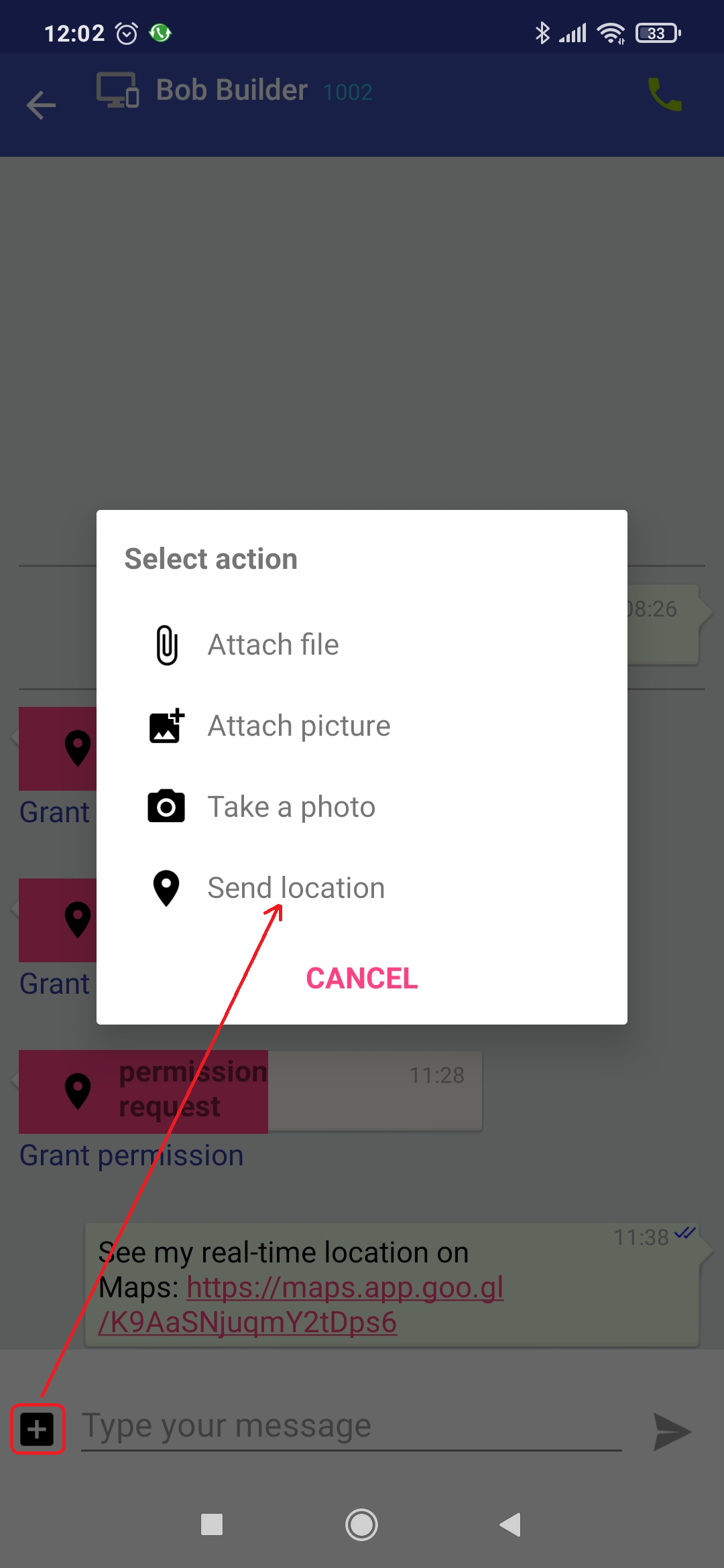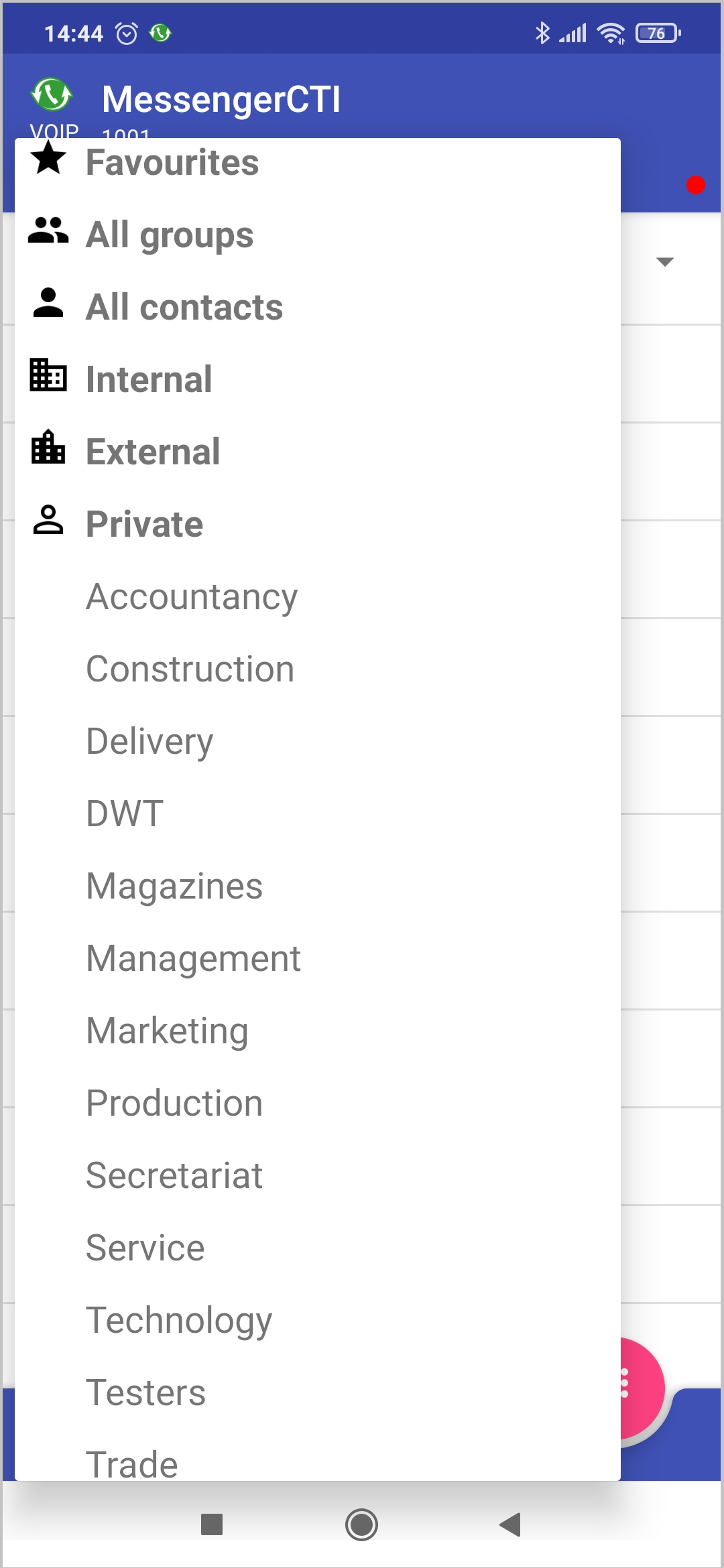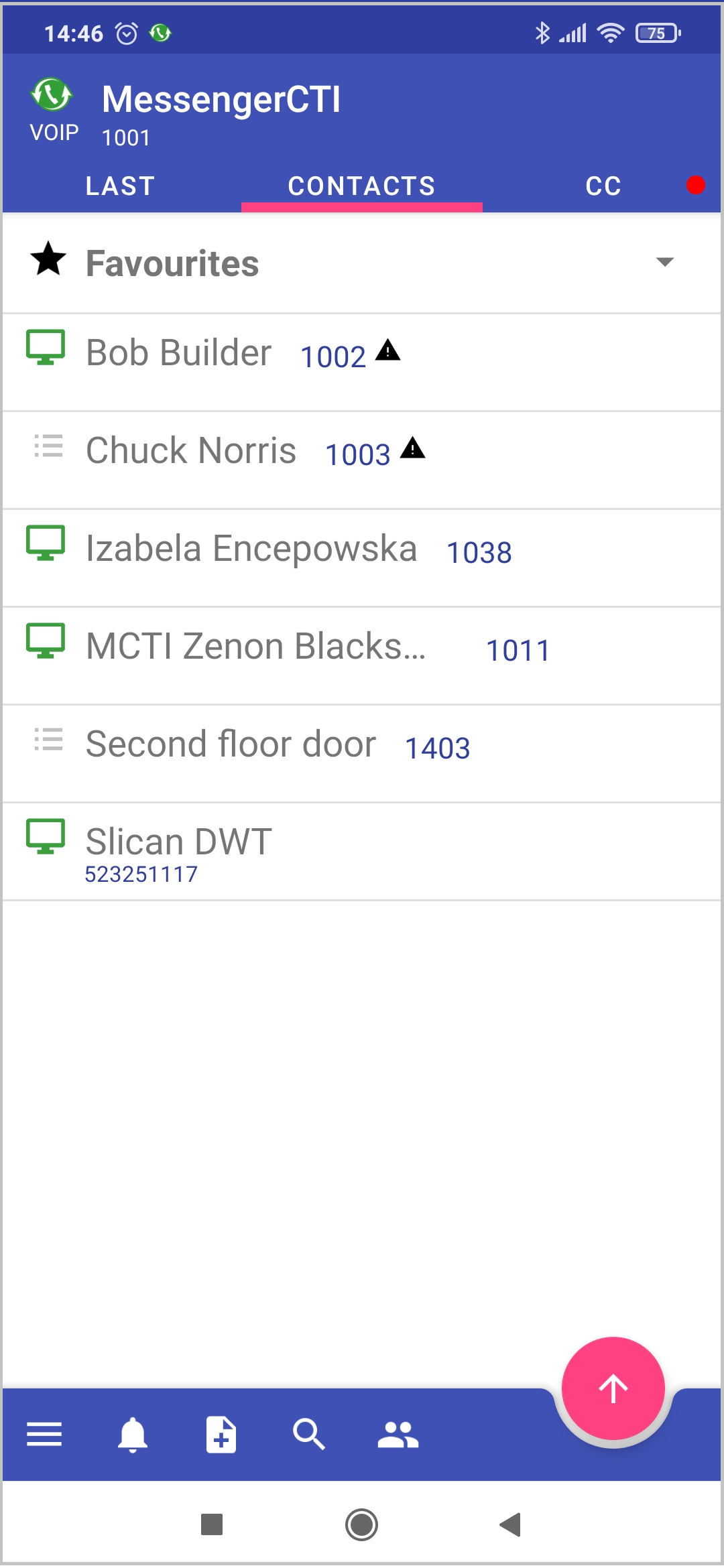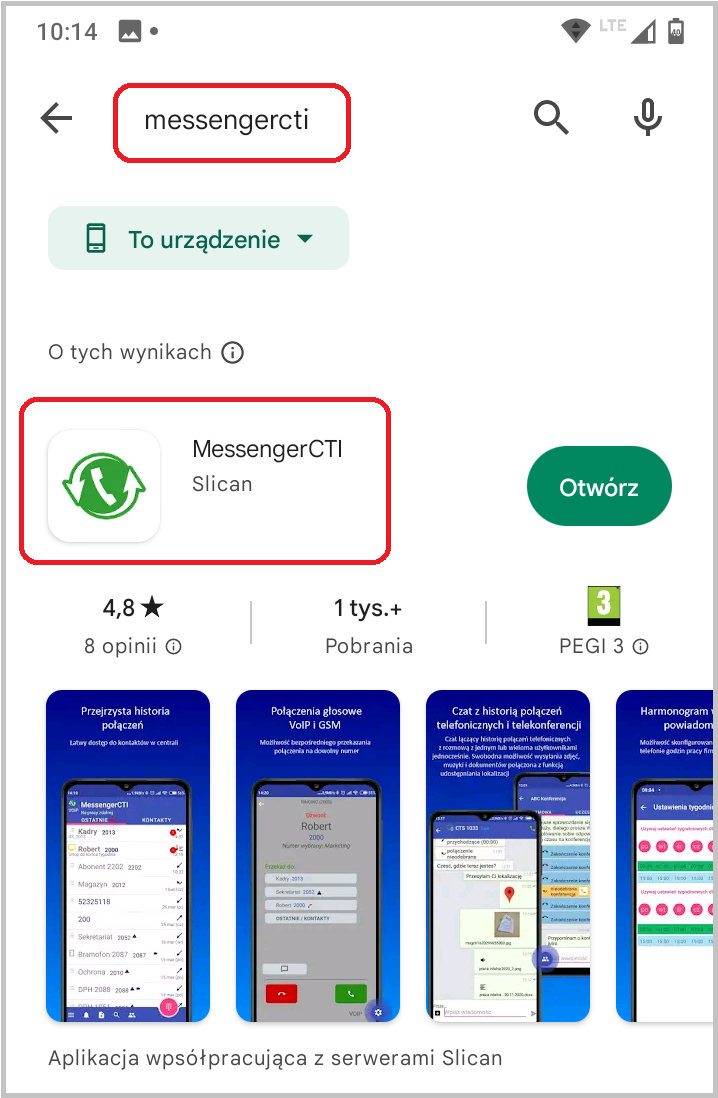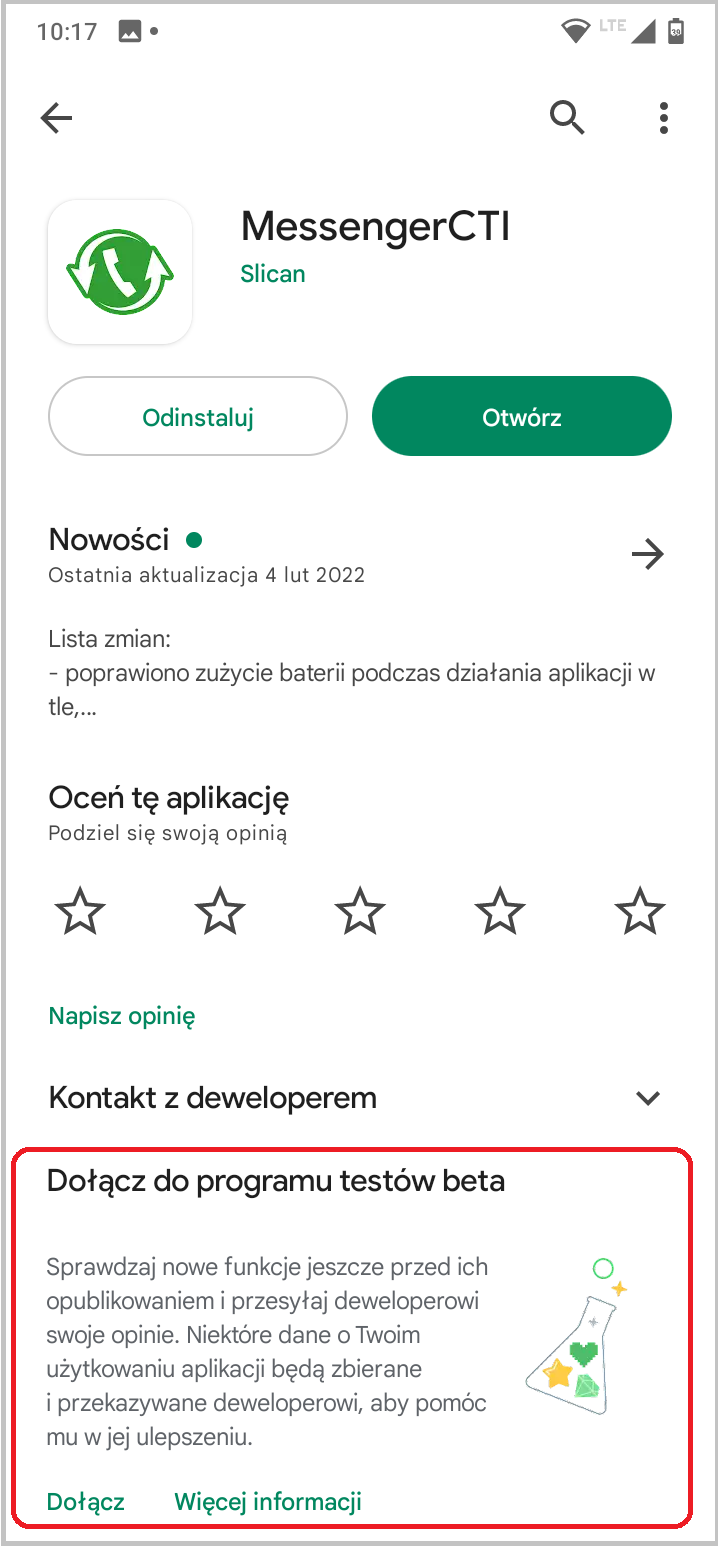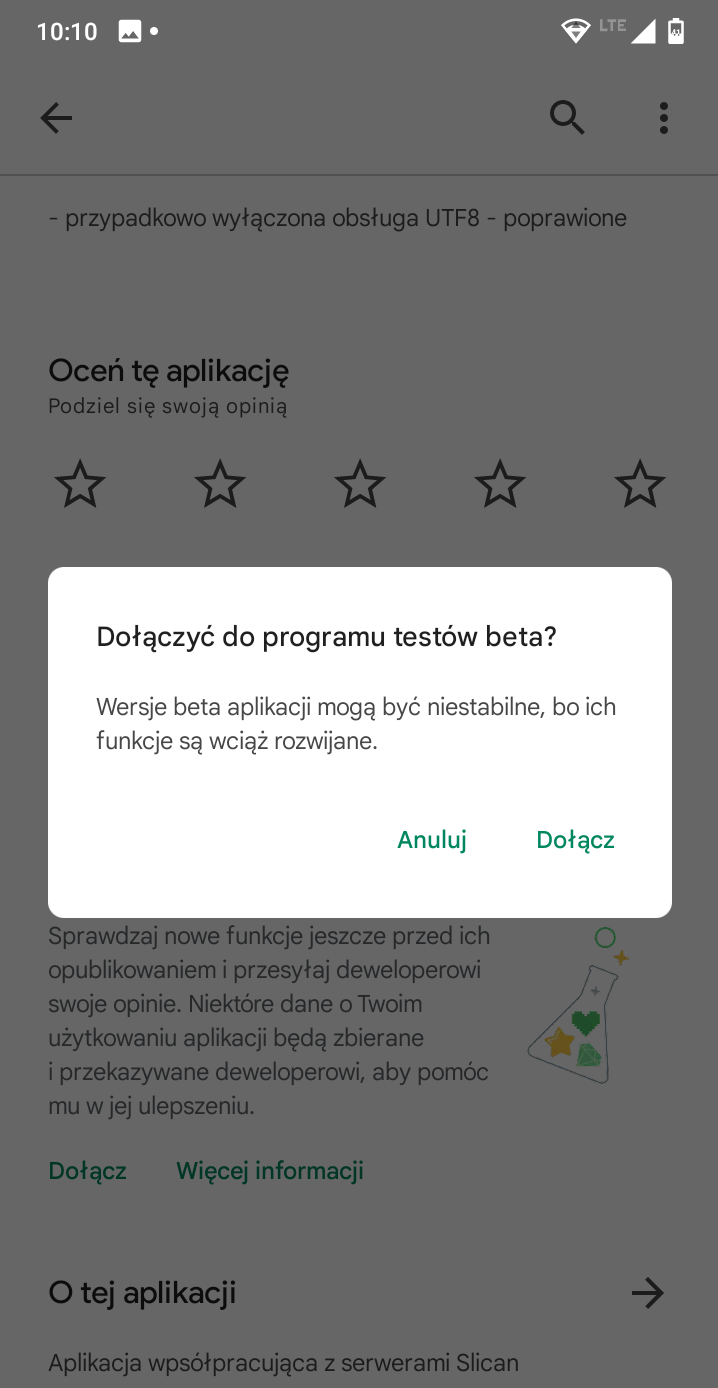Difference between revisions of "User:Leszekj"
(→Chat) |
(→Installing beta version) |
||
| (37 intermediate revisions by the same user not shown) | |||
| Line 1: | Line 1: | ||
| − | = | + | = Aplication structure= |
| Line 11: | Line 11: | ||
* handling voice calls in VoIP mode both via GSM operator's Internet network (LTE, HSPA) and WiFi network | * handling voice calls in VoIP mode both via GSM operator's Internet network (LTE, HSPA) and WiFi network | ||
* handling voice calls in GSM mode | * handling voice calls in GSM mode | ||
| − | * chat | + | * chat, text conference and text announcements |
* voice conference | * voice conference | ||
* access to contact book with preview of other subscriber's availability status (chat, phone status, description, application) | * access to contact book with preview of other subscriber's availability status (chat, phone status, description, application) | ||
| Line 17: | Line 17: | ||
* history of recent calls / chats - sorted chronologically | * history of recent calls / chats - sorted chronologically | ||
* full synchronization with MessengerCTI.Desktop application | * full synchronization with MessengerCTI.Desktop application | ||
| + | * logging in as parallel phone to deskphone or as separate MCTI subscriber (only in NCP PBX) | ||
* possibility to copy text from / to chat | * possibility to copy text from / to chat | ||
* flexible configuration of sound and vibration notifications with possibility of using schedules | * flexible configuration of sound and vibration notifications with possibility of using schedules | ||
| Line 22: | Line 23: | ||
* quick reference numbers for fast call transfer | * quick reference numbers for fast call transfer | ||
* ability to set desk phone busy if user's smartphone is busy (enabled by default) | * ability to set desk phone busy if user's smartphone is busy (enabled by default) | ||
| − | * rejection calls on user's GSM smatphone if | + | * rejection calls on user's GSM smatphone if deskphone is busy |
* ability to use DualSIM smartphones or two phones at same time (business and private) | * ability to use DualSIM smartphones or two phones at same time (business and private) | ||
* convenient door opening in case of calls from DPH.IP doorphone (from application connection window, contact context menu or desktop widget) | * convenient door opening in case of calls from DPH.IP doorphone (from application connection window, contact context menu or desktop widget) | ||
| Line 28: | Line 29: | ||
* ability to copy contacts from PBX contact book to local smartphone book | * ability to copy contacts from PBX contact book to local smartphone book | ||
* sharing your own location | * sharing your own location | ||
| − | * ability to transfer files (drag & drop) | + | * ability to transfer photos and files (drag & drop) |
* handy clipboard for sharing data between mobile and desktop application | * handy clipboard for sharing data between mobile and desktop application | ||
| + | * support for emoticons | ||
| + | * making calls from external number sources | ||
* available in Google Play store (free) | * available in Google Play store (free) | ||
| Line 40: | Line 43: | ||
* MessengerCTI.userPlus license per user at PBX | * MessengerCTI.userPlus license per user at PBX | ||
* optional, depending on adopted configuration - license for VoIP subscribers in NCP or subscribers and VoIP channels in IPx, MAC, CCT exchanges | * optional, depending on adopted configuration - license for VoIP subscribers in NCP or subscribers and VoIP channels in IPx, MAC, CCT exchanges | ||
| + | * opening door using context menu or widget available only after starting ACS system | ||
}} | }} | ||
| Line 47: | Line 51: | ||
===VoIP and GSM client=== | ===VoIP and GSM client=== | ||
* '''MessengerCTI.Mobile''' - parallel telephone, associated with equipment of desk phone (FXS, CTS, SIP). Application can work as VoIP or GSM client. User decides on which device to answer call and make call - by desk phone or smartphone. Novelty is possibility of using application as standalone telephone in NCP (from firmware version 1.11). CTIuserPlus license is required for its correct operation. | * '''MessengerCTI.Mobile''' - parallel telephone, associated with equipment of desk phone (FXS, CTS, SIP). Application can work as VoIP or GSM client. User decides on which device to answer call and make call - by desk phone or smartphone. Novelty is possibility of using application as standalone telephone in NCP (from firmware version 1.11). CTIuserPlus license is required for its correct operation. | ||
| − | * Configuration in VoIP mode - basic configuration for using application. Both calls made and other information, e.g. about the caller's number, contacts in book, subscriber status, chats - are sent over IP network (WiFi, LTE/ HSPA Internet) | + | * '''Configuration in VoIP mode''' - basic configuration for using application. Both calls made and other information, e.g. about the caller's number, contacts in book, subscriber status, chats - are sent over IP network (WiFi, LTE/ HSPA Internet) |
| − | * Configuration in GSM mode - it is most often used if access to IP network or Internet in given location is weak (insufficient for VoIP calls) or unstable. All information and signaling - are still sent via IP network (WiFi, LTE / HSPA), but calls themselves are carried out by GSM operator. With poor IP transmission quality, you should take into account that information may not always be displayed. | + | * '''Configuration in GSM mode''' - it is most often used if access to IP network or Internet in given location is weak (insufficient for VoIP calls) or unstable. All information and signaling - are still sent via IP network (WiFi, LTE / HSPA), but calls themselves are carried out by GSM operator. With poor IP transmission quality, you should take into account that information may not always be displayed. |
Switching between VoIP and GSM mode can be done by user from application configuration (if PBX is properly configured). | Switching between VoIP and GSM mode can be done by user from application configuration (if PBX is properly configured). | ||
| Line 84: | Line 88: | ||
For installing application minimum requirements must be met: | For installing application minimum requirements must be met: | ||
* Android operating system | * Android operating system | ||
| − | ** minimum version: | + | ** minimum version: Android 6.0 Marshmallow |
** minimum recommended version: Nougat 7.0 | ** minimum recommended version: Nougat 7.0 | ||
** PBX and application must have access to internet | ** PBX and application must have access to internet | ||
| − | Phone with lower version of operating system then | + | Phone with lower version of operating system then 6.0 won't be able to install application. |
{{Attention!| | {{Attention!| | ||
| Line 93: | Line 97: | ||
* better call stability | * better call stability | ||
* option of automatic regaining voice connection after reloging to network or changing IP | * option of automatic regaining voice connection after reloging to network or changing IP | ||
| − | * option of | + | * option of ajusting microphone gain for VoIP calls |
}}<br> | }}<br> | ||
| Line 104: | Line 108: | ||
| − | During installation, you are prompted to provide some permissions. You can approve all of them or select only those related to functionalities that will be used: | + | During installation, you are prompted to provide some permissions. They may vary depending on Android version and phone type. You can approve all of them or select only those related to functionalities that will be used: |
| − | * Camera - for scanning QR code and taking and | + | * Camera - for scanning QR code (configuration) and taking and sending photos |
* Location - to share your location | * Location - to share your location | ||
* Microphone - for making VoIP calls | * Microphone - for making VoIP calls | ||
| Line 111: | Line 115: | ||
* Phone - for using application in GSM mode | * Phone - for using application in GSM mode | ||
* Contacts - for copying contacts to local phone database (used only in some versions of application) | * Contacts - for copying contacts to local phone database (used only in some versions of application) | ||
| + | * Displaying above other applications - should be made, available so that you can answer call correctly when application is, for example: deep sleep | ||
| + | * Disable battery optimization - Battery optimization for app must be disabled to prevent it from going into deep sleep | ||
| Line 134: | Line 140: | ||
* Self-signed certificate | * Self-signed certificate | ||
* Read data from QRCode: instead of manual configuration - ability to scan QR code sent from NCP to user's e-mail box when configuring CTI settings or from WebCTI website | * Read data from QRCode: instead of manual configuration - ability to scan QR code sent from NCP to user's e-mail box when configuring CTI settings or from WebCTI website | ||
| + | * Advanced/Port signaling protocol: communication port PBX - default for PBX is TCP 5529 | ||
<center>[[File:MessengerCTI.Desktop_1.07_Account_configuration_en.png |600px]]</center> | <center>[[File:MessengerCTI.Desktop_1.07_Account_configuration_en.png |600px]]</center> | ||
| − | Using QRcode from WebCTI -> My subscriber account or link to code sent to user's e-mail address (only in NCP PBX with configured e-mail client) | + | Using QRcode from WebCTI -> My subscriber account or link to code sent to user's e-mail address (only in NCP PBX with properly configured e-mail client) |
<center>[[File:MessengerCTI.Desktop_1.07_Account_QRcode_en.png |1000px]]</center> | <center>[[File:MessengerCTI.Desktop_1.07_Account_QRcode_en.png |1000px]]</center> | ||
| − | |||
===Calls=== | ===Calls=== | ||
| Line 170: | Line 176: | ||
* Global services for PBX: | * Global services for PBX: | ||
** DND - do not disturb | ** DND - do not disturb | ||
| − | ** busy | + | ** Deskphone is busy when GSM is talking - during call on GSM phone - primary phone (deskphone) and thus MessnegerCTI.mobile application is not supposed to ring during incoming calls (test functionality, it does not work with every GSM phone) |
| − | + | ||
** FWD - call forwarding settings: all, busy or no answer | ** FWD - call forwarding settings: all, busy or no answer | ||
| Line 177: | Line 182: | ||
Setting your own comment, which will be visible to other users of MessengerCTI application (desktop and mobile) and on screen of CTS-330 system phone | Setting your own comment, which will be visible to other users of MessengerCTI application (desktop and mobile) and on screen of CTS-330 system phone | ||
| − | + | ==Notifications== | |
| − | Configuring incoming call notifications: | + | '''Configuring incoming call notifications:''' |
* ringtone: selecting one from list available in application with option to mute it after specified time | * ringtone: selecting one from list available in application with option to mute it after specified time | ||
| + | * turn off ringing after x seconds - setting optimal length of ringing time | ||
* vibration when ringing | * vibration when ringing | ||
| − | + | * notification schedule for call ringtone - set weekly active use plan (ringtone in selected time ranges) | |
| − | * notification schedule for call ringtone - set weekly active use plan ( | + | |
| − | Configuring chat message notifications: | + | '''Configuring missed calls notifications:''' |
| − | * message tone: selecting one from the list available in | + | * notify about missed call - if missed call happens, MessengerCTI icon with option to preview message will appear on Android notification bar, in upper part of smartphone screen |
| + | |||
| + | |||
| + | '''Configuring chat message notifications:''' | ||
| + | * notify about chat messages - enable notifications | ||
| + | * message tone: selecting one from the list available in application | ||
* vibration on message | * vibration on message | ||
| − | * notification | + | * notification schedule for chat message - set weekly active use plan (notifications in selected time ranges) |
| − | + | ||
| − | + | '''Notifications based on activity on other devices::''' | |
| − | + | Functionality that allows to enable intelligent response to incoming call/notifications of MessengerCTI.mobile application. It introduces 10-second delay notification MessengerCTI.mobile relative to ringing associated phone (usually deskphone). | |
| + | |||
| + | After starting MessengerCTI.mobile - desk phone and application will ring simultaneously during incoming call. If we answer first to desk phone, application will "remember" that we nearby phone and will delay ringing application during next call. | ||
| − | |||
It ceases to apply when: | It ceases to apply when: | ||
| Line 202: | Line 212: | ||
* we will pick up call with MessengerCTI.Mobie | * we will pick up call with MessengerCTI.Mobie | ||
| − | + | ==Quick transfer== | |
List of 3 most important user reference numbers (extensions or outside from PBX) displayed during call for easy call transfer. | List of 3 most important user reference numbers (extensions or outside from PBX) displayed during call for easy call transfer. | ||
| − | |||
| − | |||
| − | |||
| − | |||
| − | |||
| − | |||
| − | |||
| − | |||
| − | |||
| − | |||
| − | |||
| − | |||
| − | |||
| − | |||
| − | |||
== About== | == About== | ||
Information about: | Information about: | ||
| − | * Own number: PBX | + | * Own number: PBX ext. number to which application is logged in |
* Own comment: subscriber comment | * Own comment: subscriber comment | ||
| − | * Current | + | * Current application version |
* Type and number of connected PBX | * Type and number of connected PBX | ||
* PBX firmware version | * PBX firmware version | ||
| + | * XML encoding | ||
| + | * Battery optimization | ||
| + | * Privacy policy | ||
| + | * Used libraries | ||
* Link to send application logs | * Link to send application logs | ||
| Line 365: | Line 364: | ||
==Making calls== | ==Making calls== | ||
You can make calls in several ways: | You can make calls in several ways: | ||
| − | + | # from '''Contacts''' tab - select subscriber from appropriate group (if such in PBX contacts are created) or directly from All contacts group. Call is made by tapping contact and then selecting '''Dial''' icon [[File: MessengerCTIM outgoing.png |25px]] from drop-down menu | |
| − | + | # from '''Last''' tab - you find from history we are interested in contacting subscriber (we had conversation with him, he called us or made call to him, we sent or received message from him). Call is made by tapping contact and then selecting '''Dial''' icon [[File: MessengerCTIM outgoing.png | 25px]] from drop-down menu | |
| − | + | # in '''Search''' field by entering telephone number or subscriber's name directly from keypad, and then by tapping green receiver on right side | |
| − | + | # from numeric keypad opened in lower right corner of '''Last''' tab | |
| + | # from another source of numbers, e.g. website, google calendar | ||
| + | |||
| + | '''Screenshots presenting different types of connection are below''' | ||
| + | |||
<center> | <center> | ||
| Line 376: | Line 379: | ||
[[File:MessengerCTI.Mobile 1.07 Outgoing call3 en.png|250px]] | [[File:MessengerCTI.Mobile 1.07 Outgoing call3 en.png|250px]] | ||
[[File:MessengerCTI.Mobile 1.07 Outgoing call4 en.png|250px]] | [[File:MessengerCTI.Mobile 1.07 Outgoing call4 en.png|250px]] | ||
| + | [[File:MessengerCTI.mobile 1.07 Pusty.png|50px]] | ||
| + | [[File:MessengerCTI.Mobile 1.08 Outgoing foreign call en.png|257px]] | ||
</center> | </center> | ||
| Line 502: | Line 507: | ||
Sample message exchange dialog: | Sample message exchange dialog: | ||
| − | |||
| − | |||
| − | |||
| − | |||
| − | |||
| − | |||
| − | |||
| − | |||
<center> | <center> | ||
| − | [[File:MessengerCTI.mobile 1. | + | [[File:MessengerCTI.mobile 1.08 Chat en.png|250px]] |
[[File:MessengerCTI.mobile 1.07 Pusty.png|50px]] | [[File:MessengerCTI.mobile 1.07 Pusty.png|50px]] | ||
| − | [[File:MessengerCTI.mobile 1.07 | + | [[File:MessengerCTI.mobile 1.07 Chat en.png|250px]] |
| − | + | ||
| − | + | ||
</center> | </center> | ||
| − | ''' | + | You can also use standard emoticons in your messages (including text conferences and text announcements described in section below). By clicking on '''Type your message''' field or while typing text, with keyboard activated, special key is available - opening access to emoticons. |
| − | + | ||
| − | + | ||
| − | + | ||
| − | + | ||
| − | + | ||
| − | + | ||
| − | + | ||
| − | |||
| − | |||
| − | |||
| − | |||
<center> | <center> | ||
| − | [[ | + | [[File:MessengerCTI.Mobile 1.08 Chat Emoticons 1 en.png|250px]] |
| + | [[File:MessengerCTI.mobile 1.07 Pusty.png|50px]] | ||
| + | [[File:MessengerCTI.Mobile 1.08 Chat Emoticons 2 en.png|250px]] | ||
</center> | </center> | ||
| − | == | + | ==Text and voice conference== |
| − | + | ||
| − | + | ||
| − | + | ||
| − | + | ||
| − | + | ||
| − | + | ||
| − | + | ||
| − | + | ||
| − | + | ||
| − | + | '''Conference preparation:''' | |
| − | + | * on taskbar, select icon [[File:MessengerCTI.mobile_1.07_Taskbar_-_conference en.png|250px]] | |
| − | + | * give name | |
| − | + | * select and accept participants | |
| − | + | ||
| − | |||
| − | |||
| − | |||
| − | |||
| − | |||
| − | |||
| − | |||
| − | |||
| − | |||
| − | |||
| − | |||
| − | |||
| − | |||
| − | |||
| − | |||
| − | |||
| − | |||
| + | <center> | ||
| + | [[File:MessengerCTI.mobile 1.08 Conference1 en.png|250px]] | ||
| + | [[File:MessengerCTI.mobile 1.07 Pusty.png|50px]] | ||
| + | [[File:MessengerCTI.mobile 1.07 Conference2 en.png|250px]] | ||
| + | [[File:MessengerCTI.mobile 1.07 Pusty.png|50px]] | ||
| + | [[File:MessengerCTI.mobile 1.07 Conference3 en.png|250px]] | ||
| + | [[File:MessengerCTI.mobile 1.07 Pusty.png|50px]] | ||
| + | [[File:MessengerCTI.mobile 1.07 Conference5 en.png|250px]] | ||
| + | </center> | ||
| − | |||
| − | |||
| − | |||
| − | |||
| − | |||
| − | + | '''Announcement preparation:''' | |
| − | + | ||
| − | + | ||
| − | + | ||
| − | + | ||
| − | + | ||
| − | + | ||
| − | + | ||
| − | + | An announcement is specific form of conference. It is used to send information unilaterally to many users, without possibility of interaction on their part. | |
| − | + | ||
| − | + | ||
| − | + | ||
| − | + | ||
| − | + | ||
| − | + | ||
| − | + | ||
| − | + | ||
| − | + | ||
| − | + | ||
| − | + | ||
| − | + | ||
| + | Preparing announcement is similar to other conferences (text and voice). When creating it, instead of '''Conference type: Normal''' we choose '''Announcement''' type. | ||
| − | |||
| − | |||
| − | |||
| − | + | <center> | |
| − | < | + | [[File:MessengerCTI.Mobile 1.08 Announcement en.png|250px]] |
| + | </center> | ||
| − | |||
| − | |||
| − | |||
| − | |||
| − | |||
| − | |||
| − | |||
| − | + | '''Start conference:''' | |
| − | + | * '''in case of text conference''' - go to main application window and LAST tab, then click on created conference | |
| − | + | ||
| − | - | + | |
| − | + | ||
| − | + | ||
| − | + | ||
| − | + | ||
| − | + | ||
| − | + | ||
| − | + | ||
| − | + | ||
| − | + | ||
| − | + | ||
| − | + | ||
| − | + | ||
| − | + | ||
| − | + | ||
| − | + | <center> | |
| + | [[File:MessengerCTI.mobile 1.08 Conference 4 en.png|250px]] | ||
| + | [[File:MessengerCTI.mobile 1.07 Pusty.png|50px]] | ||
| + | [[File:MessengerCTI.mobile 1.08 Conference 5 en.png|250px]] | ||
| + | [[File:MessengerCTI.mobile 1.07 Pusty.png|50px]] | ||
| + | [[File:MessengerCTI.mobile 1.07 Conference6 en.png|250px]] | ||
| + | </center> | ||
| − | |||
| − | |||
| − | |||
| − | |||
| − | + | * '''in case of voice conference''' - go to main application window and LAST tab, then click on created conference | |
| − | |||
| − | + | <center> | |
| − | + | [[File:MessengerCTI.mobile 1.08 Conference 4 en.png|250px]] | |
| − | + | [[File:MessengerCTI.mobile 1.07 Pusty.png|50px]] | |
| − | + | [[File:MessengerCTI.mobile 1.08 Conference 8 en.png|250px]] | |
| + | [[File:MessengerCTI.mobile 1.07 Pusty.png|50px]] | ||
| + | [[File:MessengerCTI.mobile 1.07 Conference7 en.png|250px]] | ||
| + | </center> | ||
| − | + | * '''in case of advertisement''' - go to main application window and LAST tab, then click on created advertisement | |
| − | * | + | |
| − | + | ||
| − | + | ||
| − | [[File: | + | <center> |
| − | + | [[File:MessengerCTI.mobile 1.08 Announcement 1 en.png|250px]] | |
| + | [[File:MessengerCTI.mobile 1.07 Pusty.png|50px]] | ||
| + | [[File:MessengerCTI.mobile 1.08 Announcement 2 en.png|250px]] | ||
| + | [[File:MessengerCTI.mobile 1.07 Pusty.png|50px]] | ||
| + | [[File:MessengerCTI.mobile 1.08 Announcement 3 en.png|250px]] | ||
| + | </center> | ||
| − | |||
| − | |||
| + | '''Edit conference:''' | ||
| + | * in Participants tab, click [[File: MessengerCTI.mobile 1.07 Conference - edition.png | 40px]] | ||
| + | * changes to settings are possible both when the conference is inactive and during its duration | ||
| + | * available actions are shown in the graphic below | ||
| + | <center> | ||
| + | [[File:MessengerCTI.mobile 1.07 Conference8 en.png|250px]] | ||
| + | </center> | ||
| − | + | =Additional features= | |
| − | + | ||
| − | + | ||
| − | + | ||
| − | + | ==Uploading files and photos== | |
| − | + | This functionality is used to exchange files, documents and photos between different users of MessengerCTI application (mobile and desktop) | |
| − | + | ||
| − | + | User in '''Contacts''' or '''Last''' tab clicks on application status [[File:MessengerCTI.mobile 1.07 Send file1 en.png |250px]] another user, knocks on sign '''+''' next to field '''''Type your message''''', selects one of available options: | |
| − | [[File:MessengerCTI. | + | * '''''Attach file''''' |
| − | + | * '''''Attach picture''''' | |
| − | * | + | * '''''Take a photo''''' |
| − | * | + | then points to file or takes photo and confirms |
| − | + | ||
| − | * | + | |
| − | + | ||
| − | + | ||
| − | + | ||
| − | + | <center> | |
| − | + | [[File:MessengerCTI.mobile 1.07 Send file en.png|250px]] | |
| + | </center> | ||
| − | == | + | ==Clipboard== |
| − | + | '''Clipboard''' - it is used to exchange messages, documents and files between Mobile and Desktop versions of user's MessengerCTI application. | |
| − | + | To start it, tap icon [[File:MessengerCTI.mobile 1.07 Bar clipboard en.png|250px]] and next: | |
| − | + | * in field '''''Type your message''''' type text, or | |
| − | * | + | * tap '''+''' next field '''''Type your message''''' and select one of available options: |
| − | + | ** '''''Attach file''''' | |
| − | + | ** '''''Attach picture''''' | |
| − | + | ** '''''Take a photo''''' | |
| − | + | and then select file or take a photo and confirm | |
| − | + | ||
| − | + | ||
| − | + | ||
| − | + | ||
| − | + | ||
| − | + | ||
| − | + | ||
| − | + | ||
| − | + | ||
| − | + | ||
| − | + | ||
| − | + | ||
| − | + | ||
| − | + | ||
| − | + | ||
| − | + | ||
| − | + | ||
| − | + | ||
| − | + | ||
| − | + | ||
| − | + | ||
| − | ''''' | + | |
| − | + | ||
| − | + | ||
| − | + | ||
<center> | <center> | ||
| − | + | [[File:MessengerCTI.mobile 1.07 Clipboard en.png|250px]] | |
| − | + | ||
| − | + | ||
| − | + | ||
| − | + | ||
| − | + | ||
| − | + | ||
| − | + | ||
| − | + | ||
| − | + | ||
| − | + | ||
| − | + | ||
| − | + | ||
| − | + | ||
</center> | </center> | ||
| − | |||
| − | == | + | ==Send location== |
| − | + | There is possibility to observe location between MessengerCTI.Mobile users (only with consent of person being watched): | |
| + | * '''User A asks User B for location permission''' (he has several variants to choose from) | ||
| + | * User B approves request | ||
| + | * User A receives link to google maps with current location of User B | ||
| − | |||
| − | |||
| − | <center>[[File:MessengerCTI. | + | <center> |
| + | [[File:MessengerCTI.mobile 1.07 Location1 en.png|250px]] | ||
| + | [[File:MessengerCTI.mobile 1.07 Location2 en.png|250px]] | ||
| + | [[File:MessengerCTI.mobile 1.07 Pusty.png|50px]] | ||
| + | [[File:MessengerCTI.mobile 1.07 Location3 en.png|350px]] | ||
| + | [[File:MessengerCTI.mobile 1.07 Pusty.png|50px]] | ||
| + | [[File:MessengerCTI.mobile 1.07 Location4 en.png|250px]] | ||
| + | [[File:MessengerCTI.mobile 1.07 Location5 en.png|250px]] | ||
| + | </center> | ||
| − | |||
| − | + | or: | |
| − | * | + | * '''User B decides to send location to User A''' |
| − | + | * User B in Contacts or Last tab clicks on status of User A application, knocks on '''+''' sign next to '''Type your message''' field and then selects '''Send location''' option | |
| − | + | * User A receives link to google maps with current location of User B | |
| − | * | + | |
| − | * | + | |
| − | + | ||
| − | + | ||
| − | + | ||
| − | + | <center> | |
| − | + | [[File:MessengerCTI.mobile 1.07 Location6 en.png|250px]] | |
| − | + | [[File:MessengerCTI.mobile 1.07 Pusty.png|50px]] | |
| − | + | [[File:MessengerCTI.mobile 1.07 Location7 en.png|250px]] | |
| + | [[File:MessengerCTI.mobile 1.07 Pusty.png|50px]] | ||
| + | [[File:MessengerCTI.mobile 1.07 Location4 en.png|250px]] | ||
| + | [[File:MessengerCTI.mobile 1.07 Location5 en.png|250px]] | ||
| + | </center> | ||
| − | + | ==Contacts== | |
| + | '''Contacts''' tab - [[File:MessengerCTI.mobile_1.07_Contacts_en.png|250px]] - allows to view and perform selected actions related to contact. Contacts can be grouped. Access to numbers from other groups can be obtained by expanding list: | ||
| + | * Favourites | ||
| + | * All groups | ||
| + | * All contacts | ||
| + | * Internal | ||
| + | * External | ||
| + | * Private | ||
| + | * plus user-created groups | ||
| + | By default, group '''Favorites''' is visible | ||
| − | |||
| − | |||
| − | |||
| − | |||
| + | <center> | ||
| + | [[File:MessengerCTI.mobile 1.07 Contacts2 en.png|250px]] | ||
| + | [[File:MessengerCTI.mobile 1.07 Pusty.png|50px]] | ||
| + | [[File:MessengerCTI.mobile 1.07 Contacts3 en.png|250px]] | ||
| + | </center> | ||
| − | + | Adding contact to your favorites: | |
| − | + | In '''Contacts''' tab we hold name of selected subscriber. Confirm when prompted with option '''''Add contact to favorites''''' | |
| − | In | + | |
| − | + | ||
| − | + | ||
| − | + | ||
| − | + | ||
| − | + | ||
| − | + | ||
| − | + | ||
| − | + | ||
| − | + | ||
| − | + | ||
| − | + | ||
| − | + | ||
| − | + | ||
| − | + | ||
| − | + | ||
| − | + | ||
| − | + | ||
| − | + | ||
| − | + | ||
| − | + | ||
| − | + | ||
| − | + | ||
| − | + | ||
| − | + | ||
| − | + | ||
| − | + | ||
| − | + | ||
| − | + | ||
| − | + | ||
| − | + | ||
| − | + | ||
| − | + | ||
| − | + | ||
| − | + | ||
| − | + | ||
| − | + | ||
| − | + | ||
| − | + | ||
| − | + | ||
| − | + | ||
| − | + | ||
| − | + | ||
| − | + | ||
| − | + | ||
| − | + | ||
| − | + | ||
| − | + | ||
| − | + | ||
| − | + | ||
| − | + | ||
| − | + | ||
| − | + | ||
| − | + | ||
| − | + | ||
| − | + | ||
| − | + | ||
| − | + | ||
| − | + | ||
| − | + | ||
| − | + | ||
| − | + | ||
| − | + | ||
| − | + | ||
| − | + | ||
| − | + | ||
| − | + | ||
| − | + | ||
| − | + | ||
| − | + | ||
| − | + | ||
| − | + | ||
| − | + | ||
| − | + | ||
| − | + | ||
| − | + | ||
| − | + | ||
| − | + | ||
| − | + | ||
| − | + | ||
| − | + | ||
| − | + | ||
| − | + | ||
| − | + | ||
| − | + | ||
| − | + | ||
| − | + | ||
| − | + | ||
| − | + | ||
| − | + | ||
| − | + | ||
| − | + | ||
| − | + | ||
| − | + | ||
| − | + | ||
| − | + | ||
| − | + | ||
| − | + | ||
| − | + | ||
| − | + | ||
| − | + | ||
| − | + | ||
| − | + | ||
| − | + | ||
| − | + | ||
| − | + | ||
| − | + | ||
| − | + | ||
| − | + | ||
| − | + | ||
| − | + | ||
| − | + | ||
| − | + | ||
| − | + | ||
| − | + | ||
| − | + | ||
| − | + | ||
| − | + | ||
| − | + | ||
| − | + | ||
| − | + | ||
| − | + | ||
| − | + | ||
| − | + | ||
| − | + | ||
| − | + | ||
| − | + | ||
| − | + | ||
| − | + | ||
| − | + | ||
| − | + | ||
| − | + | ||
| − | + | ||
| − | + | ||
| − | + | ||
| − | + | ||
| − | + | ||
| − | + | ||
| − | + | ||
| − | + | ||
| − | + | ||
| − | + | ||
| − | + | ||
| − | + | ||
| − | + | ||
| − | + | ||
| − | + | ||
| − | + | ||
| − | + | ||
| − | + | ||
| − | + | ||
| − | + | ||
| − | + | ||
| − | + | ||
| − | + | ||
| − | + | ||
| − | + | ||
| − | + | ||
| − | + | ||
== Call history == | == Call history == | ||
| − | + | Default tab - [[File: MessengerCTI.mobile 1.07 Call History1 en.png|250px]] - displays history of calls and messages. | |
| + | Each entry in tab signifies at least one call or message. If there were more calls (missed) or messages (unread) from same user, his entry is highlighted (bold) and number calls/messages is displayed in as red dot next to relevant icon. | ||
| − | |||
| − | + | Each field shows (from left): | |
| + | * application status icon, icon that user is not using application or door station status | ||
| + | * name (if saved in phonebook) | ||
| + | * caller number | ||
| + | * icon indicating phone call or text message | ||
| + | * date or time when call was made | ||
| − | + | If tab contains unread missed calls or unread messages, red dot is displayed next to ''' Last '''. From tab it is possible to call back or send back messages. By tapping on username, we go to detailed history of calls and messages. | |
| − | + | ||
| − | [[File: | + | <center>[[File:MessengerCTI.mobile 1.07 Call History2 en.png|250px]]</center> |
| − | + | ||
| − | + | =Configuring Slican PBX= | |
| − | + | For proper communication between application and PBX are required: | |
| + | * correct manufacturer license | ||
| + | * specific PBX configuration | ||
| + | ==IPx, CCT PBX configuration== | ||
| + | With ConfigMan software: | ||
| + | # Inside '''''Global settings->Global settings/Remain''''' tab: | ||
| + | ## '''ANo''':configure access number that application will chose for making call to PBX and setting up incoming call | ||
| + | ## '''Adr''': public host name or PBX IP address for connecting to application (for VoIP calls with application) | ||
| + | # Inside '''Subscribers''' menu, '''''Tables''''' then '''''Subscribers->Subscribers/CTI settings''''': | ||
| + | ## '''AwdMbl''': allow access to MessengerCTI.Mobile application | ||
| + | ## '''AwdGSM''': allows to connect phone calls through GSM network | ||
| + | ## '''IncC''': setting up method of how application connects incoming calls: | ||
| + | ### Call pickup - picking up incoming call with application means making outgoing call with GSM phone to number from '''ANo''' field inside '''''Global settings/Remain''''' | ||
| + | ### Parrallel calling - incoming calls to GSM phone from number set in '''ANo''' field inside ''''' Global settings/Remain''''' | ||
| + | ## '''MnNo''': configure GSM phone access number, on which application is installed, optionally configure second number (for dual SIM phones) | ||
| + | ## '''SecNo''': second GSM phone number with installed application (optional, for dual SIM phones) | ||
| − | |||
| − | |||
| − | |||
| − | + | For application to work with each settings, these fields parameters must be set: | |
| − | , | + | * VoIP network: 1.2, 2.1 |
| + | * GSM network: 1.1, 2.1, 2.2, 2.3, 2.3.1 or 2.3.2, 2.4 (plus possibly 2.5) | ||
| + | |||
| + | <font color=red>'''Minimum PBX firmware version - 6.53, for VoIP - 6.54'''</font> | ||
| + | ==NCP PBX configuration== | ||
| + | From ConfigWEB application: | ||
| + | # '''''Extensions/ Settings->Informations about CTI settings for subscribers and applications''''' menu, configure: | ||
| + | ## Public host name or PBX IP address for XML Slican protocol - domain name or IP address for exchanging/synchronisation information and data between application and PBX | ||
| + | ## Public host name or PBX IP address for VoIP calls - domain name or IP address for configuring VoIP calls | ||
| + | ## PBX number for GSM calls - which will call GSM phone with installed application to call PBX or PBX to application and set up call (in configuration with support for connections via GSM network) | ||
| + | # configure subscribers for SIP, FXS, CTS, MCTI with '''''Extensions/Subscribers-> Subscriber/CTI Settings/MessengerCTI.Mobile''''' | ||
| + | ## Allow access to MessengerCTI.Mobile application | ||
| + | ## if using GSM network allow phone calls handling using GSM | ||
| + | ### set up GSM phone access number for device with installed application | ||
| + | ### set up second GSM phone number with installed applicatio (optional, for dual SIM devices) | ||
| + | ## set up incoming calls handling | ||
| + | ### call pickup - picking up incoming call with application is achievied by GSM phone making outgoing call to number set in '''''Extensions/ Settings/ Informations about CTI settings for subscribers and applications/ Phone number to call this PABX using GSM connection''''' | ||
| + | ### Parallel calling - incoming call to GSM phone from number set with '''''Extensions/ Settings/ Informations about CTI settings for subscribers and applications/ Phone number to call this PABX using GSM connection''''' | ||
| − | |||
| − | + | For application to work, these fields must be set: | |
| − | + | * VoIP: 1.1, 1.2, 2.1 | |
| − | + | * GSM: 1.1, 1.3, 2.1, 2.2, 2.2.1, 2.2.2, 2.3 and 2.3.1 or 2.3.2 | |
| − | + | ||
| − | + | ||
| − | + | ||
| − | + | ||
| − | + | ||
| − | + | ||
| − | + | ||
| − | + | ||
| − | + | ||
| − | + | ||
| − | + | ||
| − | + | ||
| − | + | ||
| − | + | ||
| − | + | ||
| − | + | ||
| − | + | ||
| − | + | ||
| − | + | ||
| − | + | ||
| − | + | ||
| − | + | ||
| − | * | + | |
| − | + | ||
| − | + | ||
| − | + | ||
| − | + | ||
| − | + | ||
| − | + | ||
| − | + | ||
| − | + | ||
| − | + | ||
| − | + | ||
| − | + | ||
| − | + | ||
| − | + | ||
| − | + | ||
| − | + | ||
| − | + | ||
| − | + | ||
| − | + | ||
| − | + | ||
| − | + | ||
| − | + | ||
| − | + | ||
| − | + | ||
| − | + | ||
| − | + | ||
| − | + | ||
| − | + | ||
| − | + | ||
| − | + | ||
| − | + | ||
| − | + | ||
| − | + | ||
| − | + | ||
| − | + | ||
| − | + | ||
| − | + | ||
| − | + | ||
| − | + | ||
| − | + | ||
| − | + | ||
| − | + | ||
| − | + | ||
| − | + | ||
| − | + | ||
| − | + | ||
| − | + | ||
| − | + | ||
| − | + | ||
| − | + | ||
| − | + | ||
| − | + | ||
| − | + | ||
| − | + | ||
| − | + | ||
| − | + | ||
| − | + | ||
| + | |||
| + | <font color=red>'''Minimum PBX firmware version - 1.11, for VoIP - 1.12'''</font> | ||
| − | =Ports and protocols= | + | =Ports and protocols = |
| − | Default port numbers and types | + | Default port numbers and protocol types used by PBX for purposes of providing selected services of MessengerCTI.Mobile application. |
'''Basic:''' | '''Basic:''' | ||
| − | * | + | * signalization |
** 5529 TCP - application signaling (XML) | ** 5529 TCP - application signaling (XML) | ||
| − | ** 5543 TCP - signaling in | + | ** 5543 TCP - signaling in enabled encryption tag mode (XML) |
* VoIP calls | * VoIP calls | ||
** 5060 UDP - SIP signaling (for VoIP calls) | ** 5060 UDP - SIP signaling (for VoIP calls) | ||
| − | ** 8100 - 8300 UDP - | + | ** 8100 - 8300 UDP - acoustic - for IPx, CCT, MAC PBX |
| − | ** 10000 - 20000 UDP - | + | ** 10000 - 20000 UDP - acoustic - for NCP PBX |
'''Additional:''' | '''Additional:''' | ||
| − | * file transfer - | + | * file transfer - only NCP (clipboard, between users): |
| − | ** 443 TCP - file | + | ** 443 TCP - file transfer without encryption tag enabled (transmission is still HTTPS encrypted) |
| − | ** 5543 TCP - file | + | ** 5543 TCP - file transfer of files with encryption tag enabled |
* image transmission from DPH.IP doorphone camera | * image transmission from DPH.IP doorphone camera | ||
| − | ** | + | ** link to camera in PBX location of: |
| − | *** NCP: Extensions/ Devices/ Cameras | + | *** NCP: Extensions/Devices/Cameras |
| − | *** IPx, MAC, CCT: | + | *** IPx, MAC, CCT: Pheripherals/Cameras |
| − | ** | + | ** During a call, PBX sends camera link to application MessengerCTI: rtsp://IP_address_camera:554/login_password_additional_information |
| − | '''Example for NCP for MessengerCTI working from outside | + | '''Example for NCP for MessengerCTI working from outside NCP IP network (configuration in ConfigWEB):''' |
| − | * XML signaling, VoIP, file | + | * XML signaling, VoIP, file transfer - Extensions/Settings/Informations about CTI settings for subscribers and applications tab |
| − | * | + | * image transmission from camera (camera link, camera link to DPH.IP) - Extensions/Devices/Cameras tab |
'''Sample configuration data:''' | '''Sample configuration data:''' | ||
| − | * | + | * PBX IP address: 192.168.0.10 |
| − | * public IP | + | * router public IP address: 222.0.0.1 |
* domain address: company_name.com | * domain address: company_name.com | ||
| − | * | + | * camera IP address: 192.168.0.20 |
* ports used to redirect individual services on router: 55xx | * ports used to redirect individual services on router: 55xx | ||
| Line 1,101: | Line 797: | ||
'''VoIP calls (signaling)''' | '''VoIP calls (signaling)''' | ||
| − | * MessengerCTI --> 222.0.0.1:5556 --> 192.168.0.10:5060 | + | * MessengerCTI --> 222.0.0.1:5556 --> 192.168.0.10:5060, or |
* MessengerCTI --> company_name.com:5556 --> 192.168.0.10:5060 | * MessengerCTI --> company_name.com:5556 --> 192.168.0.10:5060 | ||
| − | '''VoIP calls ( | + | '''VoIP calls (acoustic)''' |
| − | * MessengerCTI --> 222.0.0.1:10000 - 222.0.0.1:20000 --> 192.168.0.10:10000 - 192.168.0.10:20000 | + | * MessengerCTI --> 222.0.0.1:10000 - 222.0.0.1:20000 --> 192.168.0.10:10000 - 192.168.0.10:20000, or |
* MessengerCTI --> company_name.com:10000 - company_name.com:20000 --> 192.168.0.10:10000 - 192.168.0.10:20000 | * MessengerCTI --> company_name.com:10000 - company_name.com:20000 --> 192.168.0.10:10000 - 192.168.0.10:20000 | ||
| Line 1,116: | Line 812: | ||
* MessengerCTI --> company_name.com:5559 --> 192.168.0.10:5543 | * MessengerCTI --> company_name.com:5559 --> 192.168.0.10:5543 | ||
| − | '''Image | + | '''Image transmission from DPH.IP camera''' |
| − | * MessengerCTI --> | + | * MessengerCTI --> ruter --> camera |
| − | * MessengerCTI --> 222.0.0.1:5560 --> 192.168.0.20:554 | + | * MessengerCTI --> 222.0.0.1:5560 --> 192.168.0.20:554, or |
| − | * MessengerCTI --> company_name.com:5560 --> 192.168.0.20:554 | + | * MessengerCTI --> company_name.com:5560 --> 192.168.0.20:554 |
| − | + | =Operation in local network and outside local network without changing MessengerCTI configuration= | |
| − | =Operation | + | If MessengerCTI.desktop or MessengerCTI.mobile application user is on move, his IP network source may change (np. LAN <--> Internet LTE, HSPA <--> LAN, work <--> travel <--> home) it may results need to change application configuration, i.e. change IP address of PBX from local to public or vice versa (situation does not take place if user uses LTE/HSPA internet only) |
| − | + | ||
In order to simplify operation and configuration of MessengerCTI application, you can use functionality offered by many network routers. | In order to simplify operation and configuration of MessengerCTI application, you can use functionality offered by many network routers. | ||
| − | It allows device with MessengerCTI ( | + | It allows device with MessengerCTI (notebook, smartphone) to connect to PBX, regardless of whether it is in local network (LAN, WiFi) or outside it (other sub-networks, Internet, GSM-LTE). In routers, this functionality is called NAT hairpinning, NAT loopback or NAT reflection. It enables access to service via public IP address, regardless of range of network user is currently in. |
Sample network: | Sample network: | ||
| − | * router's public address ( | + | * router's public address (router's WAN): decimal address - 203.0.113.1 or domain address - voip.xxxxxx.com |
| − | * router's local address ( | + | * router's local address (router's LAN, gateway): 192.168.1.1 |
| − | * | + | * PBX address (NCP, IPx, MAC, CCT) in LAN network: 192.168.1.2 |
| − | * | + | * user's notebook address with MessengerCTI.Desktop or smartphone with MessengerCTI.Mobile in LAN: 192.168.1.100 |
| + | If MessengerCTI from notebook/ smartphone from local network - IP address 192.168.1.100 - send packets to public address 203.0.113.1 (voip.xxxxxx.com), packets are routed to default gateway - 192.168.1.1 (router) by default. NAT hairpinning router detects that 203.0.113.1 (voip.xxxxxx.com) is address of its WAN interface and treats packets as if it were coming to that interface. Determines destination for those packets based on DNAT (port forwarding) rules. If packets have been sent to port 5529 (for VoIP: 5060, 8100-8300 for IPx, 10,000 - 20,000 for NCP) and there is DNAT rule for this port directed to 192.168.1.2, then PBX receives packets at this address. | ||
| − | |||
| + | If appropriate DNAT rules exist, address translation is performed - router rewrites source local IP address in packets to public address. Notebook/ smartphone (192.168.1.100) sends packets, and PBX (192.168.1.2) receives it as coming from 203.0.113.1. When PBX responds, process is same as for notebook/ smartphone. In this way, two-way communication between notebook/ smartphone in LAN via public IP address is possible. | ||
| − | + | =Use cases examples= | |
| + | '''''MessengerCTI.Mobile''''' application is useful tool for companies that employ mobile workers which requires constant access to phone with internal number of phone system. <br> | ||
| + | These employees can be a good example: | ||
| + | * sales department - working in different locations, office <-> outside office | ||
| + | * service support - constant fieldwork | ||
| + | * remote worker - remote work | ||
| + | * mobile worker - working on vast area(production halls, vast areas) -where Wifi or DECT network range won't be adequate | ||
| + | =Installing beta version= | ||
| + | "Beta" version contains new functionalities which will be added in next production version but not all of planned functions are implemented. This version also cointains fixes for error submited for earlier versions. It was initialy tested. | ||
| + | |||
| + | Becoming beta tester and installing "BETA" version of MessengerCTI.mobile application can be done via '''Play Store''' application or by activating appropriate link on ServNET server: | ||
| + | |||
| + | |||
| + | #Activating access to '''BETA''' app from '''Play Store''' app: | ||
| + | * run and log in to [[File:Play Store.png.jpg|50px]] | ||
| + | * in application search field enter '''slican messengercti''' | ||
| + | * click on name of MessengerCTI application, after opening new one, find text '''Join the beta testing program''', click on appropriate field | ||
| + | * after a while, MessengerCTI (beta) description and Update button will appear | ||
| + | |||
| + | <center> | ||
| + | [[File:MessengerCTI.mobile 1.08 Beta.png|250px]] | ||
| + | [[File:MessengerCTI.mobile 1.07 Pusty.png|50px]] | ||
| + | [[File:MessengerCTI.mobile 1.08 Beta1.png|250px]] | ||
| + | [[File:MessengerCTI.mobile 1.07 Pusty.png|50px]] | ||
| + | [[File:MessengerCTI.mobile 1.08 Beta2.png|250px]] | ||
| + | </center> | ||
| + | |||
| + | |||
| + | # Activation of access to '''BETA''' application from ServNET server or http link: | ||
| + | In this case: | ||
| + | * log in from your computer or phone browser to your Google account. If you have more than one Google account, it's important to sign in to the account that's set up on your phone | ||
| + | * log in to server [https://slican.pl/servnet/pliki/servnet/#P190 ServNET and select link associated with description of MessengerCTI.Mobile (beta version)], or | ||
| + | * click following link: [https://play.google.com/apps/testing/com.slican.messengercti Beta Registration] | ||
| + | |||
| + | On www page you will see the following information: | ||
| + | |||
| + | |||
| + | <center>[[File:Google beta en.png]]</center> | ||
| + | |||
| + | |||
| + | Click button '''BECOME A TESTER''' to sign up for testing | ||
| + | |||
| + | |||
| + | Going back to phone configuration: <br> | ||
| + | * because Google Play updates can be delayed, it is recommend to turn of Play Store application before installing MessengerCTI | ||
| + | * clicking on shortcut will start Play Store again. Search for MessengerCTI application. It is recommended due to the large number of available ''Messenger''' applications, it is worth adding the name '''Slican''' to the search | ||
| + | * install upgrade application | ||
| + | * configure according to manual | ||
| − | + | We're excited about new features that are only available to select person. | |
| − | + | ||
Latest revision as of 14:40, 20 February 2023
Contents
- 1 Aplication structure
- 2 Introduction
- 3 Basic Features
- 4 Minimum requirements
- 5 Application installation
- 6 Starting application
- 7 Application structure
- 8 Supporting messages and calls
- 9 Additional features
- 10 Configuring Slican PBX
- 11 Ports and protocols
- 12 Operation in local network and outside local network without changing MessengerCTI configuration
- 13 Use cases examples
- 14 Installing beta version
Aplication structure
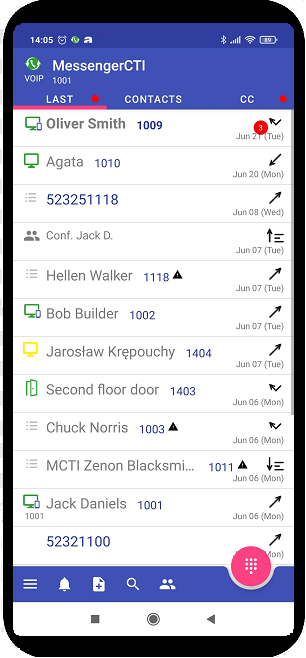
Introduction
MessengerCTI.Mobile Slican Software is mobile application dedicated for Android operating system. It integrates smartphone, computer and subscriber's desk phone. MessengerCTI.Mobile allows users making and receiving calls as PBX subscriber, transferring calls to another subscriber, using contact book, history of calls, conducting chat and text conferences, viewing phone and MessengerCTI status of other subscribers and transferring files. Video image preview function is available for PBX that support DPH.IP doorphones equipped with camera. Application supports calls related to Call Center queues - PBX subscribers/ agents are mobile and independent of their permanent workplace. Functionally, MessengerCTI.Mobile is fully synchronized with MessengerCTI.Desktop, so regardless of version used (mobile, desktop) it always ensures work with up-to-date data.
Application advantages
- handling voice calls in VoIP mode both via GSM operator's Internet network (LTE, HSPA) and WiFi network
- handling voice calls in GSM mode
- chat, text conference and text announcements
- voice conference
- access to contact book with preview of other subscriber's availability status (chat, phone status, description, application)
- creating favorites group
- history of recent calls / chats - sorted chronologically
- full synchronization with MessengerCTI.Desktop application
- logging in as parallel phone to deskphone or as separate MCTI subscriber (only in NCP PBX)
- possibility to copy text from / to chat
- flexible configuration of sound and vibration notifications with possibility of using schedules
- access to configuration of selected PBX services (FWD, DND)
- quick reference numbers for fast call transfer
- ability to set desk phone busy if user's smartphone is busy (enabled by default)
- rejection calls on user's GSM smatphone if deskphone is busy
- ability to use DualSIM smartphones or two phones at same time (business and private)
- convenient door opening in case of calls from DPH.IP doorphone (from application connection window, contact context menu or desktop widget)
- automatic notification delay mechanism MessengerCTI.Mobile if subscriber is active on desk phone or on MessengerCTI.Desktop application
- ability to copy contacts from PBX contact book to local smartphone book
- sharing your own location
- ability to transfer photos and files (drag & drop)
- handy clipboard for sharing data between mobile and desktop application
- support for emoticons
- making calls from external number sources
- available in Google Play store (free)
|
Basic Features
Using smartphone, application user gains mobility and still has option of using PBX as internal subscriber.
VoIP and GSM client
- MessengerCTI.Mobile - parallel telephone, associated with equipment of desk phone (FXS, CTS, SIP). Application can work as VoIP or GSM client. User decides on which device to answer call and make call - by desk phone or smartphone. Novelty is possibility of using application as standalone telephone in NCP (from firmware version 1.11). CTIuserPlus license is required for its correct operation.
- Configuration in VoIP mode - basic configuration for using application. Both calls made and other information, e.g. about the caller's number, contacts in book, subscriber status, chats - are sent over IP network (WiFi, LTE/ HSPA Internet)
- Configuration in GSM mode - it is most often used if access to IP network or Internet in given location is weak (insufficient for VoIP calls) or unstable. All information and signaling - are still sent via IP network (WiFi, LTE / HSPA), but calls themselves are carried out by GSM operator. With poor IP transmission quality, you should take into account that information may not always be displayed.
Switching between VoIP and GSM mode can be done by user from application configuration (if PBX is properly configured).
Phone Book
Big advantage of software is simple and convenient access to contact from phone books and displaying them on computer screen. MessengerCTI.Mobile can use only phone books from PBX. Contacts can be sorted according to user needs. Adding new subscribers and modification of existing entries can be done from CTS system phone or more conveniently, by using computer with MessengerCTI.Desktop or WebCTI. Modification of entry is visible instantly after adding it. Access to phone book allows to simply search numbers of contacts user want to call. On other hand, during incoming calls computer displaying will be showing clear information about calling person.
Call History
User has access to complete history of their calls, picked up and missed one. History is saved on Slican PBX. By using Messenger.CTI history can be displayed alongside information about order, time of calls and number of missed calls from particular number.
CallCenter (NCP PBX)
In conjunction with NCP for Call Center agents, queue handling functionality has been introduced. It allows agents to log in to them, view status, call back lost and abandoned calls, and turn on status of temporary work breaks.
Text messages
By MessengerCTI text information can be sent, from internal messenger (chat) through computer network to another person with MessengerCTI.Desktop or MessengerCTI.Mobile. Chat can be used by all subscribers of given PBX and other PBX linked with eSSL ver.2 system. This functionality is especially attractive for those companies which, having Slican PBXes, do not allow use of public communicators for security reasons. To ensure parallel access from various devices (computer, smartphone), chat history is saved directly in PBX and synchronized with MessengerCTI applications on ongoing basis. An extension of this functionality is possibility of conducting chat with many users simultaneously, i.e. so-called text conference.
Text and voice conferences
Functionality that allows to PBX messages / talk simultaneously with many users
Uploading files
It is possible to send files, e.g. photos, documents, between users of MessengerCTI application (desktop, mobile)
Location sharing
Due to mobility - user can turn on selected people observation of his location. Authorized person gains ability to observe its location.
Using cameras and DPH.IP doorphones
Introduction to sale of DPH.IP doorphones that include cameras allowed to solution that allows display of video from these cameras. Functionality was added with MessengerCTI.Mobile. While connecting to doorphone from software video from camera will appear in new window on computer display. After starting call and next finishing call, even after without talking to person standing beside doorphone, just after visual check user can open door, gate, barrier using dedicated button. Reverse is also true, calling to doorphone or another telephone associated with camera, computer display will show video from their cameras. This allow for temporary observation of neighborhood of installed camera, for example person we are calling. There is also option of watching video from any camera without making call, just using application icon. Thanks to MessengerCTI.Mobile user can preview video from camera of other manufacturers, but those devices have to support video formats, codec compatible with VLC application libraries.
Works with desktop version
Application can be used alongside and synchronized to MessengerCTI.Desktop, that is version for computer with Windows.
Minimum requirements
MessengerCTI.Mobile application is freely available - it can be downloaded from Google Play store..
For installing application minimum requirements must be met:
- Android operating system
- minimum version: Android 6.0 Marshmallow
- minimum recommended version: Nougat 7.0
- PBX and application must have access to internet
Phone with lower version of operating system then 6.0 won't be able to install application.
|
|
Application installation
MessengerCTI.Mobile usage is licensed do purchasing of proper license is required. Purchased serial code is used during PBX configuration, serial code defines number of users that are able to use application. Application licensing doesn't interfere with installation. After installing application, it must be configured for connecting to PBX: Settings --> Account (described below).
During installation, you are prompted to provide some permissions. They may vary depending on Android version and phone type. You can approve all of them or select only those related to functionalities that will be used:
- Camera - for scanning QR code (configuration) and taking and sending photos
- Location - to share your location
- Microphone - for making VoIP calls
- Internal memory - for saving photos, transferring files and using clipboard
- Phone - for using application in GSM mode
- Contacts - for copying contacts to local phone database (used only in some versions of application)
- Displaying above other applications - should be made, available so that you can answer call correctly when application is, for example: deep sleep
- Disable battery optimization - Battery optimization for app must be disabled to prevent it from going into deep sleep
|
Starting application
MessengerCTI.Mobile application runs just like any other application working on Android operating system. During startup application is logging to PBX (according to setting from Settings --> Account tab). After successful login synchronising between application and PBX starts (call history and chat history).
Configuring application
For proper communication between application and PBX, CTI account information and other functions must be configured properly. Configuration menu is placed in bottom left corner of application window. From drop down menu Settings menu can be chosen.
Fields required for configuration can be found here: account, notifications, handy numbers.
Settings
Account
Configured with information configured by PBX administrator:
- Your telephone number: internal subscriber number (extensions) with access to CTI communication
- Password: CTI user password
- Host: port: domain or public IP address of PBX for users outside network or private IP address for users of local network, signaling protocol port: port for communication with PBX - by default TCP 5529
- Transmission encoded: XML Protocol Encryption
- Self-signed certificate
- Read data from QRCode: instead of manual configuration - ability to scan QR code sent from NCP to user's e-mail box when configuring CTI settings or from WebCTI website
- Advanced/Port signaling protocol: communication port PBX - default for PBX is TCP 5529
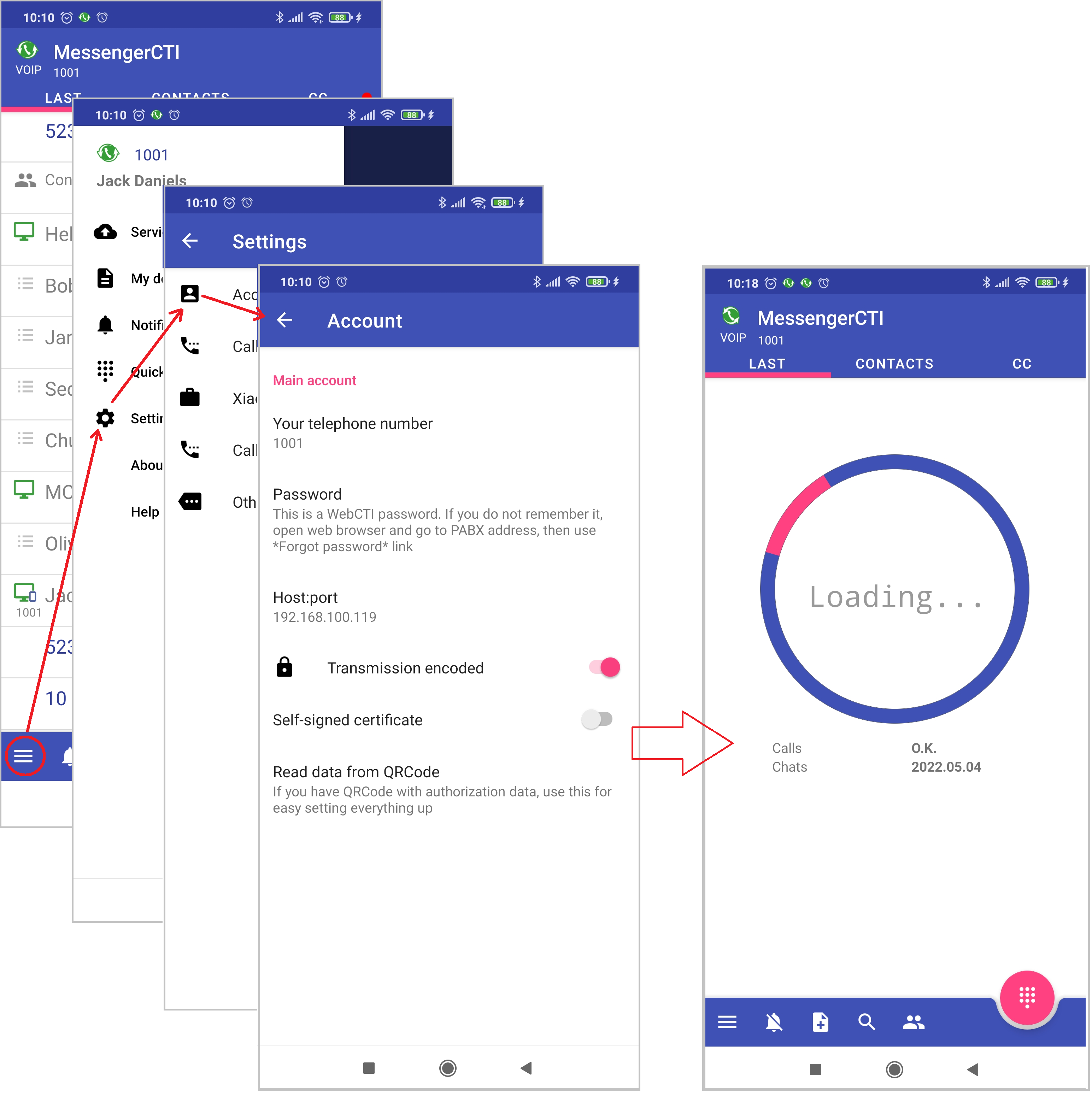
Using QRcode from WebCTI -> My subscriber account or link to code sent to user's e-mail address (only in NCP PBX with properly configured e-mail client)
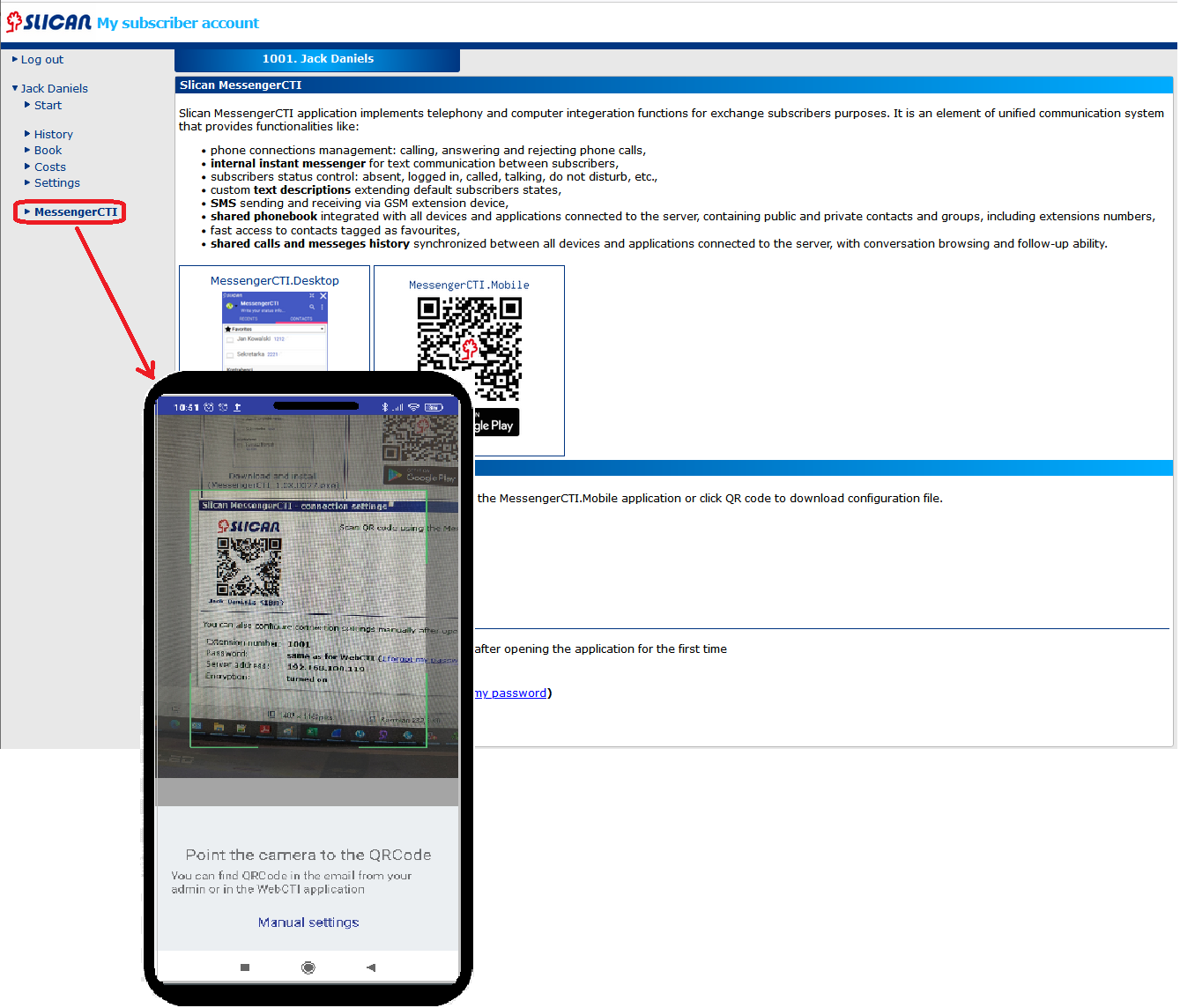
Calls
Options for activating headset button and microphone gain level
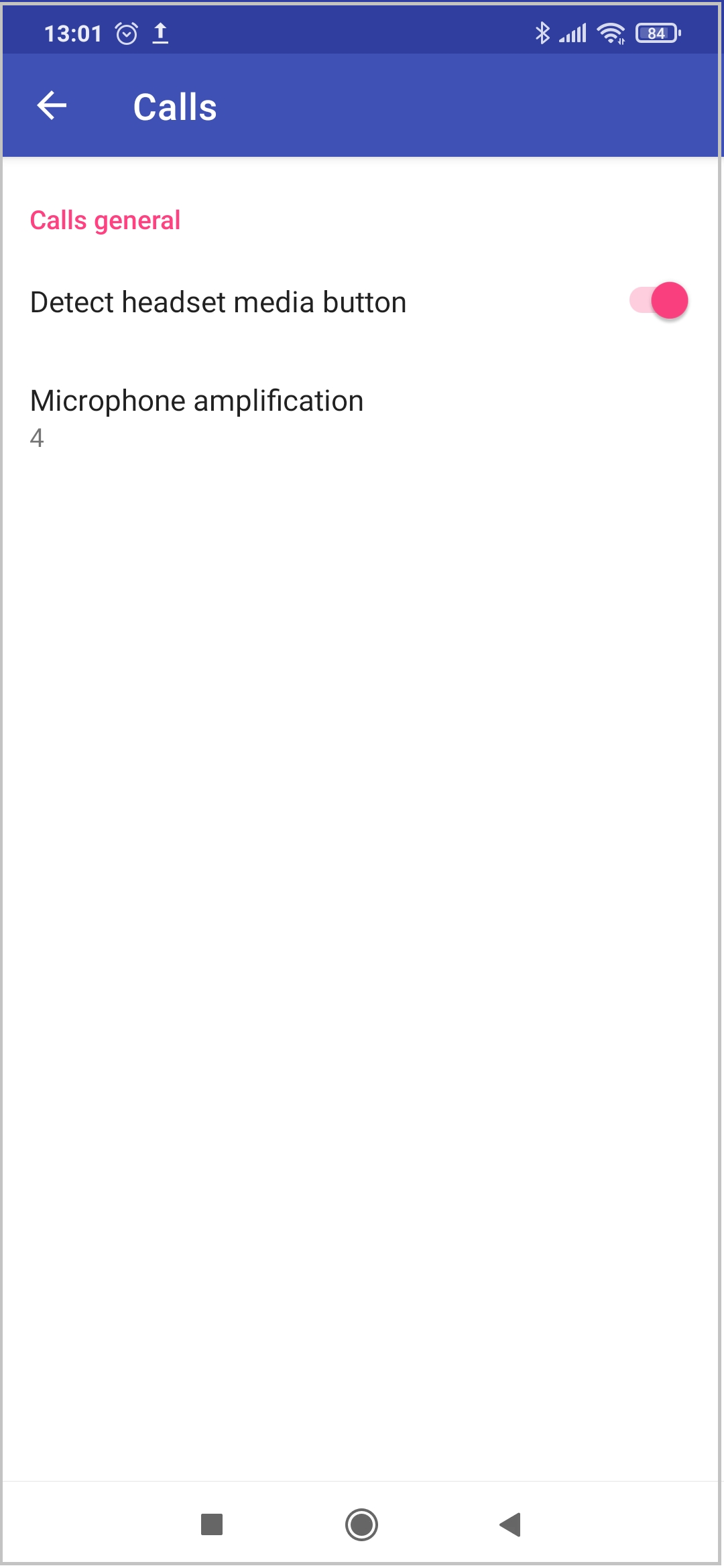
Call Center
Possibility to activate up to 4 login/ logout buttons and agent breaks related to Call Center queues
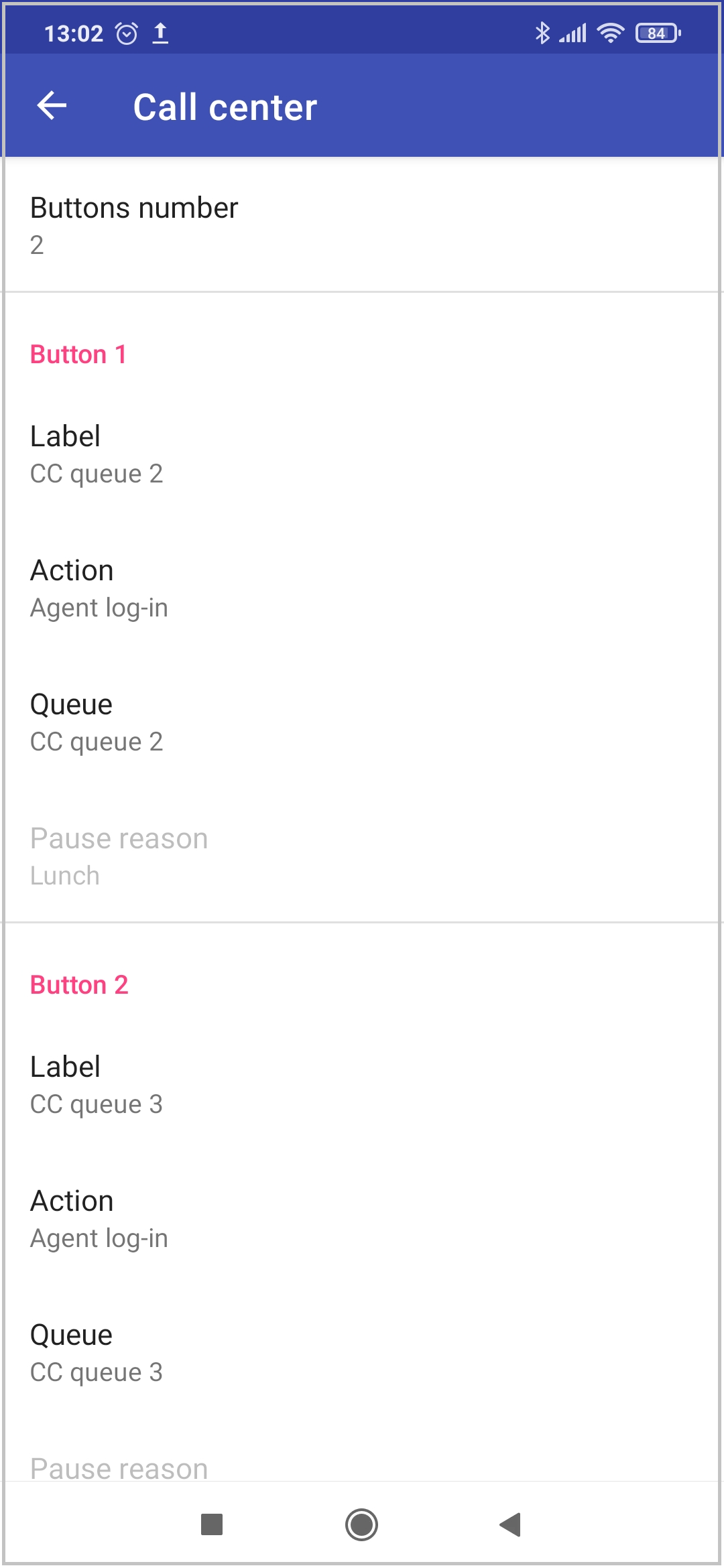
Other
Pozostałe ustawienia aplikacji widoczne są na załączonej grafice.
Debug option - turned on at request of software vendor (Slican) - is related to solving problems with correct operation of application
Enabling option causes that in tab About additional field appears Send logs via email. We choose e-mail client from which we will send application logs for analysis on Slican side.
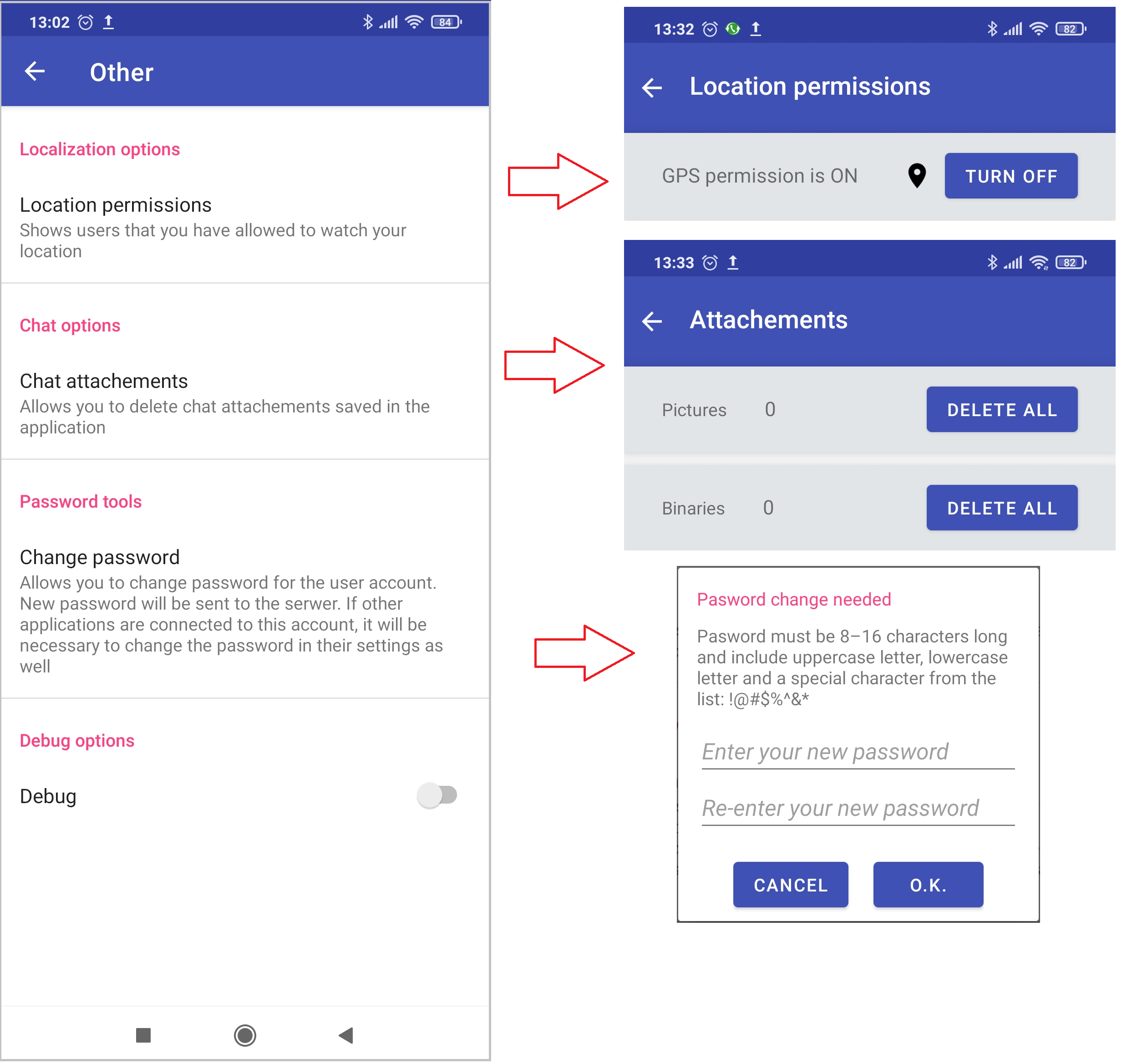
Services
Calls services configuration:
- Default connection type - settings for making calls via GSM, VoIP or VoIP over WiFi
- Global services for PBX:
- DND - do not disturb
- Deskphone is busy when GSM is talking - during call on GSM phone - primary phone (deskphone) and thus MessnegerCTI.mobile application is not supposed to ring during incoming calls (test functionality, it does not work with every GSM phone)
- FWD - call forwarding settings: all, busy or no answer
My desription
Setting your own comment, which will be visible to other users of MessengerCTI application (desktop and mobile) and on screen of CTS-330 system phone
Notifications
Configuring incoming call notifications:
- ringtone: selecting one from list available in application with option to mute it after specified time
- turn off ringing after x seconds - setting optimal length of ringing time
- vibration when ringing
- notification schedule for call ringtone - set weekly active use plan (ringtone in selected time ranges)
Configuring missed calls notifications:
- notify about missed call - if missed call happens, MessengerCTI icon with option to preview message will appear on Android notification bar, in upper part of smartphone screen
Configuring chat message notifications:
- notify about chat messages - enable notifications
- message tone: selecting one from the list available in application
- vibration on message
- notification schedule for chat message - set weekly active use plan (notifications in selected time ranges)
Notifications based on activity on other devices::
Functionality that allows to enable intelligent response to incoming call/notifications of MessengerCTI.mobile application. It introduces 10-second delay notification MessengerCTI.mobile relative to ringing associated phone (usually deskphone).
After starting MessengerCTI.mobile - desk phone and application will ring simultaneously during incoming call. If we answer first to desk phone, application will "remember" that we nearby phone and will delay ringing application during next call.
It ceases to apply when:
- we will not answer call
- we will pick up call with MessengerCTI.Mobie
Quick transfer
List of 3 most important user reference numbers (extensions or outside from PBX) displayed during call for easy call transfer.
About
Information about:
- Own number: PBX ext. number to which application is logged in
- Own comment: subscriber comment
- Current application version
- Type and number of connected PBX
- PBX firmware version
- XML encoding
- Battery optimization
- Privacy policy
- Used libraries
- Link to send application logs
Updating application
Application is updated automatically and user can its course in accordance with settings of automatic updates of given phone application for Google account holders. If new version appears in Google Play Store, newer version will be automatically downloaded or notified.
Application structure
Main window
Main application windows give access to following tabs:
- Last - window related to history of calls and sent messages along with subscriber status in PBX
- Contacts - access to PBX phone book with sorting options: favourites, internal, external.
- CC - handling calls from Call Center queues, possibility to log in/ out and call back
Additionally:
- Application login status icon with default connection type
- Configuration menu - application and service settings
- Silence ringtone - silence ringtone and app notifications immediately
- Clipboard - for sharing files, photos, data between mobile and desktop application
- Search - searching contacts by name and number
- Creating conference
- Keyboard - selection digits of target number
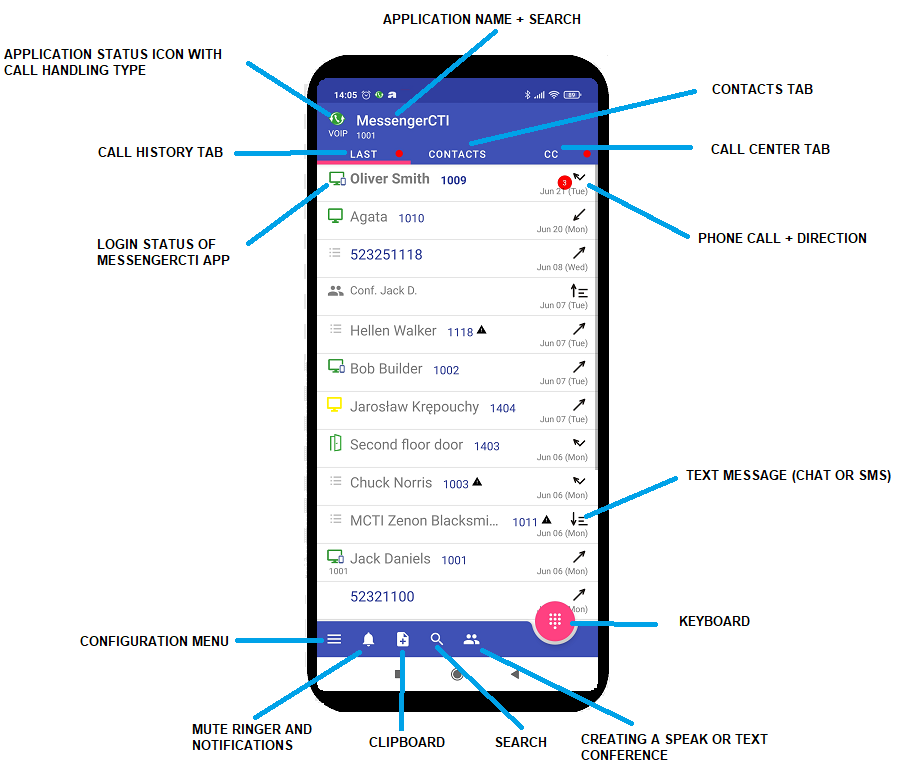
Icons meaning
MessengerCTI.Mobile gives users intuitive preview of telephone status with seperate icon for every contact or call history event. These icons allow to chose action, check call status or inform about error/issues.
Icons and symbols
Application startup window -  - shows history of last calls.
- shows history of last calls.
This view includes following icons:
- on left: application status of MessengerCTI.Mobile user
- right: informing about phone call or message status
Table 1 presents description of meaning of individual icons informing about application status of other MessengerCTI.Desktop/ Mobile users:
- for PBX internal subscribers - icons symbolizing application's login status, touching status icon allows you to start chat or check call history
- for DPH.IP doorphones - current position of door, and by touching icon symbolizing door, you can enter history
- for contacts from outside PBX - checking call history
In case of phones being PBX extensions, icon will show phone status.
| Ikona | Icon meaning |
|---|---|
| number is busy | |
| calling number or making outgoing call | |
| number is not available or faulty | |
| DND service is on |
Table 3 shows meaning of icons displaying calls status:
| Icon | Icon meaning |
|---|---|
| incoming call | |
| outgoing call | |
| new missed call | |
| missed call |
Table 4 shows icons displaying message status:
| Notification | Meaning |
|---|---|
| No connection: check network connection | |
| Wrong login or password: check account settings | |
| App not allowed in PBX: contact PBX administrator |
Table 5: Error icons meaning.
Supporting messages and calls
For call between two users necessary are:
- proper account configuration of application and PBX
- full connection between application and PBX (full data synchronisation of application with PBX) - application icon should have green color
- installed Slican system phone, VoIP or analog phone for IPx, CCT, MAC, NCP PBX or configured MCTI subscriber (only NCP PBX)
Making calls
You can make calls in several ways:
- from Contacts tab - select subscriber from appropriate group (if such in PBX contacts are created) or directly from All contacts group. Call is made by tapping contact and then selecting Dial icon
 from drop-down menu
from drop-down menu - from Last tab - you find from history we are interested in contacting subscriber (we had conversation with him, he called us or made call to him, we sent or received message from him). Call is made by tapping contact and then selecting Dial icon
 from drop-down menu
from drop-down menu - in Search field by entering telephone number or subscriber's name directly from keypad, and then by tapping green receiver on right side
- from numeric keypad opened in lower right corner of Last tab
- from another source of numbers, e.g. website, google calendar
Screenshots presenting different types of connection are below
VoIP mode - basic configuration for using 'application. Both calls made and other information, e.g. about caller's number, contacts, subscriber status, chats - are sent over IP network (WiFi, Internet - HSPA, LTE)
GSM mode - it is most often used if access to IP network or Internet in given location is weak (insufficient for VoIP calls) or unstable. All information and signaling - are still sent via IP network (WiFi, Internet - HSPA, LTE), but calls themselves are carried out by GSM operator. With poor IP transmission quality, you should take into account that information may not always be displayed.
Switching between VoIP and GSM mode can be done by user from application level (if PBX is properly configured).
Presented connection details on smartphone display differ depending on calls setting mode. VoIP call looks different than GSM call due to necessity to use native phone dialer.
Example of outgoing call made in VoIP mode:
Example of outgoing call made in GSM mode:
Incoming calls
Incoming call is signaled visually by pop-up call window and acoustically with bell configured in notification settings. Calls are answered (depending on whether display phone was turned off or not) by moving middle icon towards green handset or by pressing green one. If call is to be rejected, move icon towards red handset or by pressing red one.
We can redirect incoming call to another person. You can do it before answering call or during call (with or without notification):
- immediately - by pressing button with Quick transfer contact, or
- dialing number from list of contacts or recent calls
During call, user can mute microphone and/or turn on speakerphone mode.
Presented connection details on smartphone display differ depending on calls setting mode. VoIP call looks different than GSM call due to necessity to use native phone dialer.
Example of incoming call made in VoIP mode
Connection setup and conversation are carried out entirely via IP network (WiFi or Internet LTE / HSPA)
Example of incoming call made in GSM (Call pickup mode)
This mode is based on following:
- connection for user is incoming connection from Slican PBX (information about connection is sent to smartphone and MessengerCTI application via IP network - WiFi or LTE/HSPA Internet)
- physically, MessengerCTI application initiates outgoing call from user's smartphone to PBX (by GSM provider) and joins connection there, e.g. internal or external
In call pickup mode, application user has more possibilities to manage connection than in parallel calling mode
During call, GSM dialer window with MessengerCTI application "badge" appears.
Example of incoming call made in GSM (Parallel calling mode)
In parallel calling mode, information about caller (via IP network - WiFi, Internet LTE/HSPA) and connection setup (by GSM provider) are initiated in parallel by Slican PBX. During dialing and conversation, GSM dialer window with the MessengerCTI application "badge" appears.
In call history, missed call is symbolized in application with icon ![]() . Going to Last tab or callback call clears information about number of missed calls.
. Going to Last tab or callback call clears information about number of missed calls.
Calls to Call Center queue
Tab -  - allows you to handle calls directed to Call Center queues
- allows you to handle calls directed to Call Center queues
User who is agent of Call Center queue, in CC tab, can program up to 4 individual buttons, e.g. logging in / logging out from selected queue, switching on break.
With button help, user can perform appropriate activities:
- if he is permanently logged in to given queue, button is permanently green at appropriate queue (it does not respond to touch)
- if he logs in / out of queue - he uses appropriate button to log in and out and button changes color from black and white to green
- if he go on break at work - he uses button whose color changes from black - white to yellow
If user belongs to several queues, he can independently, using tabs, switch preview of each of them (status of available agents, number of waiting in queue, list of call-back subscribers)
If user calls back to person displayed in List, he independently decides whether given calls was successful (there are situations when voicemail is reported, called back carries out another conversation, destination subscriber is out of network range, temporarily lacks time, etc.)
Call to Call Center queue is displayed as normal incoming call. If there are unreaded missed calls in tab, a red dot is displayed next to CC tab.
Chat
Application allow to send and receive text messages between MessengerCTI.Desktop/ Mobile application user (internal chat).
To send message, click:
- application status icon
 on left side or message/chat icon on right side of username
on left side or message/chat icon on right side of username - in username and from pop-up menu, select option Chat/History
Receiving new message is signaled by sound signal, information on bar/ in the notification window and appropriate icon next to username in call history.
If user uses both MessengerCTI.Mobile and Desktop versions, history of messages between aplications is synchronized.
Sample message exchange dialog:
You can also use standard emoticons in your messages (including text conferences and text announcements described in section below). By clicking on Type your message field or while typing text, with keyboard activated, special key is available - opening access to emoticons.
Text and voice conference
Conference preparation:
Announcement preparation:
An announcement is specific form of conference. It is used to send information unilaterally to many users, without possibility of interaction on their part.
Preparing announcement is similar to other conferences (text and voice). When creating it, instead of Conference type: Normal we choose Announcement type.
Start conference:
- in case of text conference - go to main application window and LAST tab, then click on created conference
- in case of voice conference - go to main application window and LAST tab, then click on created conference
- in case of advertisement - go to main application window and LAST tab, then click on created advertisement
Edit conference:
- in Participants tab, click

- changes to settings are possible both when the conference is inactive and during its duration
- available actions are shown in the graphic below
Additional features
Uploading files and photos
This functionality is used to exchange files, documents and photos between different users of MessengerCTI application (mobile and desktop)
User in Contacts or Last tab clicks on application status 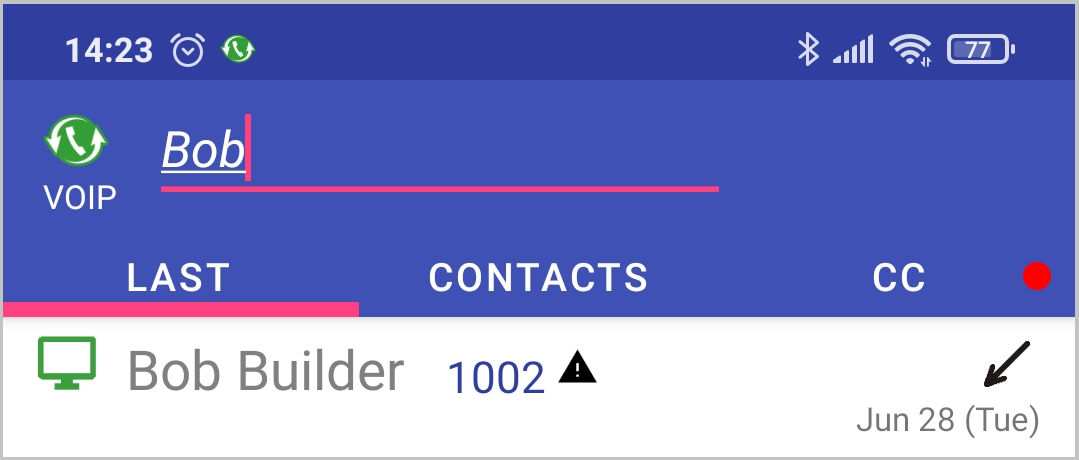 another user, knocks on sign + next to field Type your message, selects one of available options:
another user, knocks on sign + next to field Type your message, selects one of available options:
- Attach file
- Attach picture
- Take a photo
then points to file or takes photo and confirms
Clipboard
Clipboard - it is used to exchange messages, documents and files between Mobile and Desktop versions of user's MessengerCTI application.
To start it, tap icon  and next:
and next:
- in field Type your message type text, or
- tap + next field Type your message and select one of available options:
- Attach file
- Attach picture
- Take a photo
and then select file or take a photo and confirm
Send location
There is possibility to observe location between MessengerCTI.Mobile users (only with consent of person being watched):
- User A asks User B for location permission (he has several variants to choose from)
- User B approves request
- User A receives link to google maps with current location of User B
or:
- User B decides to send location to User A
- User B in Contacts or Last tab clicks on status of User A application, knocks on + sign next to Type your message field and then selects Send location option
- User A receives link to google maps with current location of User B
Contacts
Contacts tab -  - allows to view and perform selected actions related to contact. Contacts can be grouped. Access to numbers from other groups can be obtained by expanding list:
- allows to view and perform selected actions related to contact. Contacts can be grouped. Access to numbers from other groups can be obtained by expanding list:
- Favourites
- All groups
- All contacts
- Internal
- External
- Private
- plus user-created groups
By default, group Favorites is visible
Adding contact to your favorites:
In Contacts tab we hold name of selected subscriber. Confirm when prompted with option Add contact to favorites
Call history
Default tab -  - displays history of calls and messages.
- displays history of calls and messages.
Each entry in tab signifies at least one call or message. If there were more calls (missed) or messages (unread) from same user, his entry is highlighted (bold) and number calls/messages is displayed in as red dot next to relevant icon.
Each field shows (from left):
- application status icon, icon that user is not using application or door station status
- name (if saved in phonebook)
- caller number
- icon indicating phone call or text message
- date or time when call was made
If tab contains unread missed calls or unread messages, red dot is displayed next to Last . From tab it is possible to call back or send back messages. By tapping on username, we go to detailed history of calls and messages.
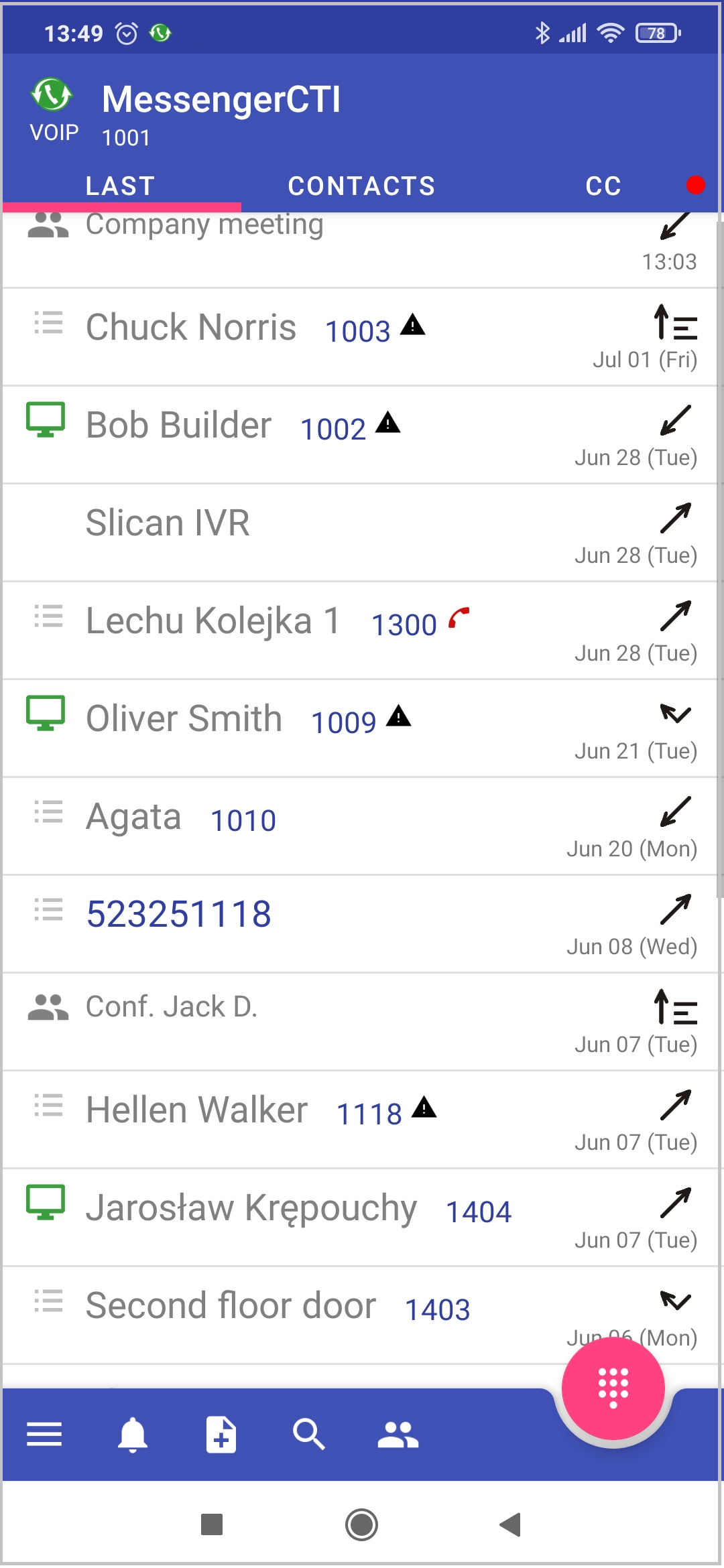
Configuring Slican PBX
For proper communication between application and PBX are required:
- correct manufacturer license
- specific PBX configuration
IPx, CCT PBX configuration
With ConfigMan software:
- Inside Global settings->Global settings/Remain tab:
- ANo:configure access number that application will chose for making call to PBX and setting up incoming call
- Adr: public host name or PBX IP address for connecting to application (for VoIP calls with application)
- Inside Subscribers menu, Tables then Subscribers->Subscribers/CTI settings:
- AwdMbl: allow access to MessengerCTI.Mobile application
- AwdGSM: allows to connect phone calls through GSM network
- IncC: setting up method of how application connects incoming calls:
- Call pickup - picking up incoming call with application means making outgoing call with GSM phone to number from ANo field inside Global settings/Remain
- Parrallel calling - incoming calls to GSM phone from number set in ANo field inside Global settings/Remain
- MnNo: configure GSM phone access number, on which application is installed, optionally configure second number (for dual SIM phones)
- SecNo: second GSM phone number with installed application (optional, for dual SIM phones)
For application to work with each settings, these fields parameters must be set:
- VoIP network: 1.2, 2.1
- GSM network: 1.1, 2.1, 2.2, 2.3, 2.3.1 or 2.3.2, 2.4 (plus possibly 2.5)
Minimum PBX firmware version - 6.53, for VoIP - 6.54
NCP PBX configuration
From ConfigWEB application:
- Extensions/ Settings->Informations about CTI settings for subscribers and applications menu, configure:
- Public host name or PBX IP address for XML Slican protocol - domain name or IP address for exchanging/synchronisation information and data between application and PBX
- Public host name or PBX IP address for VoIP calls - domain name or IP address for configuring VoIP calls
- PBX number for GSM calls - which will call GSM phone with installed application to call PBX or PBX to application and set up call (in configuration with support for connections via GSM network)
- configure subscribers for SIP, FXS, CTS, MCTI with Extensions/Subscribers-> Subscriber/CTI Settings/MessengerCTI.Mobile
- Allow access to MessengerCTI.Mobile application
- if using GSM network allow phone calls handling using GSM
- set up GSM phone access number for device with installed application
- set up second GSM phone number with installed applicatio (optional, for dual SIM devices)
- set up incoming calls handling
- call pickup - picking up incoming call with application is achievied by GSM phone making outgoing call to number set in Extensions/ Settings/ Informations about CTI settings for subscribers and applications/ Phone number to call this PABX using GSM connection
- Parallel calling - incoming call to GSM phone from number set with Extensions/ Settings/ Informations about CTI settings for subscribers and applications/ Phone number to call this PABX using GSM connection
For application to work, these fields must be set:
- VoIP: 1.1, 1.2, 2.1
- GSM: 1.1, 1.3, 2.1, 2.2, 2.2.1, 2.2.2, 2.3 and 2.3.1 or 2.3.2
Minimum PBX firmware version - 1.11, for VoIP - 1.12
Ports and protocols
Default port numbers and protocol types used by PBX for purposes of providing selected services of MessengerCTI.Mobile application.
Basic:
- signalization
- 5529 TCP - application signaling (XML)
- 5543 TCP - signaling in enabled encryption tag mode (XML)
- VoIP calls
- 5060 UDP - SIP signaling (for VoIP calls)
- 8100 - 8300 UDP - acoustic - for IPx, CCT, MAC PBX
- 10000 - 20000 UDP - acoustic - for NCP PBX
Additional:
- file transfer - only NCP (clipboard, between users):
- 443 TCP - file transfer without encryption tag enabled (transmission is still HTTPS encrypted)
- 5543 TCP - file transfer of files with encryption tag enabled
- image transmission from DPH.IP doorphone camera
- link to camera in PBX location of:
- NCP: Extensions/Devices/Cameras
- IPx, MAC, CCT: Pheripherals/Cameras
- During a call, PBX sends camera link to application MessengerCTI: rtsp://IP_address_camera:554/login_password_additional_information
- link to camera in PBX location of:
Example for NCP for MessengerCTI working from outside NCP IP network (configuration in ConfigWEB):
- XML signaling, VoIP, file transfer - Extensions/Settings/Informations about CTI settings for subscribers and applications tab
- image transmission from camera (camera link, camera link to DPH.IP) - Extensions/Devices/Cameras tab
Sample configuration data:
- PBX IP address: 192.168.0.10
- router public IP address: 222.0.0.1
- domain address: company_name.com
- camera IP address: 192.168.0.20
- ports used to redirect individual services on router: 55xx
XML signaling:
- MessengerCTI --> router --> NCP
- MessengerCTI --> 222.0.0.1:5555 --> 192.168.0.10:5529, or
- MessengerCTI --> company_name.com:5555 --> 192.168.0.10:5529
XML signaling with encryption tag enabled:
- MessengerCTI --> 222.0.0.1:5558 --> 192.168.0.10:5543, or
- MessengerCTI --> company_name.com:5558 --> 192.168.0.10:5543
VoIP calls (signaling)
- MessengerCTI --> 222.0.0.1:5556 --> 192.168.0.10:5060, or
- MessengerCTI --> company_name.com:5556 --> 192.168.0.10:5060
VoIP calls (acoustic)
- MessengerCTI --> 222.0.0.1:10000 - 222.0.0.1:20000 --> 192.168.0.10:10000 - 192.168.0.10:20000, or
- MessengerCTI --> company_name.com:10000 - company_name.com:20000 --> 192.168.0.10:10000 - 192.168.0.10:20000
File transfer:
- MessengerCTI --> 222.0.0.1:5557 --> 192.168.0.10:443, or
- MessengerCTI --> company_name.com:5557 --> 192.168.0.10:443
File transfer with encryption tag enabled:
- MessengerCTI --> 222.0.0.1:5559 --> 192.168.0.10:5543, or
- MessengerCTI --> company_name.com:5559 --> 192.168.0.10:5543
Image transmission from DPH.IP camera
- MessengerCTI --> ruter --> camera
- MessengerCTI --> 222.0.0.1:5560 --> 192.168.0.20:554, or
- MessengerCTI --> company_name.com:5560 --> 192.168.0.20:554
Operation in local network and outside local network without changing MessengerCTI configuration
If MessengerCTI.desktop or MessengerCTI.mobile application user is on move, his IP network source may change (np. LAN <--> Internet LTE, HSPA <--> LAN, work <--> travel <--> home) it may results need to change application configuration, i.e. change IP address of PBX from local to public or vice versa (situation does not take place if user uses LTE/HSPA internet only)
In order to simplify operation and configuration of MessengerCTI application, you can use functionality offered by many network routers.
It allows device with MessengerCTI (notebook, smartphone) to connect to PBX, regardless of whether it is in local network (LAN, WiFi) or outside it (other sub-networks, Internet, GSM-LTE). In routers, this functionality is called NAT hairpinning, NAT loopback or NAT reflection. It enables access to service via public IP address, regardless of range of network user is currently in.
Sample network:
- router's public address (router's WAN): decimal address - 203.0.113.1 or domain address - voip.xxxxxx.com
- router's local address (router's LAN, gateway): 192.168.1.1
- PBX address (NCP, IPx, MAC, CCT) in LAN network: 192.168.1.2
- user's notebook address with MessengerCTI.Desktop or smartphone with MessengerCTI.Mobile in LAN: 192.168.1.100
If MessengerCTI from notebook/ smartphone from local network - IP address 192.168.1.100 - send packets to public address 203.0.113.1 (voip.xxxxxx.com), packets are routed to default gateway - 192.168.1.1 (router) by default. NAT hairpinning router detects that 203.0.113.1 (voip.xxxxxx.com) is address of its WAN interface and treats packets as if it were coming to that interface. Determines destination for those packets based on DNAT (port forwarding) rules. If packets have been sent to port 5529 (for VoIP: 5060, 8100-8300 for IPx, 10,000 - 20,000 for NCP) and there is DNAT rule for this port directed to 192.168.1.2, then PBX receives packets at this address.
If appropriate DNAT rules exist, address translation is performed - router rewrites source local IP address in packets to public address. Notebook/ smartphone (192.168.1.100) sends packets, and PBX (192.168.1.2) receives it as coming from 203.0.113.1. When PBX responds, process is same as for notebook/ smartphone. In this way, two-way communication between notebook/ smartphone in LAN via public IP address is possible.
Use cases examples
MessengerCTI.Mobile application is useful tool for companies that employ mobile workers which requires constant access to phone with internal number of phone system.
These employees can be a good example:
- sales department - working in different locations, office <-> outside office
- service support - constant fieldwork
- remote worker - remote work
- mobile worker - working on vast area(production halls, vast areas) -where Wifi or DECT network range won't be adequate
Installing beta version
"Beta" version contains new functionalities which will be added in next production version but not all of planned functions are implemented. This version also cointains fixes for error submited for earlier versions. It was initialy tested.
Becoming beta tester and installing "BETA" version of MessengerCTI.mobile application can be done via Play Store application or by activating appropriate link on ServNET server:
- Activating access to BETA app from Play Store app:
- run and log in to

- in application search field enter slican messengercti
- click on name of MessengerCTI application, after opening new one, find text Join the beta testing program, click on appropriate field
- after a while, MessengerCTI (beta) description and Update button will appear
- Activation of access to BETA application from ServNET server or http link:
In this case:
- log in from your computer or phone browser to your Google account. If you have more than one Google account, it's important to sign in to the account that's set up on your phone
- log in to server ServNET and select link associated with description of MessengerCTI.Mobile (beta version), or
- click following link: Beta Registration
On www page you will see the following information:
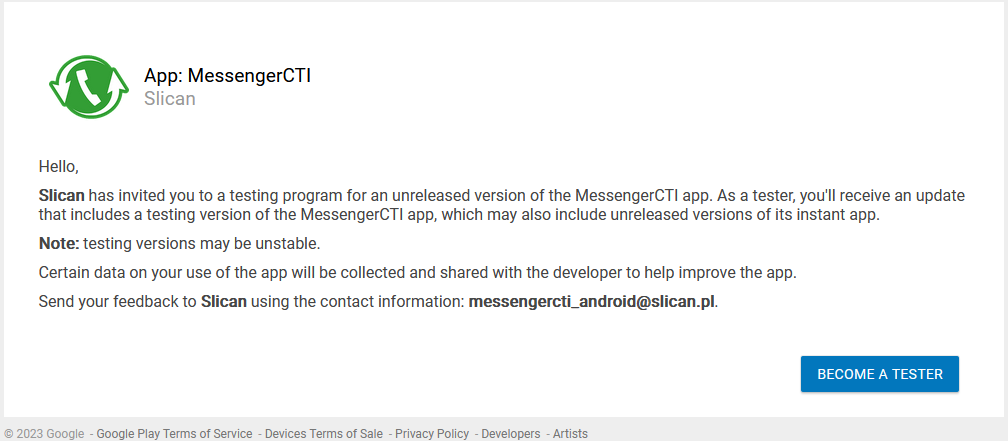
Click button BECOME A TESTER to sign up for testing
Going back to phone configuration:
- because Google Play updates can be delayed, it is recommend to turn of Play Store application before installing MessengerCTI
- clicking on shortcut will start Play Store again. Search for MessengerCTI application. It is recommended due to the large number of available Messenger' applications, it is worth adding the name Slican to the search
- install upgrade application
- configure according to manual
We're excited about new features that are only available to select person.
